Patch News – September 2018
It’s autumn time again and September gave us a mix of some really lovely and some really terrible weather, but I suppose that’s what we should expect in autumn. The patch is getting better and better, it was mown regularly in September but it shouldn’t need many more cuts this year. I snapped this shot of Dougal Entendre, Norwegian Nick, and Woody all trying to stay awake while waiting for Captain Slow to finish one row with the mower. Farmer George moved the bullocks out early in the month so we haven’t had any problems with them but he’s recently said that they will be back shortly. Stop press: 26th Sept – bad news they’re back!
Farmer George moved the bullocks out early in the month so we haven’t had any problems with them but he’s recently said that they will be back shortly. Stop press: 26th Sept – bad news they’re back!
We were walking back to the cars after flying one midweek morning when we heard the distinctive sound of a Chinook. It sounded close but we couldn’t see it at first. The sound grew louder and louder and we suddenly spotted it. We’d made the foolish mistake of looking upwards but it was actually below us, down in the valley south of the field! It had climbed a bit by the time I got my phone out to take this photo: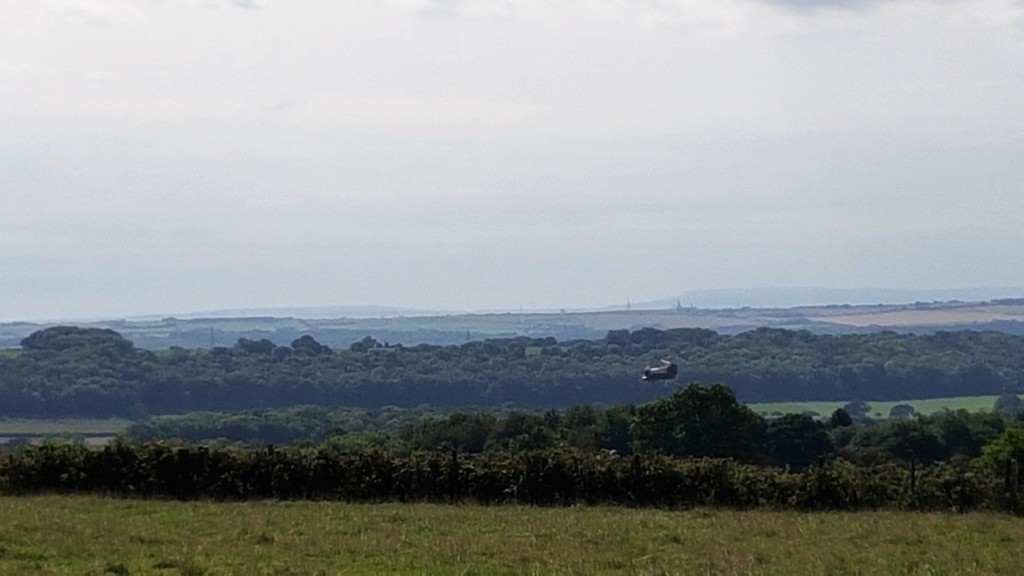 It went eastward, not over the field, but it was scarily low and could just as easily flown right over the patch. We enjoyed seeing it and I know we are always careful but it does serve as a warning to be extra vigilant if we hear a full-size aircraft heading our way. I managed to take a short snip of video which I’ll include in this month’s video.
It went eastward, not over the field, but it was scarily low and could just as easily flown right over the patch. We enjoyed seeing it and I know we are always careful but it does serve as a warning to be extra vigilant if we hear a full-size aircraft heading our way. I managed to take a short snip of video which I’ll include in this month’s video.
Last month I featured Dougal Entendre’s new Freewing Moray that had suffered some damage when it crashed on just its’ second flight. Dougal had climbed to height to check out the stall but having stalled the model inexplicably failed to recover. Well Dougal is now pretty sure he has found the problem, an overheating speed controller. He says the model felt down on power as it was climbing so it seems likely the controller was overheating and when the model stalled there was little or no power to recover. Dougal sent me a photo of the offending controller, explaining that this was how it came out of the model, he hasn’t cut the heat shrink afterwards.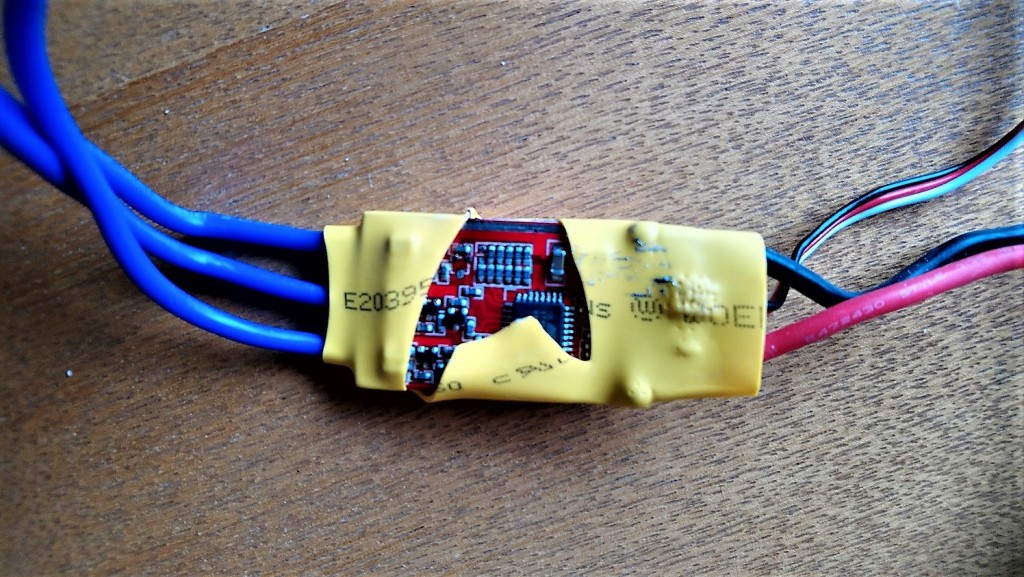 He also confessed “That’s the last time I buy a sub-£5 40A (supposedly) ESC on eBay”.
He also confessed “That’s the last time I buy a sub-£5 40A (supposedly) ESC on eBay”.
A couple of months ago I pictured Norwegian Nick with his new EDF Hawk which looked great but didn’t have enough thrust to fly. Nick was using a 12 bladed ChangeSun fan and a 3 cell lipo pack and the consensus was that 3 cells weren’t enough to drive the ChangeSun fan, so he swapped it out for a 5 bladed Lander fan.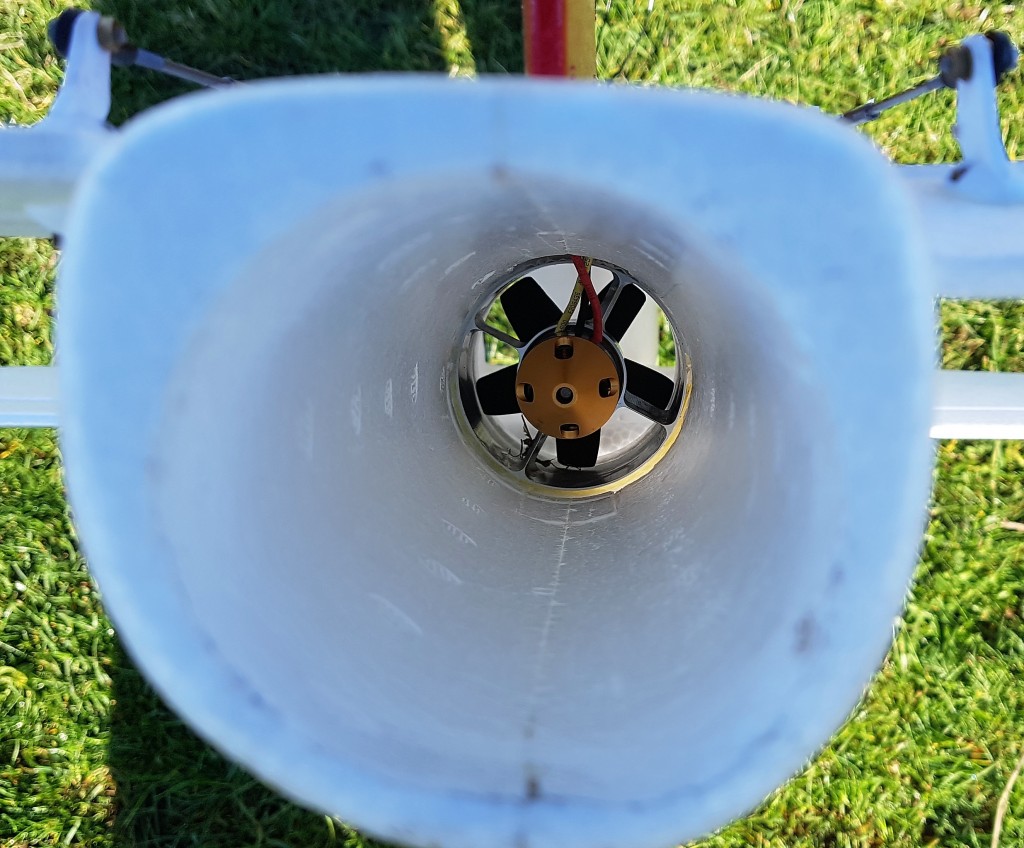
 He’s now using a 4 cell lipo and a 4000KV motor which flies it beautifully as you can see in this month’s video.
He’s now using a 4 cell lipo and a 4000KV motor which flies it beautifully as you can see in this month’s video.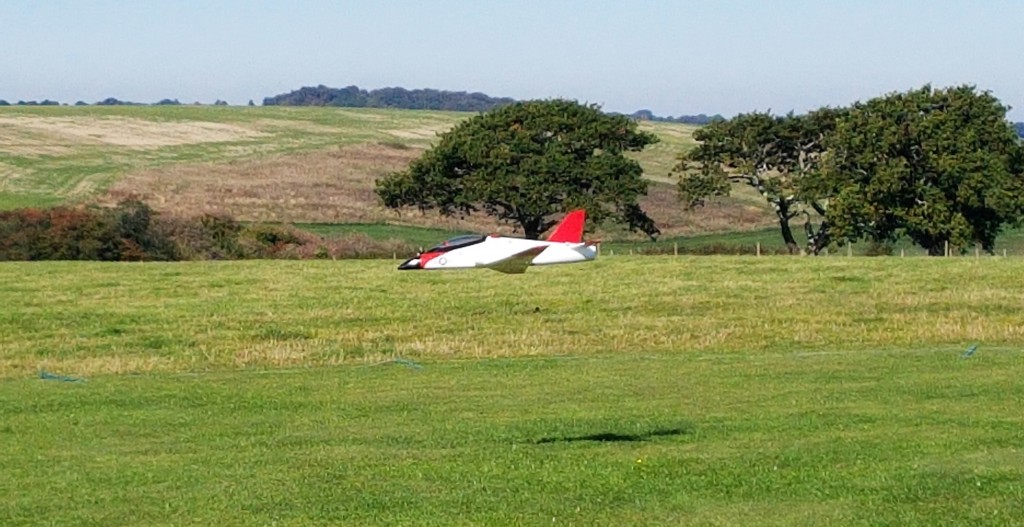 Nick currently only has one 4 cell pack so needs to raid the piggy bank to get more than one flight per patch visit.
Nick currently only has one 4 cell pack so needs to raid the piggy bank to get more than one flight per patch visit.
Nick has also built a new Depron flying wing type model called E-Shark from the designer Graham Dorschell. It was free plan in RC Model World and this is what the Traplet website says about it: This is a simple sports or slope (using a folding prop) 41 in. span model design by Graham Dorschell built up from 5mm Depron using the ‘folding wing’ method, with some balsa and Correx board and using basic tools with two 9g servos for delta mix. With just a few parts to cut it turns into a quick model to fly with a 35mm 1500kv brushless motor, 60 Amp ESC, 8″ x 6″ prop and a 3S 2200-3000 mAh lipo.
It was free plan in RC Model World and this is what the Traplet website says about it: This is a simple sports or slope (using a folding prop) 41 in. span model design by Graham Dorschell built up from 5mm Depron using the ‘folding wing’ method, with some balsa and Correx board and using basic tools with two 9g servos for delta mix. With just a few parts to cut it turns into a quick model to fly with a 35mm 1500kv brushless motor, 60 Amp ESC, 8″ x 6″ prop and a 3S 2200-3000 mAh lipo.
Norwegian Nick has fitted his with a 3536 1400kv outrunner motor, a 60 amp esc, and is using an 8×6 prop.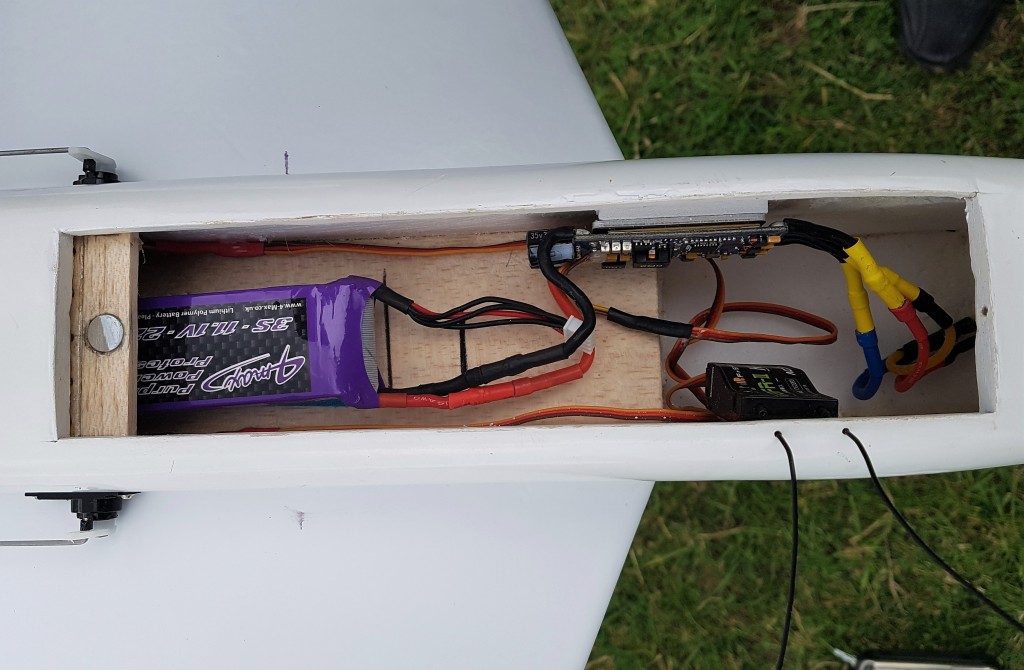
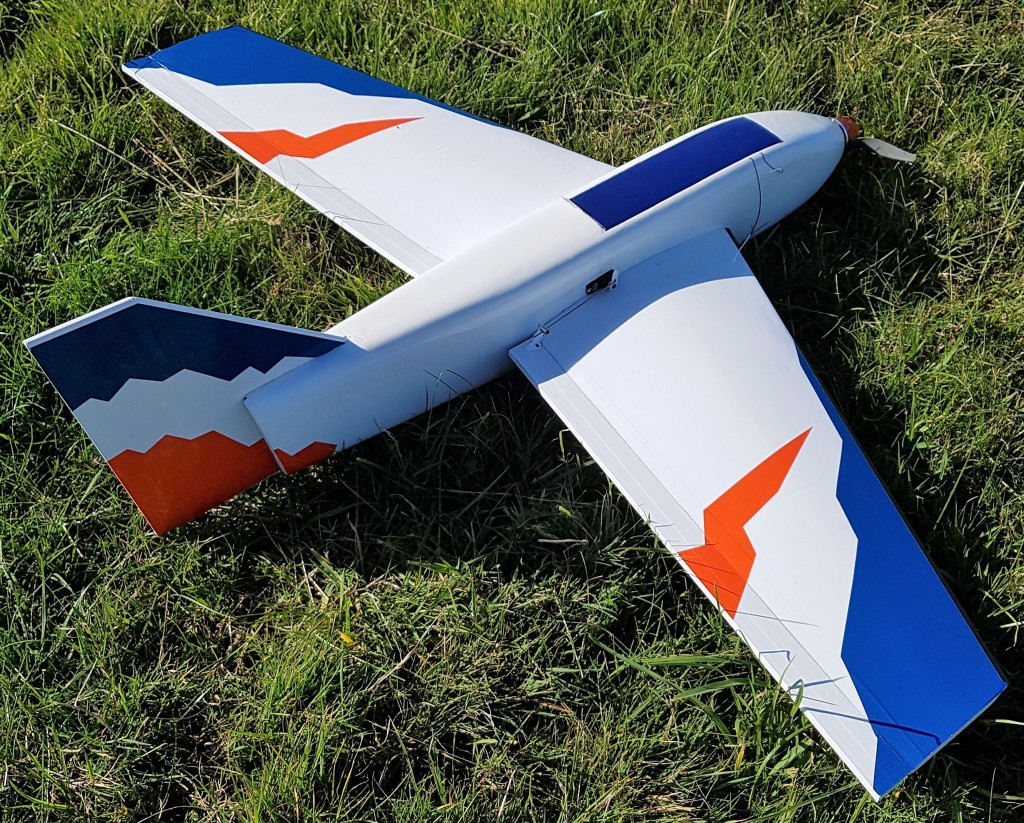 It flies extremely well on a 3 cell 2700 lipo, only requiring around third throttle for stooging around so the flight times should be long. It failed to climb away from the first launch but then Nick realised the elevons were slightly down with the stick centred so he adjusted those and it went away beautifully from the second launch. I took some video of the E-Shark that you’ll be able to see in the next edition of Patch News.
It flies extremely well on a 3 cell 2700 lipo, only requiring around third throttle for stooging around so the flight times should be long. It failed to climb away from the first launch but then Nick realised the elevons were slightly down with the stick centred so he adjusted those and it went away beautifully from the second launch. I took some video of the E-Shark that you’ll be able to see in the next edition of Patch News.
There seem to have been some very strange fashions on the PAM catwalk at the field recently. Last month I pictured Woody’s refurbished Seagull Swift in its’ new Blue Angels colour scheme and this month I snapped the man himself with the model… ‘Built the model, bought the T-shirt’!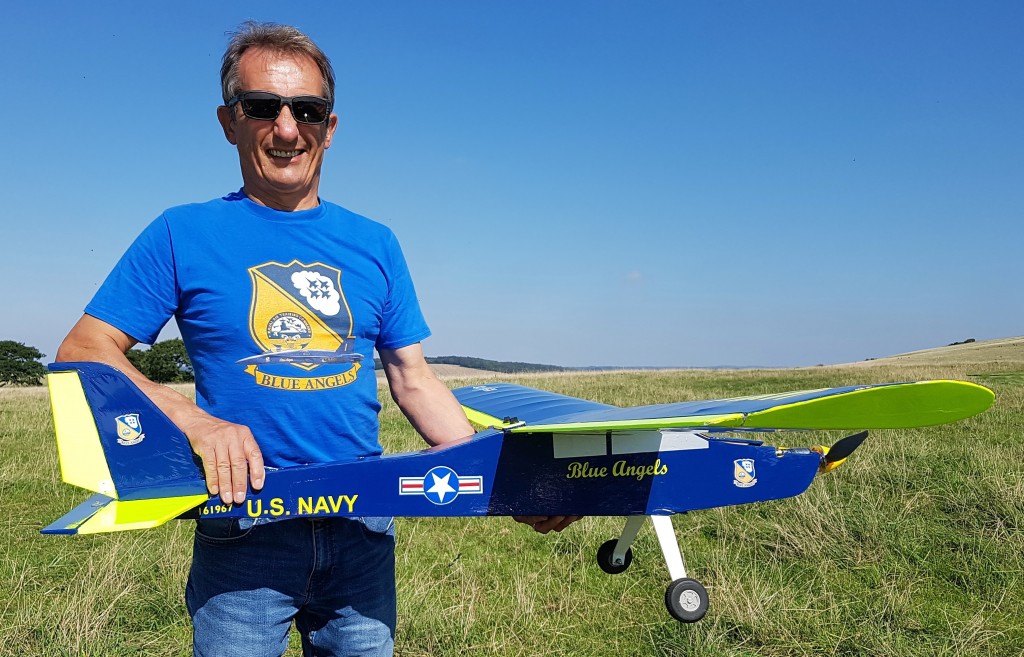 Whilst Woody’s T-shirt is understandable some other fashion statements on the PAM catwalk are less so, here we have Dwayne Pipe modelling a rather snazzy pink bin liner that is usually reserved for carrying his crashed models.
Whilst Woody’s T-shirt is understandable some other fashion statements on the PAM catwalk are less so, here we have Dwayne Pipe modelling a rather snazzy pink bin liner that is usually reserved for carrying his crashed models. And Captain Slow (AKA Billy No Mates), feeling rather lonely, tried his “I’m hoping to become a Freemason” look!
And Captain Slow (AKA Billy No Mates), feeling rather lonely, tried his “I’m hoping to become a Freemason” look!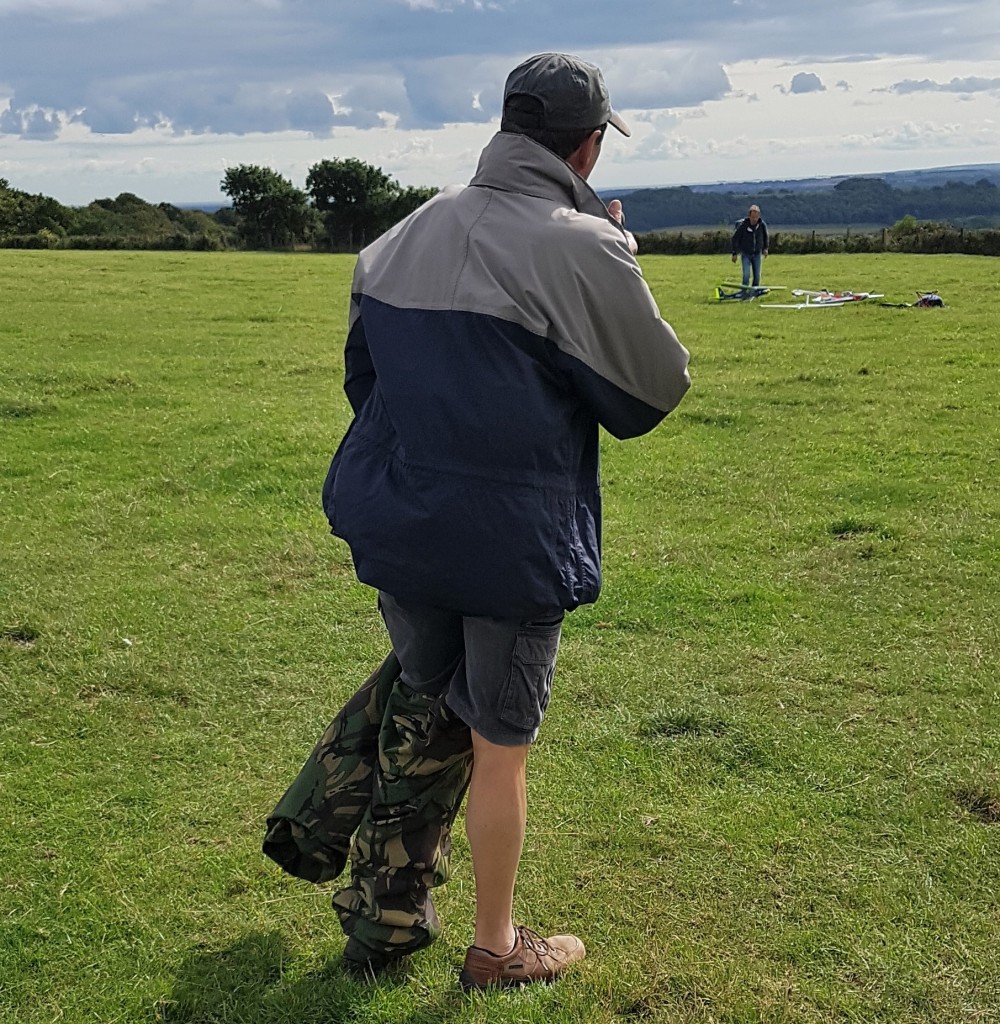 At least they made the effort and got to the field, 1066 just stayed at home and napped on the couch.
At least they made the effort and got to the field, 1066 just stayed at home and napped on the couch. Perhaps I should explain that he’s had an operation for a torn retina…ouch! I bet he’s really pleased that his wife Jen put the photo on Facebook for me to copy. Not sure what that odd lump on his head is though, maybe Jen clouted him for being so lazy! But don’t worry, he’s fine now and back flying again.
Perhaps I should explain that he’s had an operation for a torn retina…ouch! I bet he’s really pleased that his wife Jen put the photo on Facebook for me to copy. Not sure what that odd lump on his head is though, maybe Jen clouted him for being so lazy! But don’t worry, he’s fine now and back flying again.
New members Nick and Matt are continuing their trend of having almost identical models! This month they both bought Sbach 342s but they aren’t the same, Nick’s is manufactured by Dynam and Matt’s is from HobbyKing.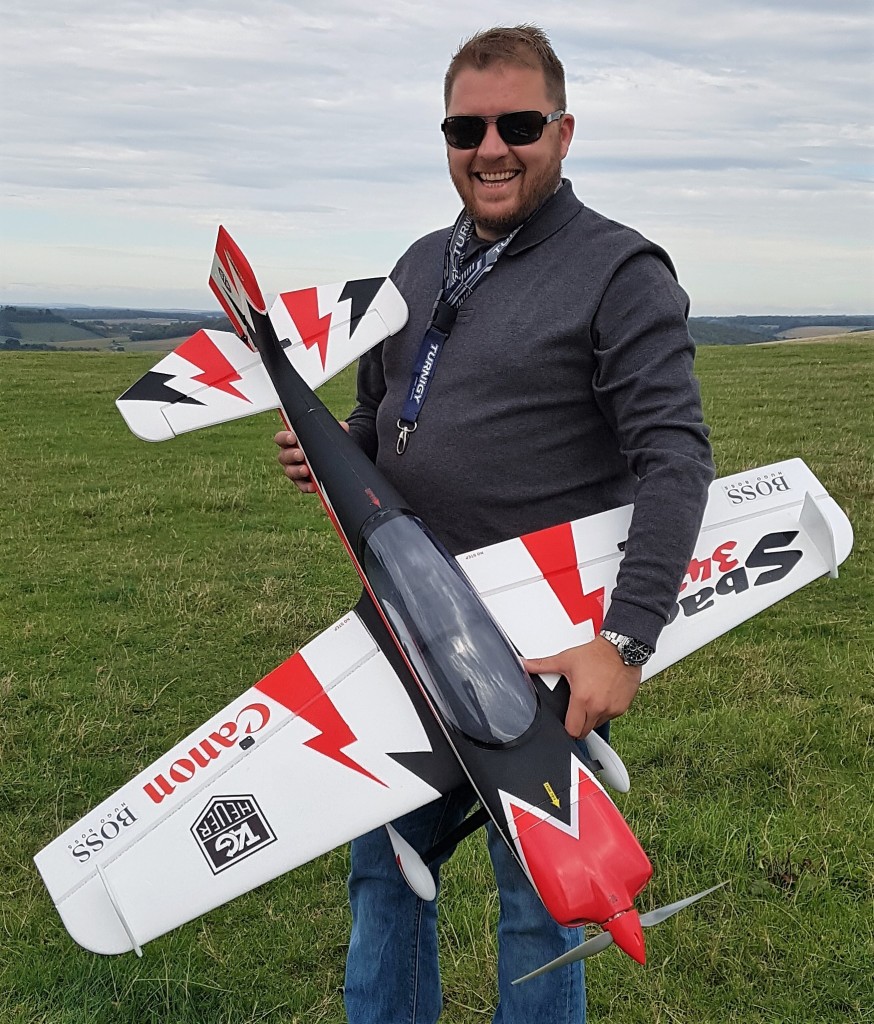
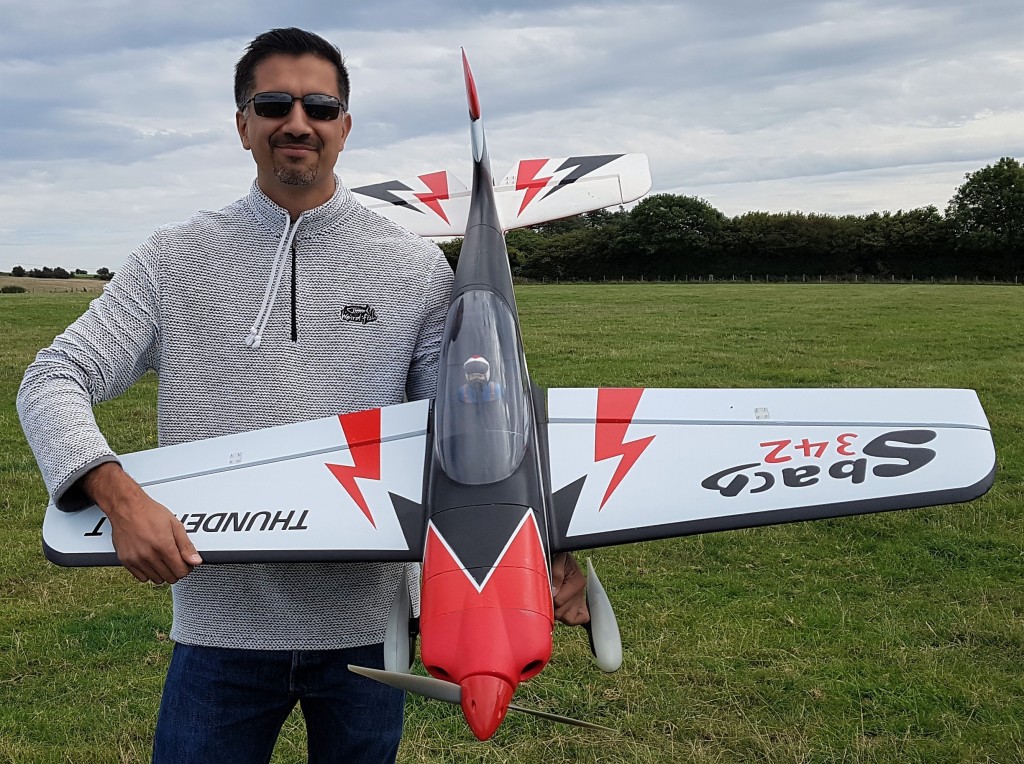 First, a bit about the full size: The Sbach 342 is a two seater unlimited aircraft manufactured by XtremeAir GmbH, it’s the first ever certified all composite aerobatic aircraft. The lightweight aircraft features the solid Lycoming 6 cylinder air cooled motor and massive control surfaces to provide it with the low speed aerobatic handling needed in the most advanced and testing aerobatic schedules.
First, a bit about the full size: The Sbach 342 is a two seater unlimited aircraft manufactured by XtremeAir GmbH, it’s the first ever certified all composite aerobatic aircraft. The lightweight aircraft features the solid Lycoming 6 cylinder air cooled motor and massive control surfaces to provide it with the low speed aerobatic handling needed in the most advanced and testing aerobatic schedules.
This is what Dynam say about Nick’s model: Straight out of the box you will find that this Dynam Sbach 342 model is lightweight, rigid and features a fabulous showroom finish using quality paint and decals that will look great at the airfield and in the air. Efficient and affordable power supply is guaranteed with the pre-installed quality ESC (with ample reserve capacity) and oversized 900kv brushless motor, driving a reinforced two blade nylon propeller will readily translate into an impressive flight envelope. Knife edge loops, 1 roll circles, flat spins, harrier loops, snaps, point rolls and prop hanging are performed with accuracy and grace that belie its compact 1250 mm span. Dynam have chosen an exceptional aircraft to replicate; they have delivered a lightweight EPO foam airframe in a quality finished, classic bold colour scheme and provided a near perfect power-train partnership. In short, it’s a model that can proudly and deservingly display the Sbach 342 badging.
So there you have it, we shall expect to see Nick performing knife edge loops, one roll circles etc. every Sunday… Nick is using 4 cell 2900mAh lipos and the model had loads of power. You will see in the video that it appeared to have a slightly rearward centre of gravity but other than that it looked really good, a promising start.
Nick is using 4 cell 2900mAh lipos and the model had loads of power. You will see in the video that it appeared to have a slightly rearward centre of gravity but other than that it looked really good, a promising start.
I think Matt said he bought his HobbyKing Sbach second-hand from someone on Hayling Island. HobbyKing say this about it: The Sbach 342 is made from tough EPO foam, it is a really quick and simple build that requires no glue, the tail plane simply bolts on and the 2pc wings are a plug in set up, also ideal for transportation. The servos are pre-installed, the elevator/rudder servo’s being standard size with plenty of torque for aggressive 3D manoeuvers. Also pre-installed is the powerful brushless motor and ESC, for maximum performance and efficiency, a 2 blade prop is supplied. This fantastic looking Sbach 342 offers both the 3D pilot and sport pilot a very capable model with tons of performance and a whole load of presence, the large control surfaces are perfect for just about any manoeuver you care to throw at it. This superb Sbach 342 will keep you grinning from ear to ear, just make sure you have plenty of lipos to hand, prop hanging the Sbach is addictive!
According to the specs the wingspan and length are both 1400mm and the flying weight is around 2.3kg. Being second-hand I’m not sure if Matt’s has the standard set-up but it should have a 4250 800kv motor, a 70A speed controller and two standard size servos on the elevator and rudder plus two 9g servos for the ailerons. Matt is using 4 cell 5000mAh lipos so his model should have had a similar performance to Nick’s but it didn’t, vertical performance was very poor for a 3D style model. It has a lower kV motor so will need a larger prop than Nick’s model but in fact it had the same diameter but a lower pitch. So the next stage is a larger prop or maybe more cells. Other than the lack of performance the Sbach looked good and I’m sure Matt will soon have it performing well.
Matt is using 4 cell 5000mAh lipos so his model should have had a similar performance to Nick’s but it didn’t, vertical performance was very poor for a 3D style model. It has a lower kV motor so will need a larger prop than Nick’s model but in fact it had the same diameter but a lower pitch. So the next stage is a larger prop or maybe more cells. Other than the lack of performance the Sbach looked good and I’m sure Matt will soon have it performing well.
Dougal and 1066 are both happy flying low inverted and also both competitive so it was easy to wind them up with shouts of ‘Lower’ at every pass. I snapped a photo of each of them, not at their lowest points but you get the idea.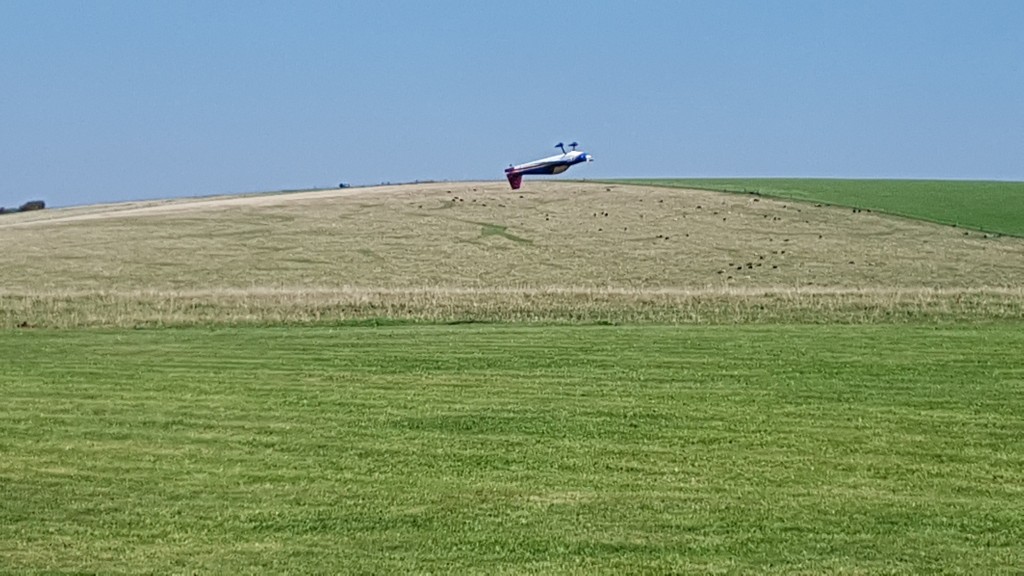
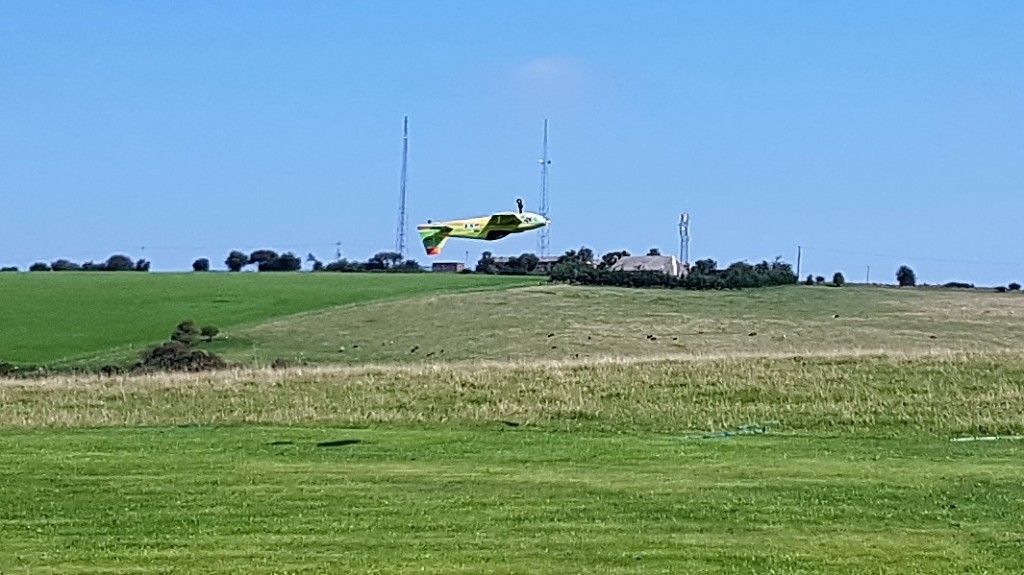 On this occasion I think 1066 came out on top…or should that be underneath???
On this occasion I think 1066 came out on top…or should that be underneath???
Chris P Bacon was getting to grips with his new Ripmax Bolero during September when disaster struck.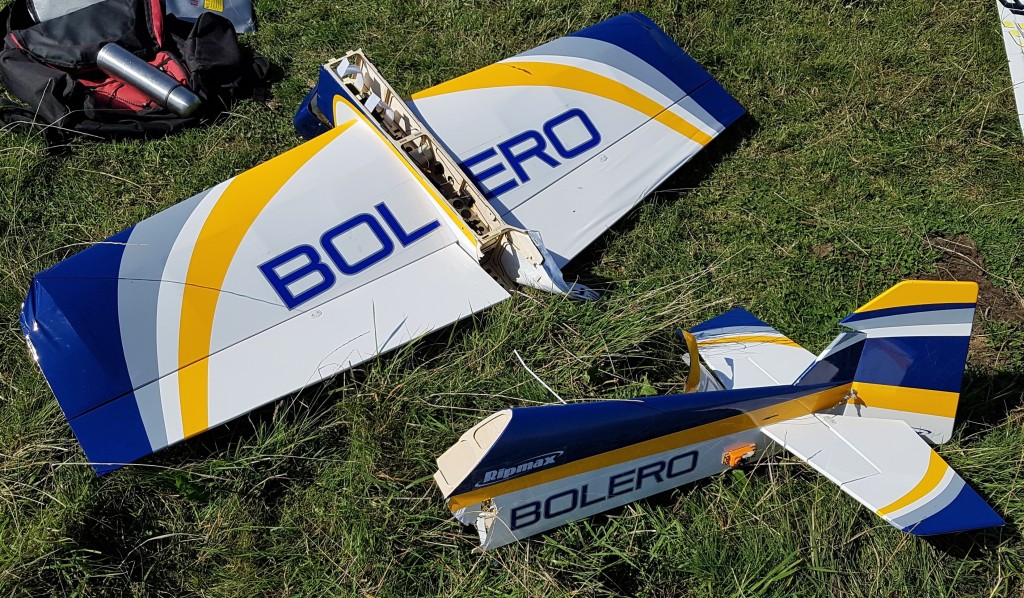 He was rather unlucky, it wasn’t even a real crash that caused so much damage, it was just a relatively minor hiccup on a landing approach. The problem nowadays is that the 3D models are so lightly built in order to give the best possible performance that a relatively minor mishap is harshly punished. The damage probably isn’t actually as terminal as it looks and I think it will repair fairly easily, I hope so anyway.
He was rather unlucky, it wasn’t even a real crash that caused so much damage, it was just a relatively minor hiccup on a landing approach. The problem nowadays is that the 3D models are so lightly built in order to give the best possible performance that a relatively minor mishap is harshly punished. The damage probably isn’t actually as terminal as it looks and I think it will repair fairly easily, I hope so anyway.
Two years ago a group of PAM members visited Vulcan XM655 at its’ home in Wellesbourne and were treated to a tour of the aircraft including the cockpit. This year on Sunday 16th September the 655 Maintenance and Preservation Society (MaPS) held a Members Day and, as both Percy Vears and Captain Slow have become members, they were present to see and hear the Vulcan’s engines being run up. When Percy built his lovely EDF Vulcan model he finished it in the XM655 colour scheme so he took it along on the day and found there was another Vulcan model there as well. Captain Slow took some photos and I downloaded some from the official website.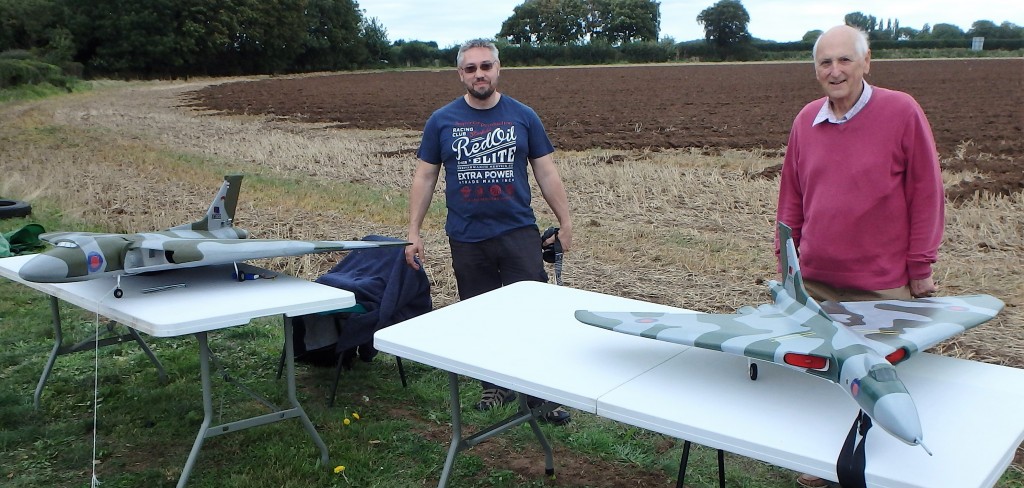

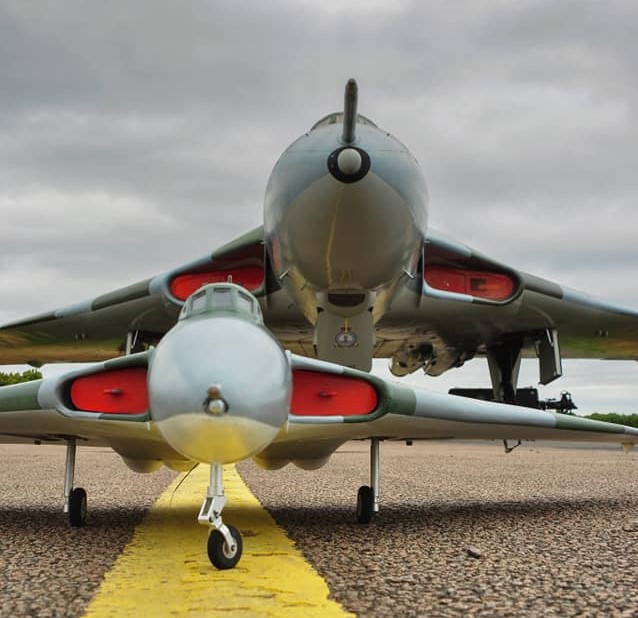
Norwegian Nick was given a part built model recently but had no idea what it was. Most of the model structure is built but it’s missing a fin, cowling, and cockpit so Nick decided to ask if anyone could identify it on the RCM&E forum (modelflying.co.uk). It took just 8 minutes for someone to identify it as a Chorus Gull designed by Brian Peckham and featured in RCM&E in February 2002. The design was loosely based on the Percival Mew Gull and was originally designed for a 60 size I/C engine but of course Nick will be using an electric motorto power this one.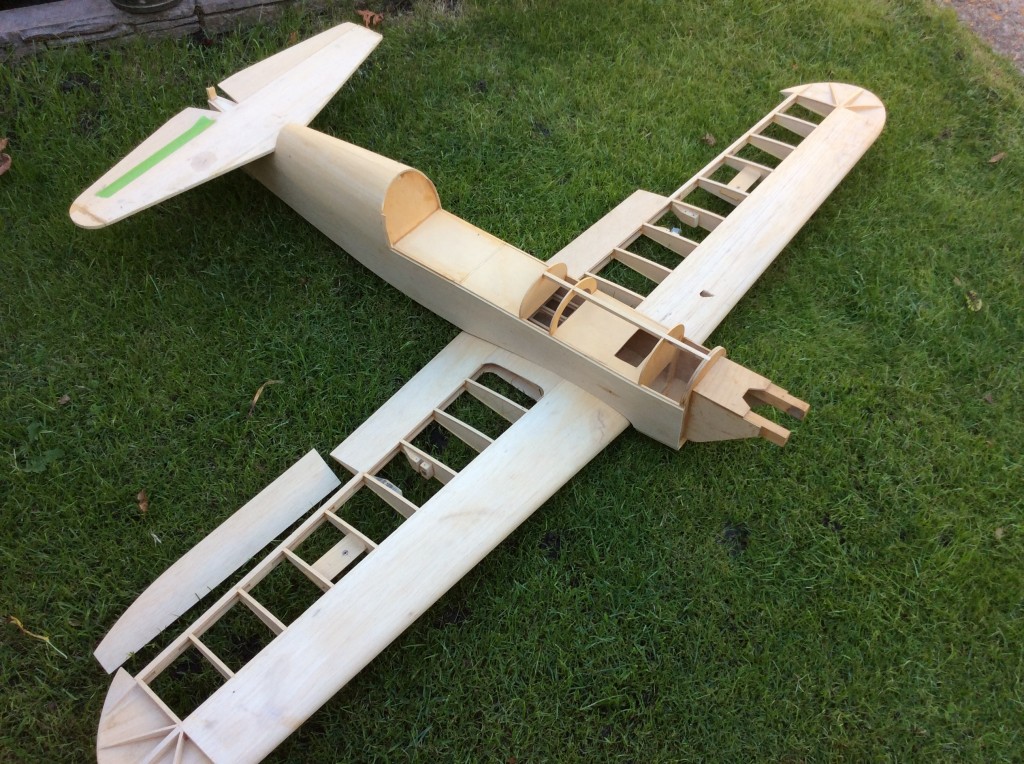
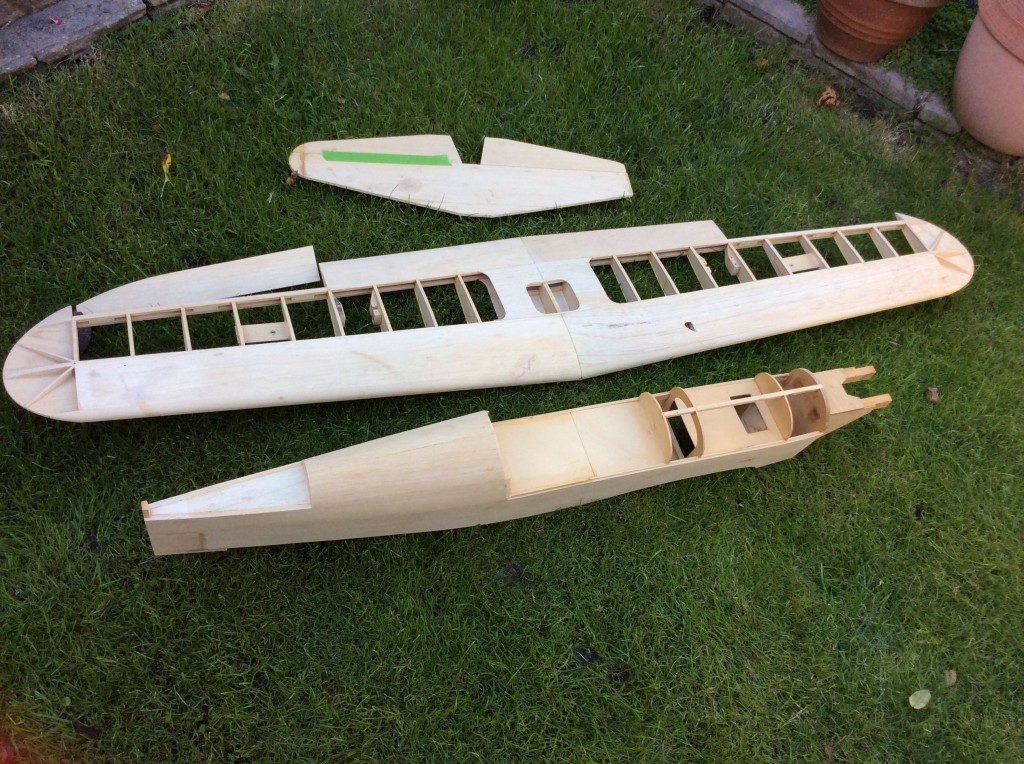 Various posts on the forum provided photos and a link to a company selling the plan, cowling & canopy. Another post had a link to a build blog on different forum. Nick has already ordered the plan. He says the model is beautifully built and he’ll now get on and complete the model. Isn’t the internet a wonderful thing?
Various posts on the forum provided photos and a link to a company selling the plan, cowling & canopy. Another post had a link to a build blog on different forum. Nick has already ordered the plan. He says the model is beautifully built and he’ll now get on and complete the model. Isn’t the internet a wonderful thing?
Thanks to Dougal and Captain Slow for their video and photo contributions this month. Kryten has also sent me lots of great ‘in air’ photos, here a selection, I’ll use some of the others next month: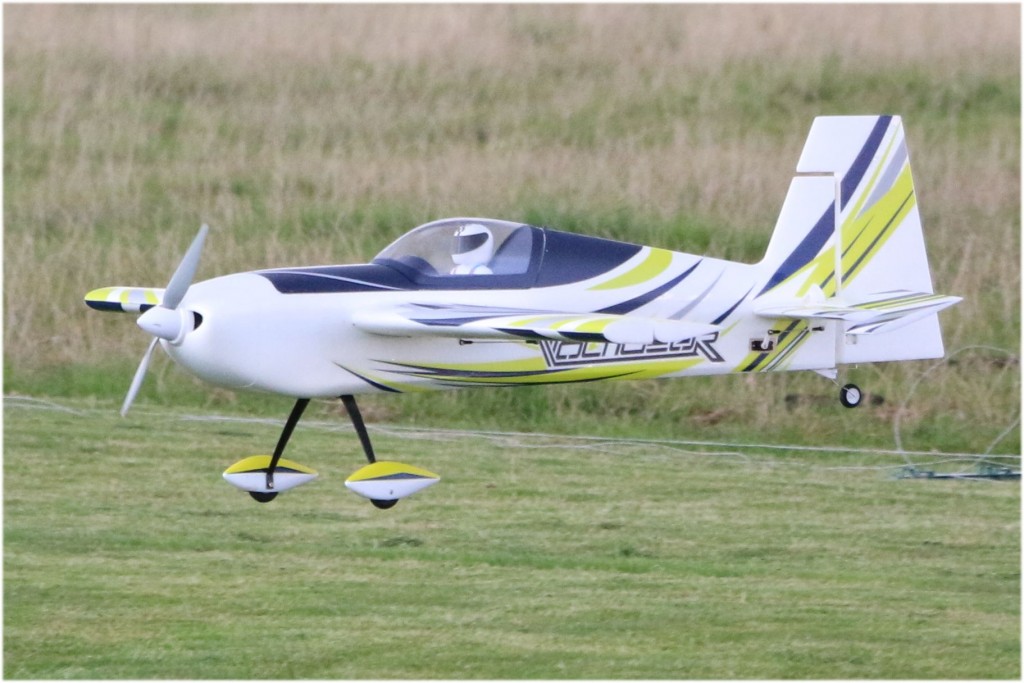
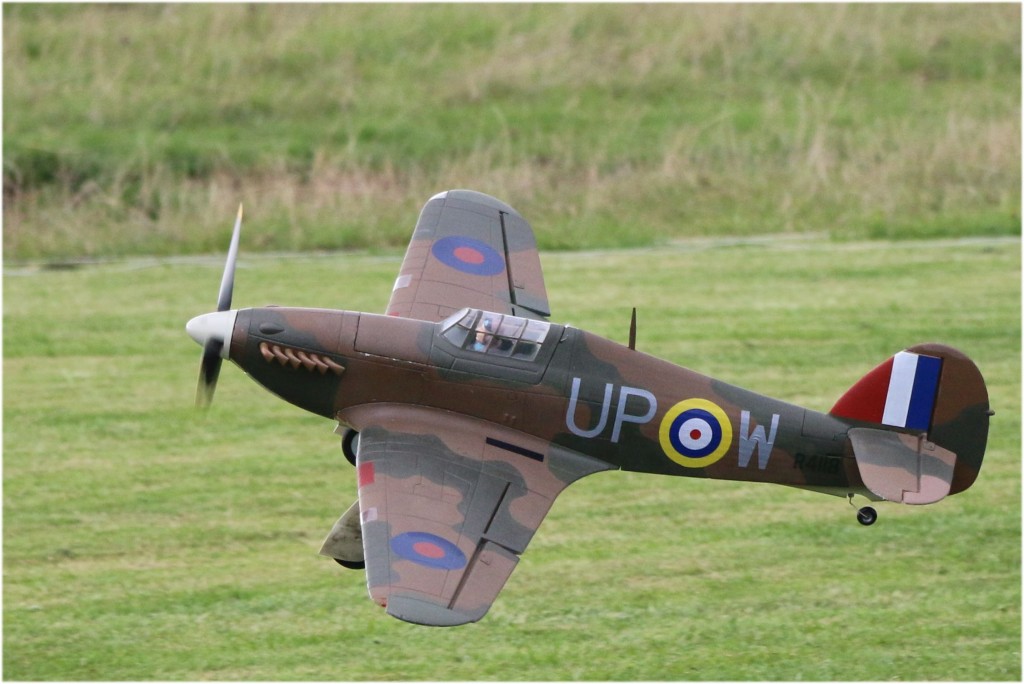
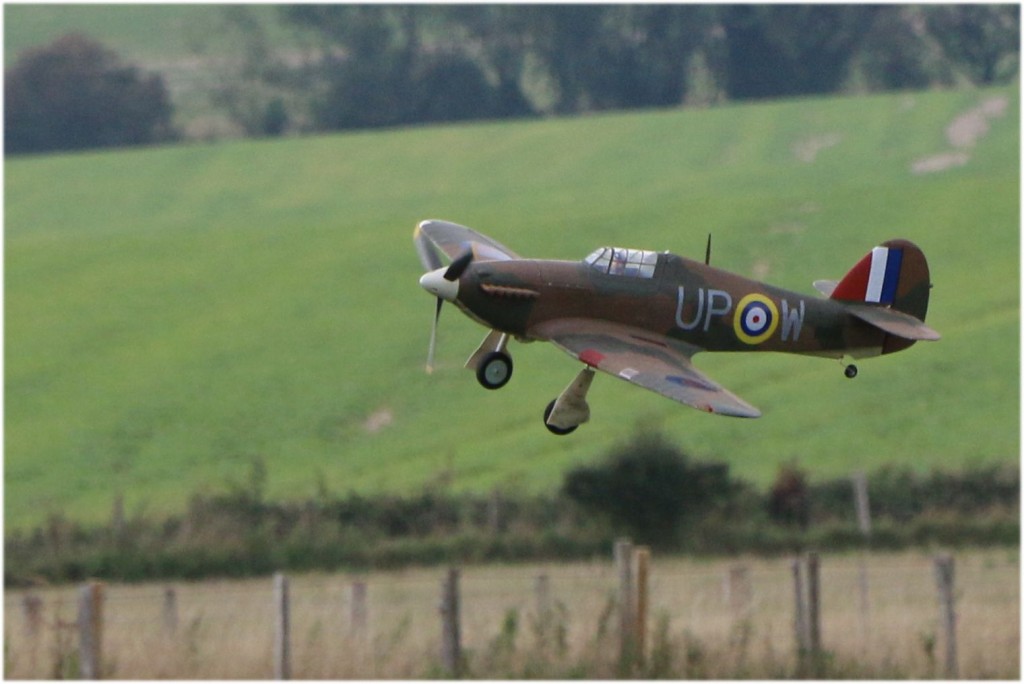


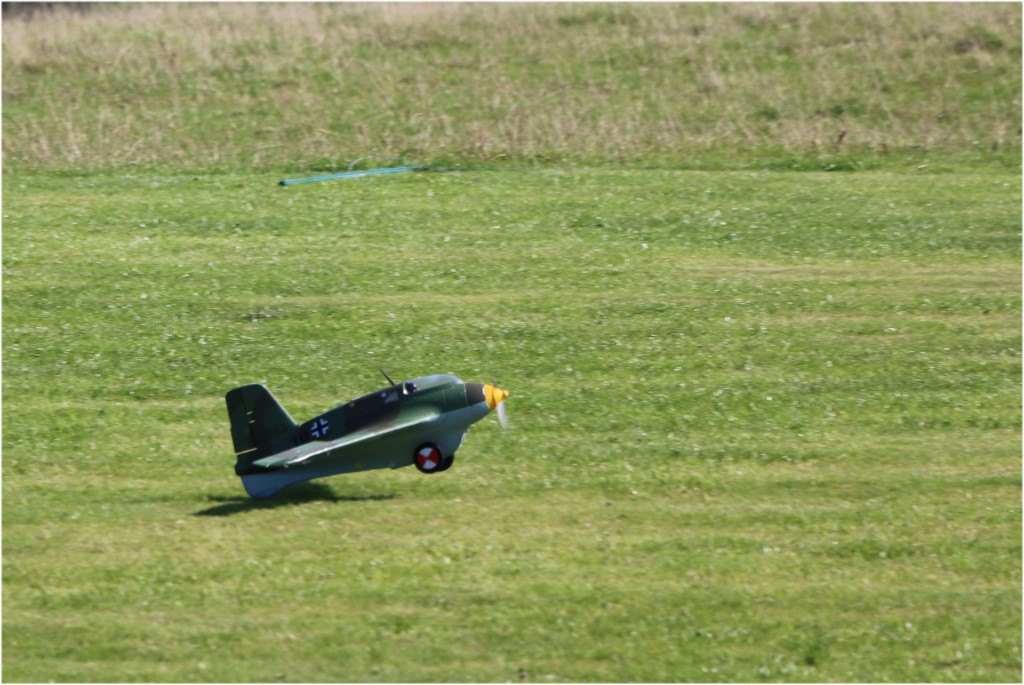
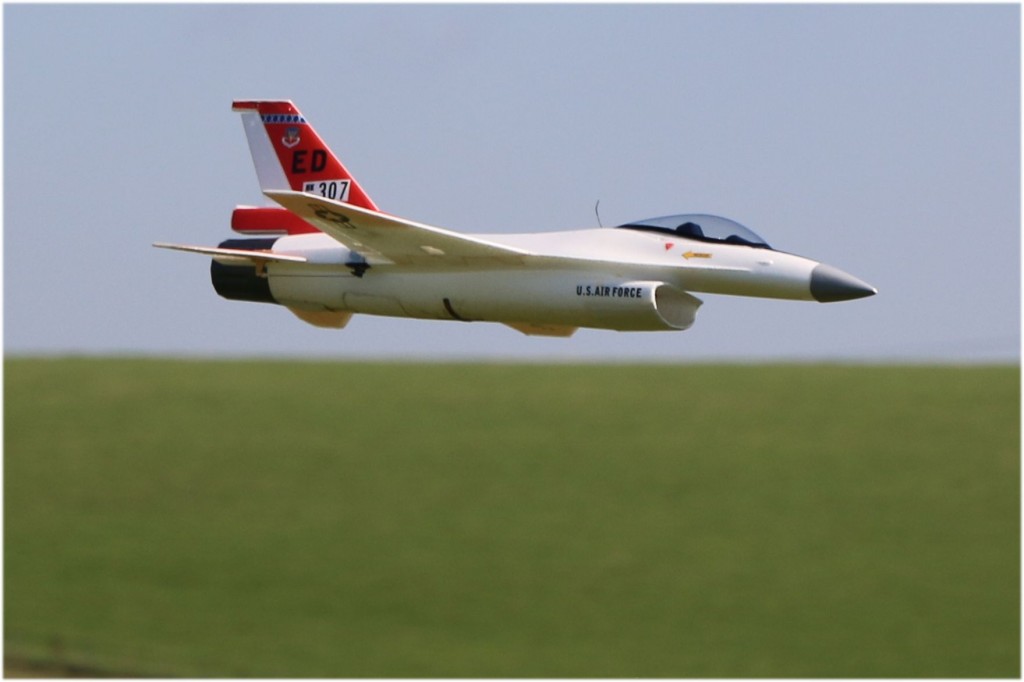
Video time now:
Please watch the video full screen, it’s so much better with small models flying around. If the video won’t play for you CLICK HEREOn an airplane, I overheard a stewardess talking to an elderly couple in front of me. Learning that it was the couple’s 50th wedding anniversary, the flight attendant congratulated them and asked how they had done it.
“It all felt like five minutes…” the gentleman said slowly.
The stewardess had just begun to remark on what a sweet statement that was when he finished his sentence with a word that earned him a sharp smack on the head:
“…underwater.”
Colin Cowplain
Patch News – August 2018
August saw a change in the weather and we’ve gone from moaning ‘It’s too hot, I’m sick of this heat, we need some rain’ to ‘What’s going on, it’s supposed to be summer but it’s like winter’! The patch greened up very quickly when it rained and the speed of the transformation from dry dust bowl to lush green grass was quite incredible.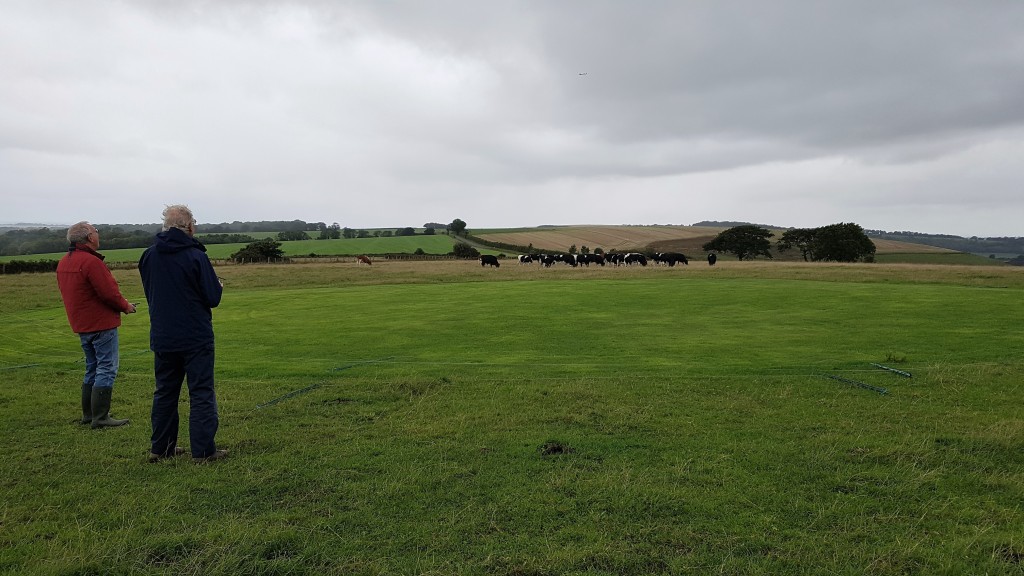 The FARTS (Friday Afternoon Rural Trimming Society) sprang into action and gave it a good cut on Friday 17th but even by the Monday it was growing rapidly and when it was cut again on Friday 24th there was a lot of grass taken off. With the fence doing its job of keeping the bullocks away the grass is now in first class condition and the patch is better than it’s been for a very long time. The bullocks have learnt not to go near the fence and they leave the fliers alone most of the time so we have rarely needed to use the pen round the pits area. I took this photo one midweek day when we had just arrived and were busy lowering the fence, that’s not how we had the pits set up!
The FARTS (Friday Afternoon Rural Trimming Society) sprang into action and gave it a good cut on Friday 17th but even by the Monday it was growing rapidly and when it was cut again on Friday 24th there was a lot of grass taken off. With the fence doing its job of keeping the bullocks away the grass is now in first class condition and the patch is better than it’s been for a very long time. The bullocks have learnt not to go near the fence and they leave the fliers alone most of the time so we have rarely needed to use the pen round the pits area. I took this photo one midweek day when we had just arrived and were busy lowering the fence, that’s not how we had the pits set up!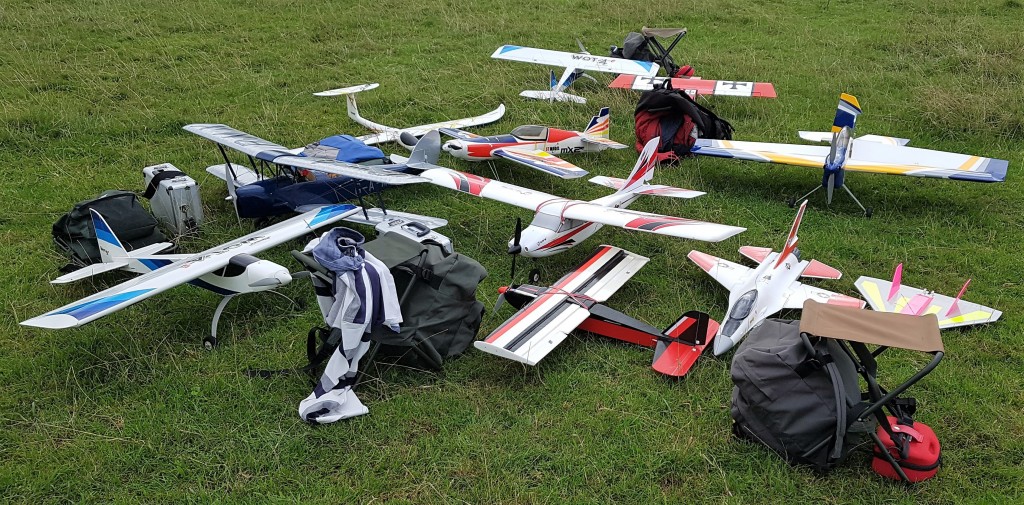 We had an ‘incident’ this month, John Warren managed to run his Albatros into himself whilst connecting the battery and the propeller did an excellent impersonation of a bacon slicer on his arm. He was extremely lucky that the cuts were not too deep and with the application of pads and a bandage the bleeding was soon stemmed. Initially we thought John was fine and we rang his wife to come and collect him but then shock kicked in, the blood drained from his face and he briefly passed out so we rang for an ambulance. John was laid down on a groundsheet with his arm raised and was looking much better by the time the ambulance arrived. The ambulance service was excellent (both the staff on the phone and the crew) and, once they’d checked his blood pressure etc., they soon had his arm cleaned up and re-bandaged. They said it didn’t need stitches and a trip to A&E wasn’t required so John’s wife drove him to Petersfield hospital where he was given a thorough check over, the wound redressed, and his arm put in a sling. Several things came out of the incident. Firstly, we must never get blasé about the dangers of an electric model once the battery has been connected. Secondly, the club first aid kits issued to members proved to be very good and we must all keep them with us whenever we fly, they are no use at home or in the car. Thirdly, it took several members to manage the situation, caring for John, directing the ambulance, replacing the fence and so on. Fortunately the bullocks stayed at the bottom of the field and didn’t need to be kept at bay, had they been more inquisitive the situation would have been much more difficult. I don’t want to be unsympathetic but John had been warned several times that he was not being careful enough with a ‘live’ model, hopefully he has learned from this. The incident should also serve as a warning to all of us not to be complacent, a model is dangerous from the moment the battery is connected and must be treated with the utmost respect.
We had an ‘incident’ this month, John Warren managed to run his Albatros into himself whilst connecting the battery and the propeller did an excellent impersonation of a bacon slicer on his arm. He was extremely lucky that the cuts were not too deep and with the application of pads and a bandage the bleeding was soon stemmed. Initially we thought John was fine and we rang his wife to come and collect him but then shock kicked in, the blood drained from his face and he briefly passed out so we rang for an ambulance. John was laid down on a groundsheet with his arm raised and was looking much better by the time the ambulance arrived. The ambulance service was excellent (both the staff on the phone and the crew) and, once they’d checked his blood pressure etc., they soon had his arm cleaned up and re-bandaged. They said it didn’t need stitches and a trip to A&E wasn’t required so John’s wife drove him to Petersfield hospital where he was given a thorough check over, the wound redressed, and his arm put in a sling. Several things came out of the incident. Firstly, we must never get blasé about the dangers of an electric model once the battery has been connected. Secondly, the club first aid kits issued to members proved to be very good and we must all keep them with us whenever we fly, they are no use at home or in the car. Thirdly, it took several members to manage the situation, caring for John, directing the ambulance, replacing the fence and so on. Fortunately the bullocks stayed at the bottom of the field and didn’t need to be kept at bay, had they been more inquisitive the situation would have been much more difficult. I don’t want to be unsympathetic but John had been warned several times that he was not being careful enough with a ‘live’ model, hopefully he has learned from this. The incident should also serve as a warning to all of us not to be complacent, a model is dangerous from the moment the battery is connected and must be treated with the utmost respect.
Lecture over, onto more pleasant things now. Despite it still being summer there was a slight lack of new models in August but Page Boy turned up one morning with a very nice little North American AT-6 Texan.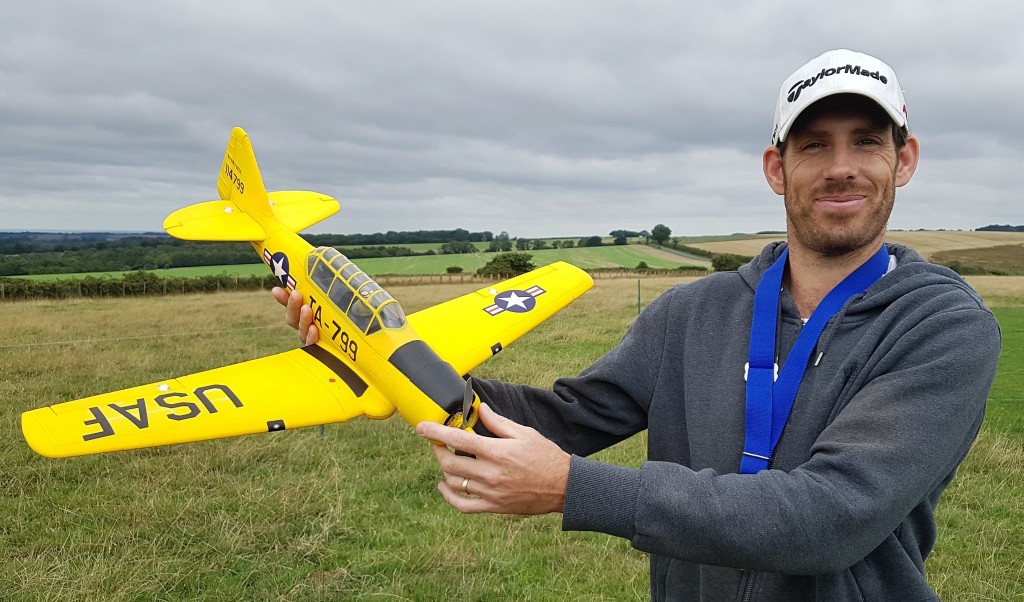 The British version is the Harvard but they are basically the same plane. Page Boy’s Texan comes from FMS and it’s an 800mm span model moulded in EPO foam. He actually bought it second-hand (but unflown I think) on eBay about a year ago but has only just got around to finishing it. Page Boy has fitted 1900Kv bell motor in place of the stock 1300Kv motor and uses a 3 cell 1000mAh lipo. At full throttle it’s giving 185W and as the Texan only weighs 450g (1lb) that’s an awful lot of power! The rest of the gear is as it comes, a 20A esc and four 9g servos.
The British version is the Harvard but they are basically the same plane. Page Boy’s Texan comes from FMS and it’s an 800mm span model moulded in EPO foam. He actually bought it second-hand (but unflown I think) on eBay about a year ago but has only just got around to finishing it. Page Boy has fitted 1900Kv bell motor in place of the stock 1300Kv motor and uses a 3 cell 1000mAh lipo. At full throttle it’s giving 185W and as the Texan only weighs 450g (1lb) that’s an awful lot of power! The rest of the gear is as it comes, a 20A esc and four 9g servos.
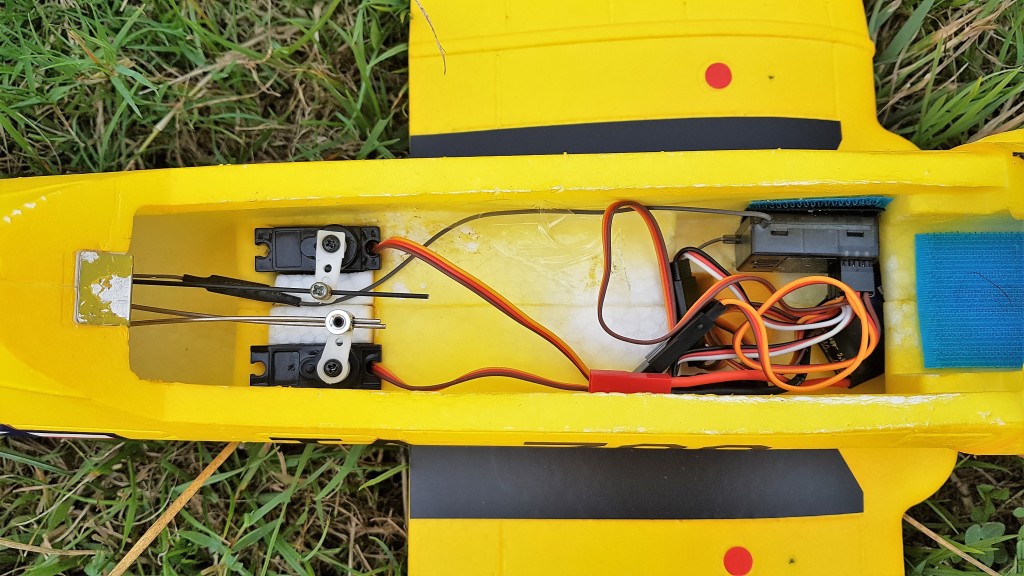 As you can see in this month’s video the Texan flies really well. Page Boy was flinging it around at pretty high speed when I was filming but I had a flight with it afterwards and it is also well behaved when flown much more slowly, I was really impressed with it, a lovely little model.
As you can see in this month’s video the Texan flies really well. Page Boy was flinging it around at pretty high speed when I was filming but I had a flight with it afterwards and it is also well behaved when flown much more slowly, I was really impressed with it, a lovely little model.
At Buriton recreation ground, before the last meeting of August, Dwayne Pipe flew his the latest version of his indoor/very light wind model, appropriately named Mark 3. Unfortunately I was busy flying my Hummer so I didn’t get to video the Mark 3 but it looked to be flying well, certainly much better than either the Mark 1 or Mark 2 did.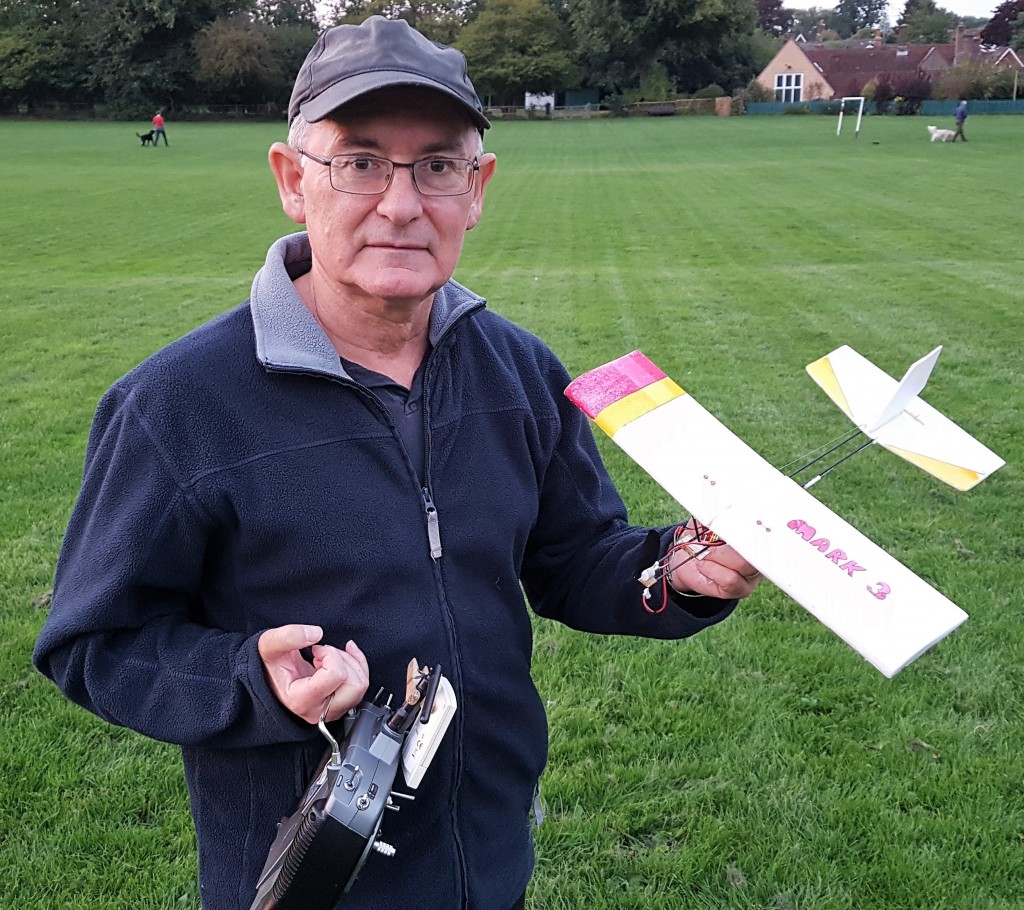
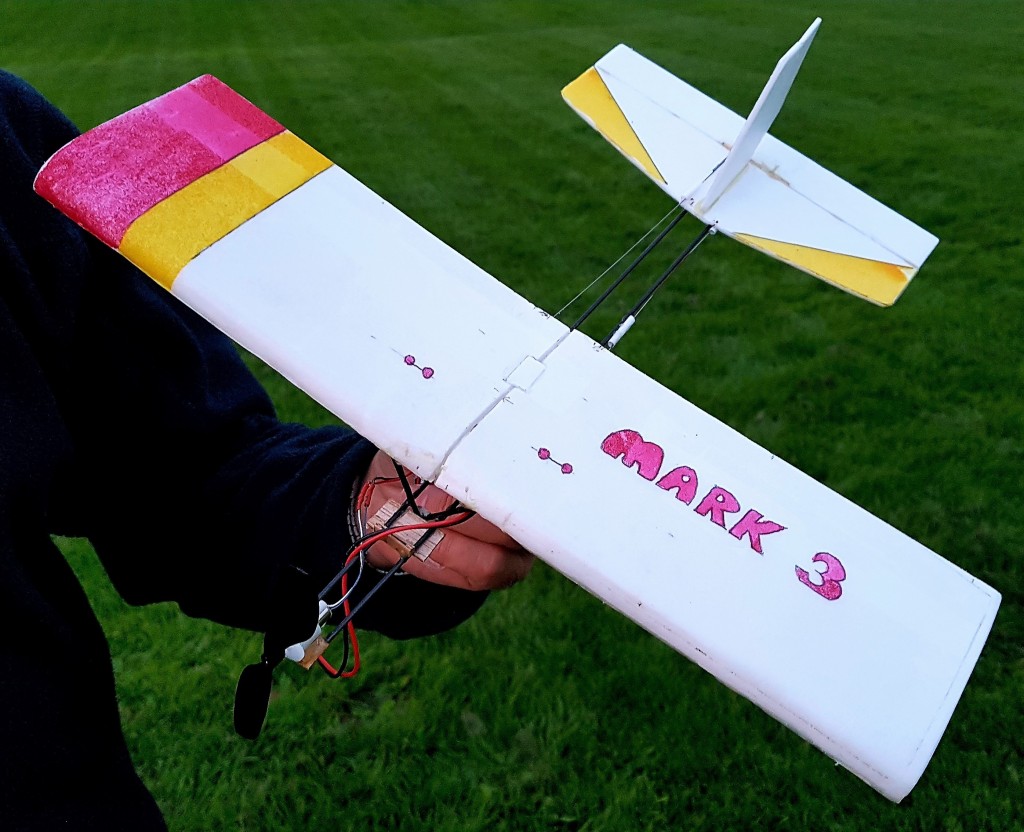 I asked Dwayne for some details of the model and this is what he sent: The Mark 3 is my latest attempt to home build an indoor flyer that uses my standard Spektrum transmitter. I have a couple of HobbyKing indoor planes already, which always come with their own low spec custom transmitter. The Mark 1 was a 15″ Depron Blitz that flew round in circles. The Mark 2 was a 15″ Depron Splot that was too heavy and could barely fly.
I asked Dwayne for some details of the model and this is what he sent: The Mark 3 is my latest attempt to home build an indoor flyer that uses my standard Spektrum transmitter. I have a couple of HobbyKing indoor planes already, which always come with their own low spec custom transmitter. The Mark 1 was a 15″ Depron Blitz that flew round in circles. The Mark 2 was a 15″ Depron Splot that was too heavy and could barely fly.
The Mark 3 is a 15″ own design based on the Splot planform. It flies on rudder, elevator and throttle control. The wings and tail feathers are made of 3mm Aero Depron. The cambered wing is heat moulded to a Clark Y section using a process I found in a recent RCME article. This construction makes a very stiff wing that requires no spar. The two wing sections are assembled with dihedral and then epoxied to a couple of 2mm carbon fibre tubes which form the fuselage, with the tail being sheet Depron. The whole thing including battery I estimate as about 30 grams.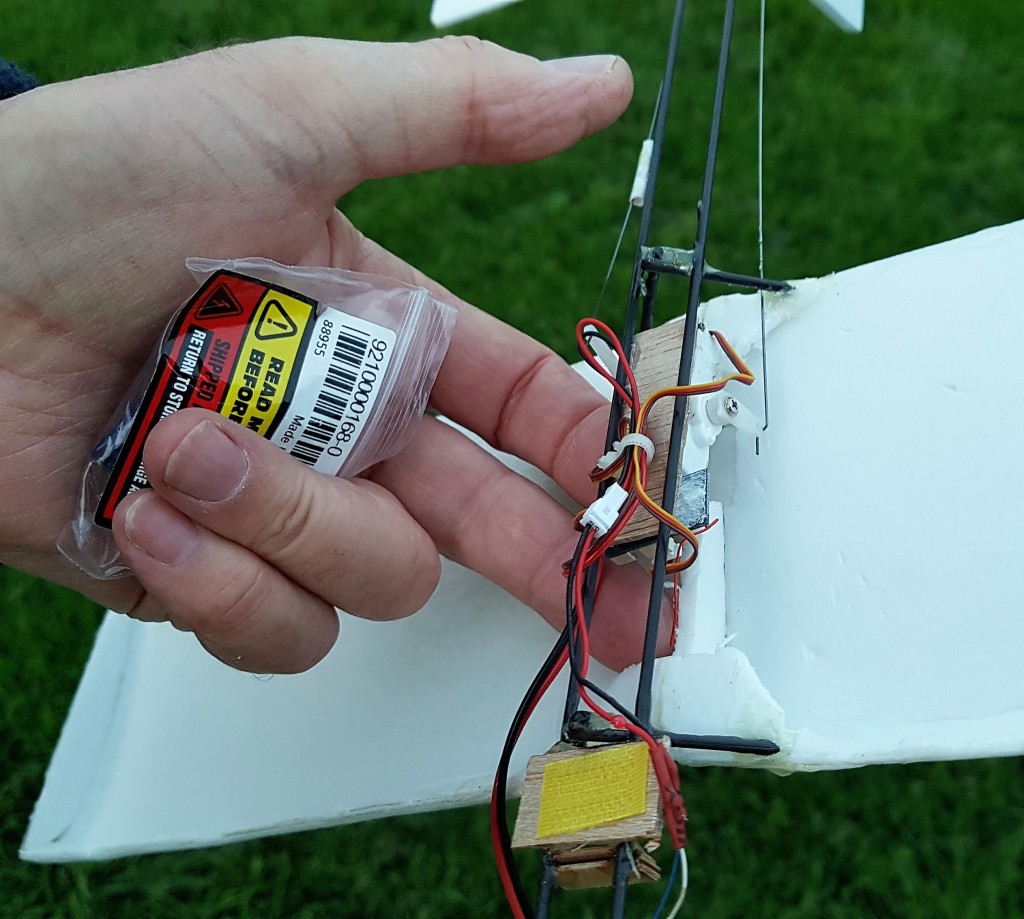 The electronics are a Bang-good 2.4G Micro DSM2 compatible receiver with built in brushed ESC. This was bound to my transmitter (eventually) and unlike most “blocks” comes with 4 servo micro sockets. It turns out that only HobbyKing make servos to fit these sockets. These are HobbyKing HK-282AS ultra-micro analogue servos at 2.2 grams each. The motor is a Bang-good coreless brushed motor fitted with gearbox and 5.5 inch propeller. Most importantly I discovered that these tiny aircraft require no down thrust or side thrust when setting up the motor. The battery is 1S 300mAh positioned to balance the model. The model is designed to take the wire wheels from another indoor flyer and will take-off from the ground.
The electronics are a Bang-good 2.4G Micro DSM2 compatible receiver with built in brushed ESC. This was bound to my transmitter (eventually) and unlike most “blocks” comes with 4 servo micro sockets. It turns out that only HobbyKing make servos to fit these sockets. These are HobbyKing HK-282AS ultra-micro analogue servos at 2.2 grams each. The motor is a Bang-good coreless brushed motor fitted with gearbox and 5.5 inch propeller. Most importantly I discovered that these tiny aircraft require no down thrust or side thrust when setting up the motor. The battery is 1S 300mAh positioned to balance the model. The model is designed to take the wire wheels from another indoor flyer and will take-off from the ground.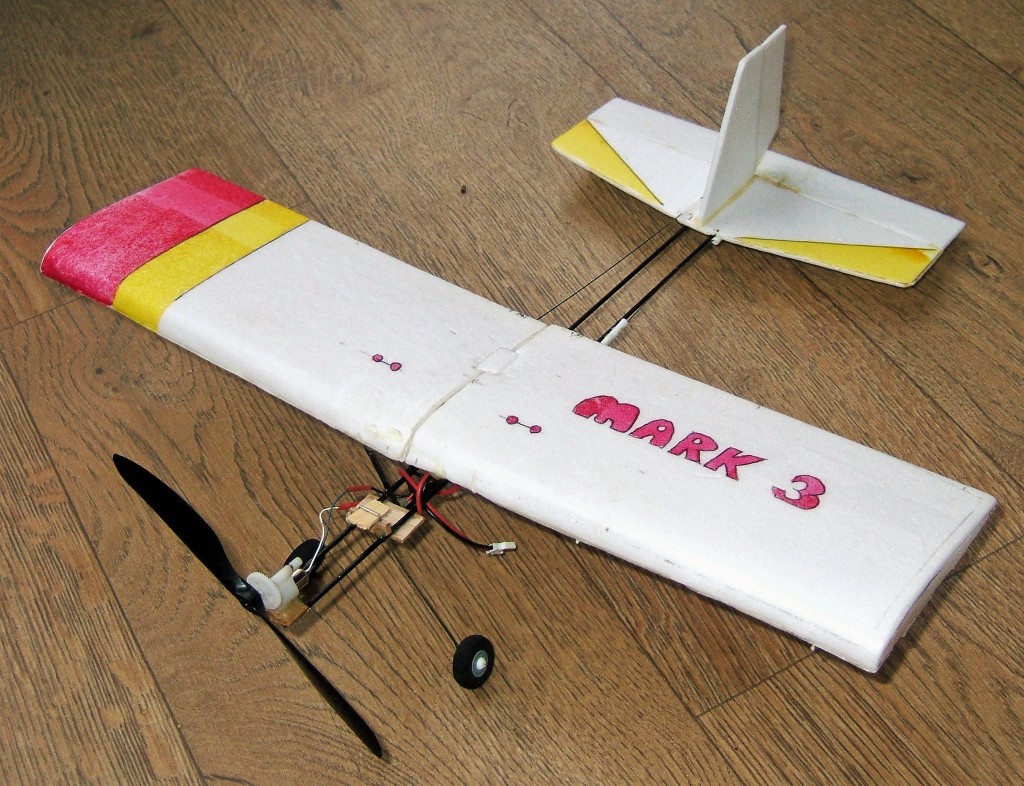 From initial flights it is very stable and should be ideal for indoor flying at Havant but probably too cumbersome to fly at the much smaller Medstead. Thanks Dwayne, I’ll try to get some video of the Mark 3 for a future Patch News.
From initial flights it is very stable and should be ideal for indoor flying at Havant but probably too cumbersome to fly at the much smaller Medstead. Thanks Dwayne, I’ll try to get some video of the Mark 3 for a future Patch News.
It finally happened, Cream Egg eventually ran out of skill luck and crashed his Wot4…big time! He had to search for a replacement and this is his story: I spent a lot of time considering what model to purchase following the demise of my WOT4 through stupid pilot error! I ended up with a very extensive shortlist and then Steve Hastings (1066) kindly came over one evening for us to go through the choices and finally settled on the Voltigeur.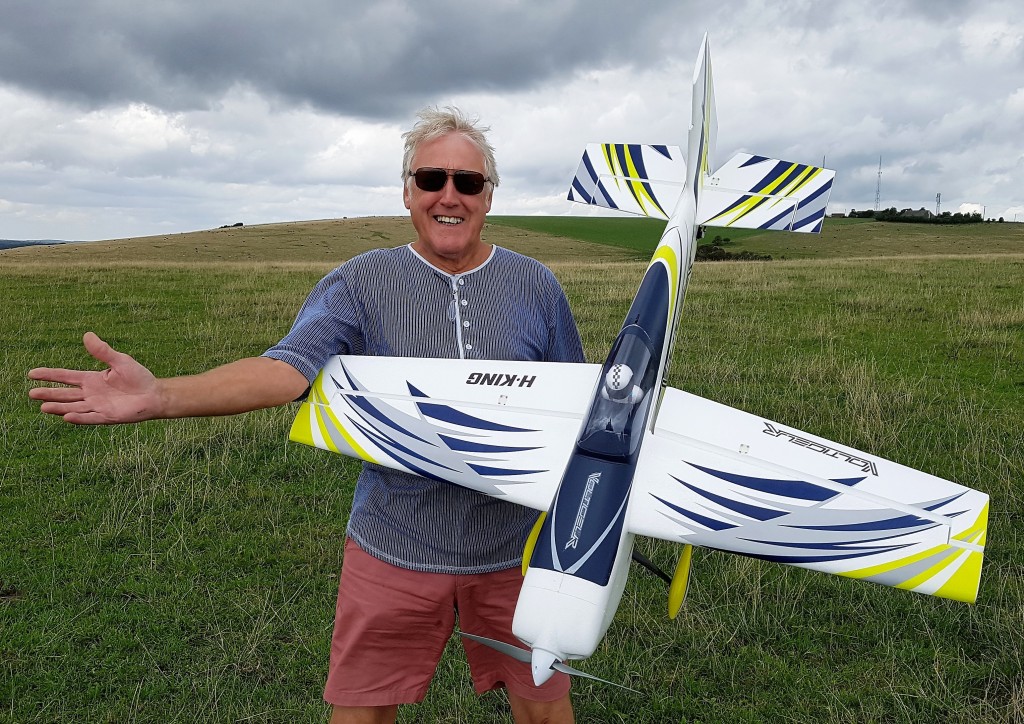 Cost: £142, including motor, 45 Amp ESC, servos, prop and everything necessary other than the receiver. Assembly instructions: None. Simply 10 pictures on the box, which were very easy to follow. The servos and linkages are pre-fitted. These feature very nice ball joints and the servos are metal gear versions. The entire model is foam construction. Carbon fibre rod through the wings, which is typical. The wings are secured by small plastic bolts for easy disassembly. All one needs is some good Gorilla Glue to install the elevator/rudder/tailplane assembly. Connecting the linkages was reasonably straightforward. The worst operation is assembling the wheels and the fairings that surround them. This took more time than any other operation. Wheels are small and one already has a partial flattened surface and so I am inclined to change these and indeed increase the size slightly as the fairings will accommodate a larger diameter. The plane is designed for 3S batteries and demonstrations by Michael Wargo of Hobbyking show this to be a high performance aircraft with this size of battery and the 1000Kv motor/45Amp ESC. However, my 3S batteries were originally used in my Pandora when I started out and, as they have not been charged/discharged very much over the last year or so, I found them to be quite weak. Accordingly, I thought I would try my 4S batteries, which I have been using in the WOT4. A full load test with Andy‘s assistance showed a maximum power draw of 500 Watts at 40 Amps. Accordingly then, the 45 amp ESC supplied should in theory be adequate, but I plan to use the 60 Amp ESC out of my WOT4 instead. My last flight lasted eight minutes and came down with 57% on the 4S battery flown in fairly high winds of up to 17 mph. All up, I am delighted with the model and especially the way she handles, especially when landing. She is very light and when climbing vertically, it is really impressive. I believe it will be a great aerobatic model to further develop my skills.
Cost: £142, including motor, 45 Amp ESC, servos, prop and everything necessary other than the receiver. Assembly instructions: None. Simply 10 pictures on the box, which were very easy to follow. The servos and linkages are pre-fitted. These feature very nice ball joints and the servos are metal gear versions. The entire model is foam construction. Carbon fibre rod through the wings, which is typical. The wings are secured by small plastic bolts for easy disassembly. All one needs is some good Gorilla Glue to install the elevator/rudder/tailplane assembly. Connecting the linkages was reasonably straightforward. The worst operation is assembling the wheels and the fairings that surround them. This took more time than any other operation. Wheels are small and one already has a partial flattened surface and so I am inclined to change these and indeed increase the size slightly as the fairings will accommodate a larger diameter. The plane is designed for 3S batteries and demonstrations by Michael Wargo of Hobbyking show this to be a high performance aircraft with this size of battery and the 1000Kv motor/45Amp ESC. However, my 3S batteries were originally used in my Pandora when I started out and, as they have not been charged/discharged very much over the last year or so, I found them to be quite weak. Accordingly, I thought I would try my 4S batteries, which I have been using in the WOT4. A full load test with Andy‘s assistance showed a maximum power draw of 500 Watts at 40 Amps. Accordingly then, the 45 amp ESC supplied should in theory be adequate, but I plan to use the 60 Amp ESC out of my WOT4 instead. My last flight lasted eight minutes and came down with 57% on the 4S battery flown in fairly high winds of up to 17 mph. All up, I am delighted with the model and especially the way she handles, especially when landing. She is very light and when climbing vertically, it is really impressive. I believe it will be a great aerobatic model to further develop my skills.
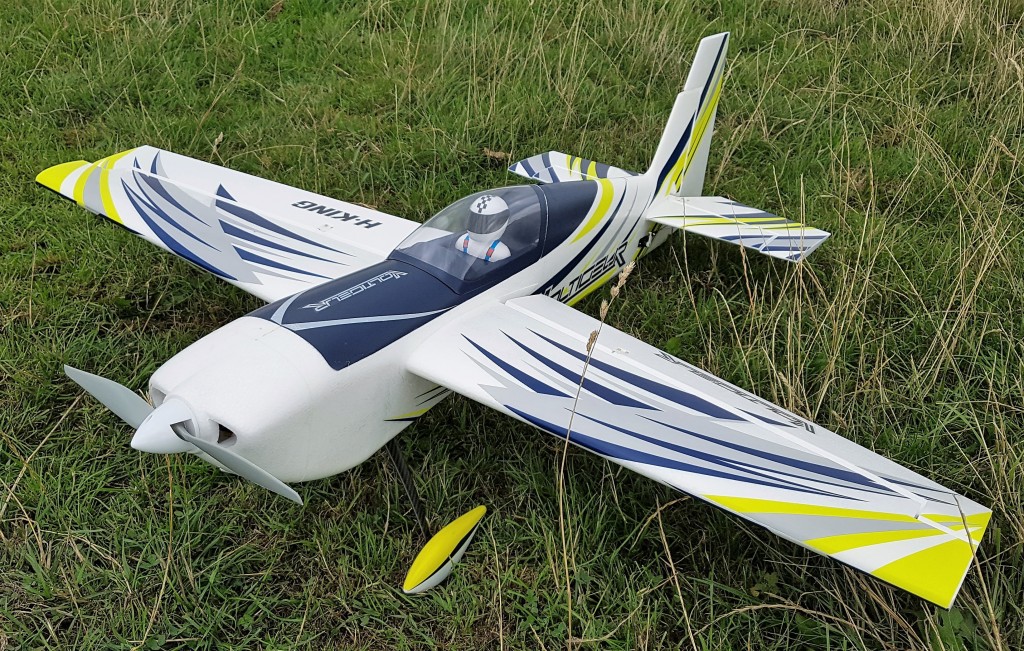 The Voltigeur certainly looks good both on the ground and in the air, it’s a very pretty model that performs really well. You can see 1066 doing the maiden flight and some of Crème Egg’s latest flight in this month’s video.
The Voltigeur certainly looks good both on the ground and in the air, it’s a very pretty model that performs really well. You can see 1066 doing the maiden flight and some of Crème Egg’s latest flight in this month’s video.
I mentioned in last month’s Patch News that we had been visited by ex-PAM member Peter Mason and he’d promised to organise a quiz night for us. He duly came along to the first meeting in August and ran what turned out to be a very successful quiz consisting of 50 wide ranging aviation questions. The questions were well thought out and I was pleased that there were none of the ‘How many rivets were used to construct Mk.9 Spitfire’ type. Some questions were comparatively easy while others made our tired old brains whir quite a lot! Peter provided some very nice prizes for the first three places and I’m pleased to say that I won with just 25 points and Dougal and Woody tied for second place with 24 points each. I’m sure all those present thoroughly enjoyed the evening and we pass on our thanks to Peter.
Woody bought himself a new Wot4 recently and has been getting along well with it in August.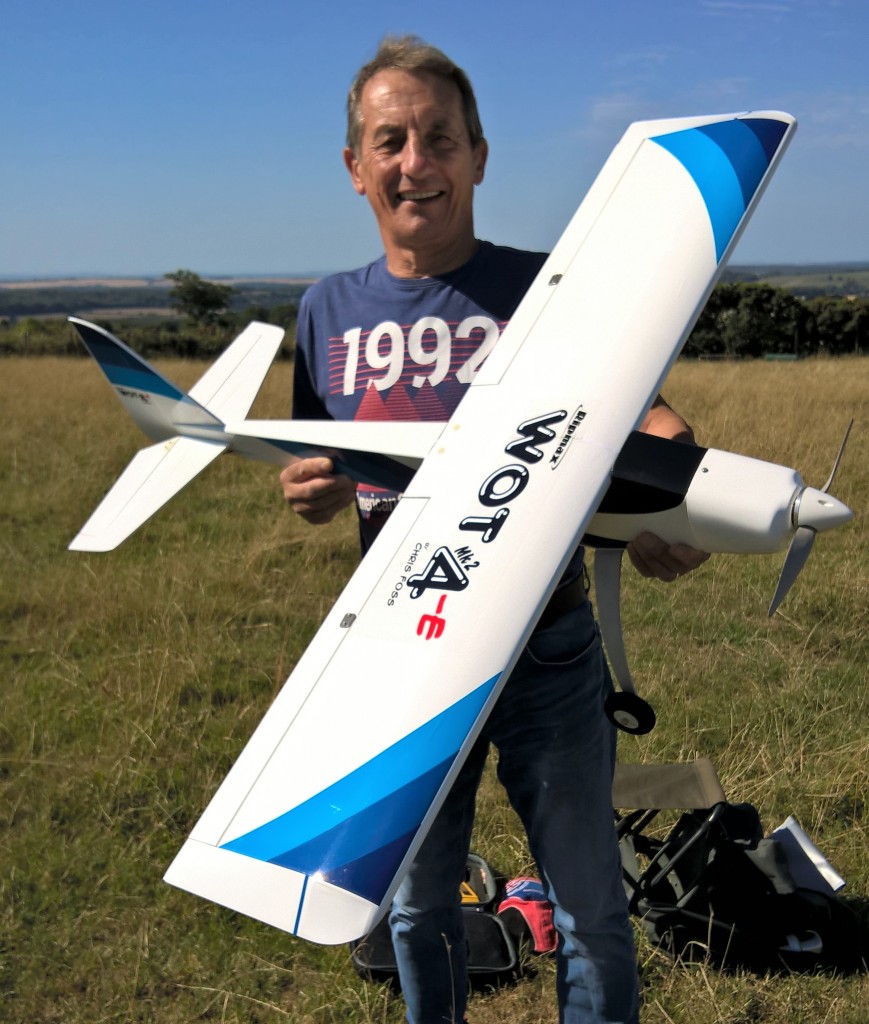 It’s an ARTF wood E version, not the Foam-E and is identical to the one being flown by Bob the Builder. There could be trouble ahead…! Kryten snapped a couple of lovely flying shots of the Wot4.
It’s an ARTF wood E version, not the Foam-E and is identical to the one being flown by Bob the Builder. There could be trouble ahead…! Kryten snapped a couple of lovely flying shots of the Wot4.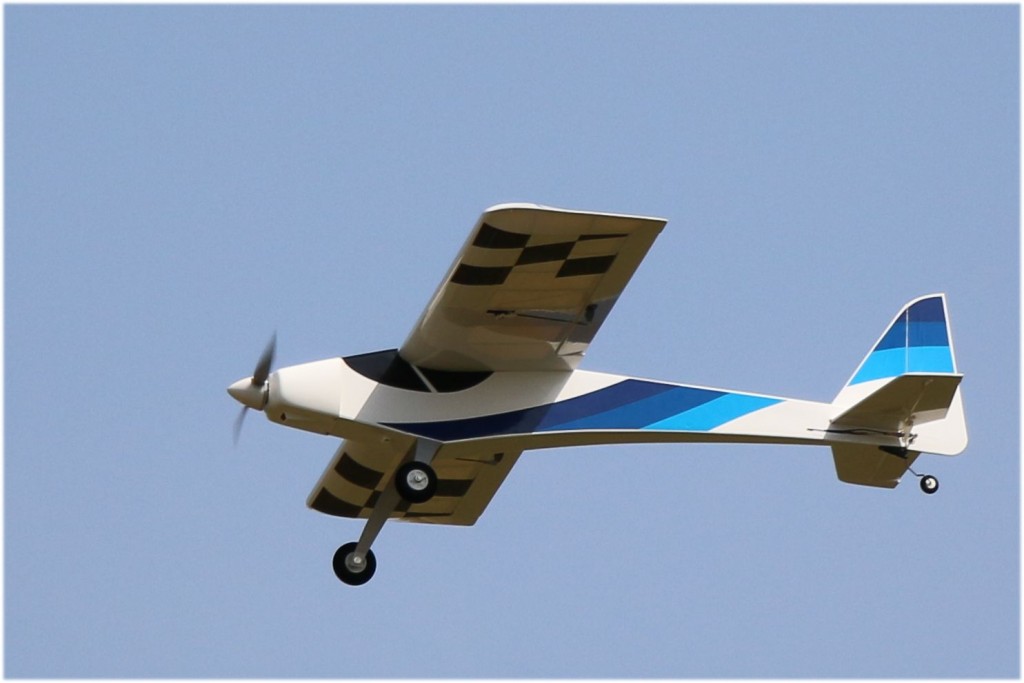
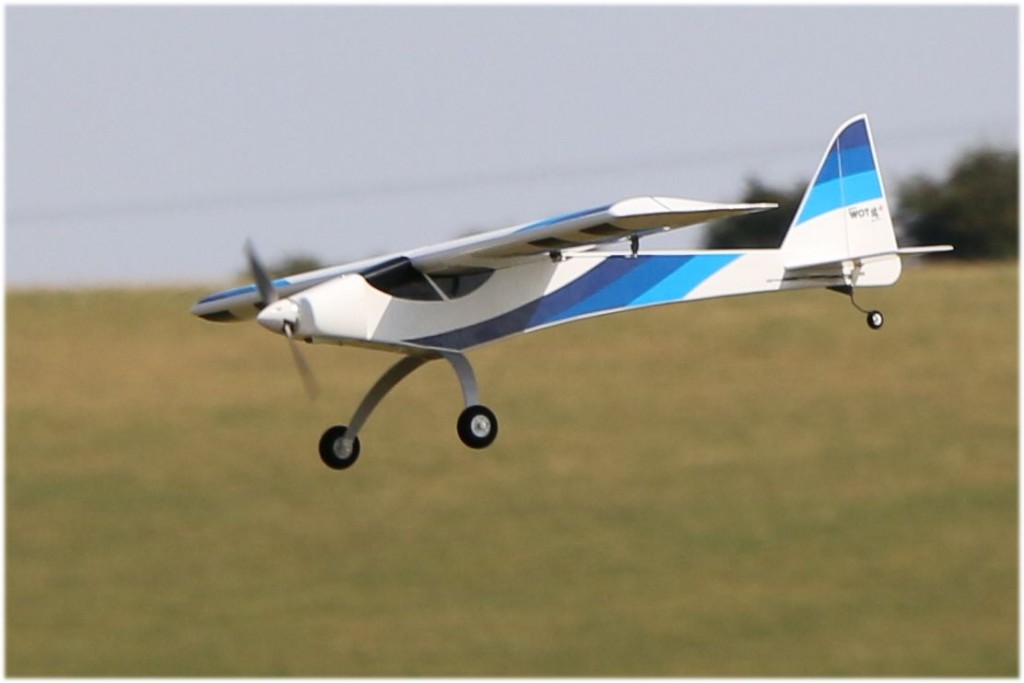 Woody has also finished a renovation job on his old Seagull Swift trainer. I think the Swift was Woody’s first model and it served him well but as it’s now around 5 years old it was starting to look a bit tatty.
Woody has also finished a renovation job on his old Seagull Swift trainer. I think the Swift was Woody’s first model and it served him well but as it’s now around 5 years old it was starting to look a bit tatty. He decided to give it a US Navy Blue Angels colour scheme in the hope that the bright yellow underside would show up well even at 5000ft where he usually flies! It certainly works, looks very smart, and flies as well as it always did. Although Seagull sell the Swift as I/C or electric it’s really just an I/C plane that’s easy to convert.
He decided to give it a US Navy Blue Angels colour scheme in the hope that the bright yellow underside would show up well even at 5000ft where he usually flies! It certainly works, looks very smart, and flies as well as it always did. Although Seagull sell the Swift as I/C or electric it’s really just an I/C plane that’s easy to convert.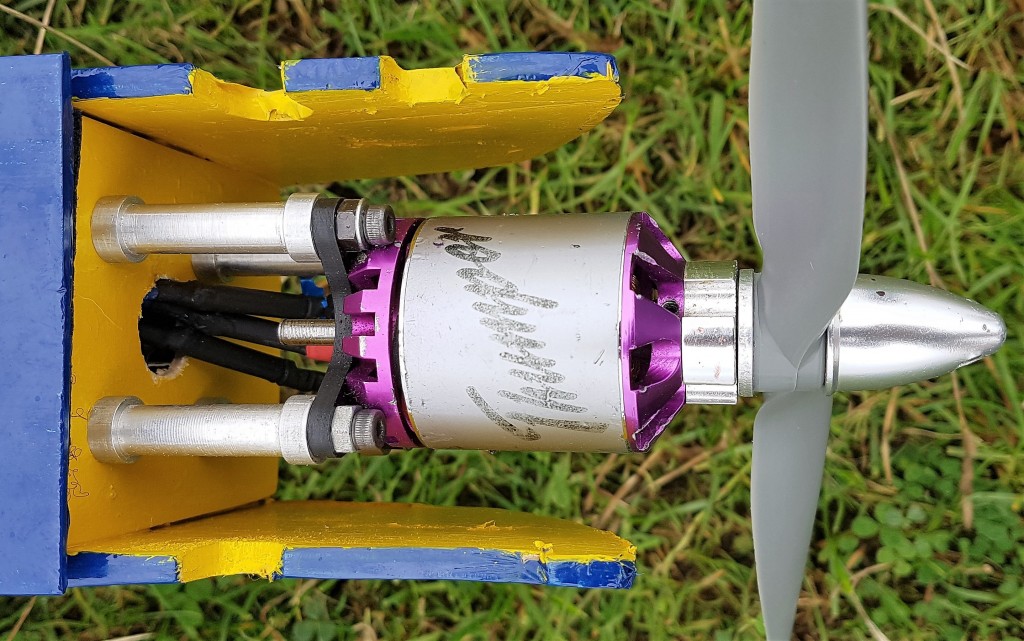
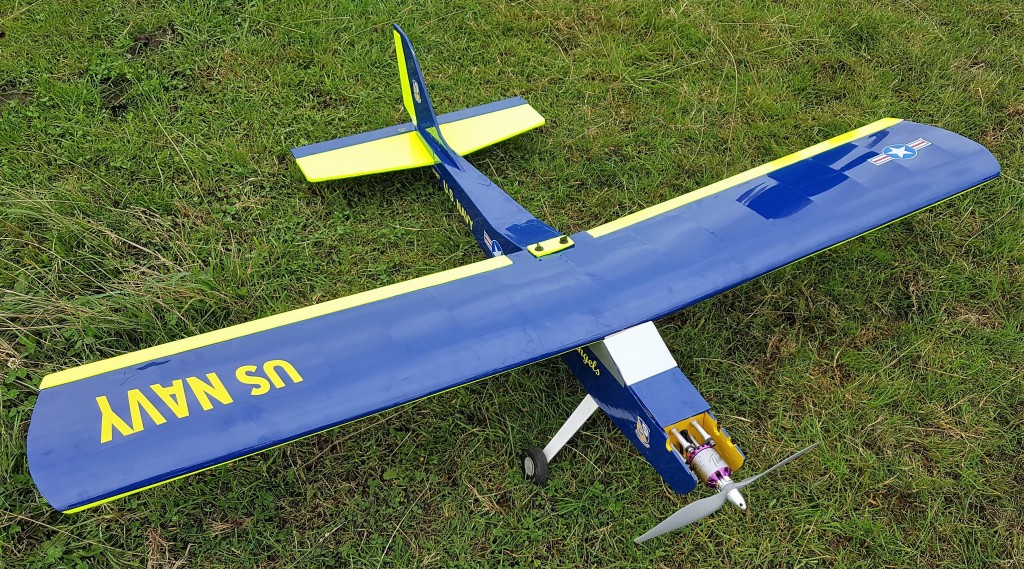 Woody has fitted an old Thumper motor and runs it on a 5 cell lipo which gives it ample power to do all the aerobatics that you can expect from a trainer. Good one Woody, well done.
Woody has fitted an old Thumper motor and runs it on a 5 cell lipo which gives it ample power to do all the aerobatics that you can expect from a trainer. Good one Woody, well done.
Having buried his original Kung Fu 1066 decided he missed it and has built another one. The first one was built for the annual club model event although 1066 seemed to have trouble counting fins as his only had one rather than the two shown on the plan. The club models were built from Depron and most flew very well, 1066’s being vastly over-powered as usual. He has built the replacement Kung Fu from foam board, the paper faced/foam core stuff that can be found in art supply shops etc. It’s very easy to work with although 1066 found the paper is easily damaged by tape when trying to hold it together while glue dries. I imagine cyano would melt the foam so UHU Por, Gorilla Glue or epoxy would be the obvious choices. The new one is to the plan apart from only having one fin (again!) and a slightly lengthened nose in order to achieve the C of G without requiring nose weight.
The first one was built for the annual club model event although 1066 seemed to have trouble counting fins as his only had one rather than the two shown on the plan. The club models were built from Depron and most flew very well, 1066’s being vastly over-powered as usual. He has built the replacement Kung Fu from foam board, the paper faced/foam core stuff that can be found in art supply shops etc. It’s very easy to work with although 1066 found the paper is easily damaged by tape when trying to hold it together while glue dries. I imagine cyano would melt the foam so UHU Por, Gorilla Glue or epoxy would be the obvious choices. The new one is to the plan apart from only having one fin (again!) and a slightly lengthened nose in order to achieve the C of G without requiring nose weight.
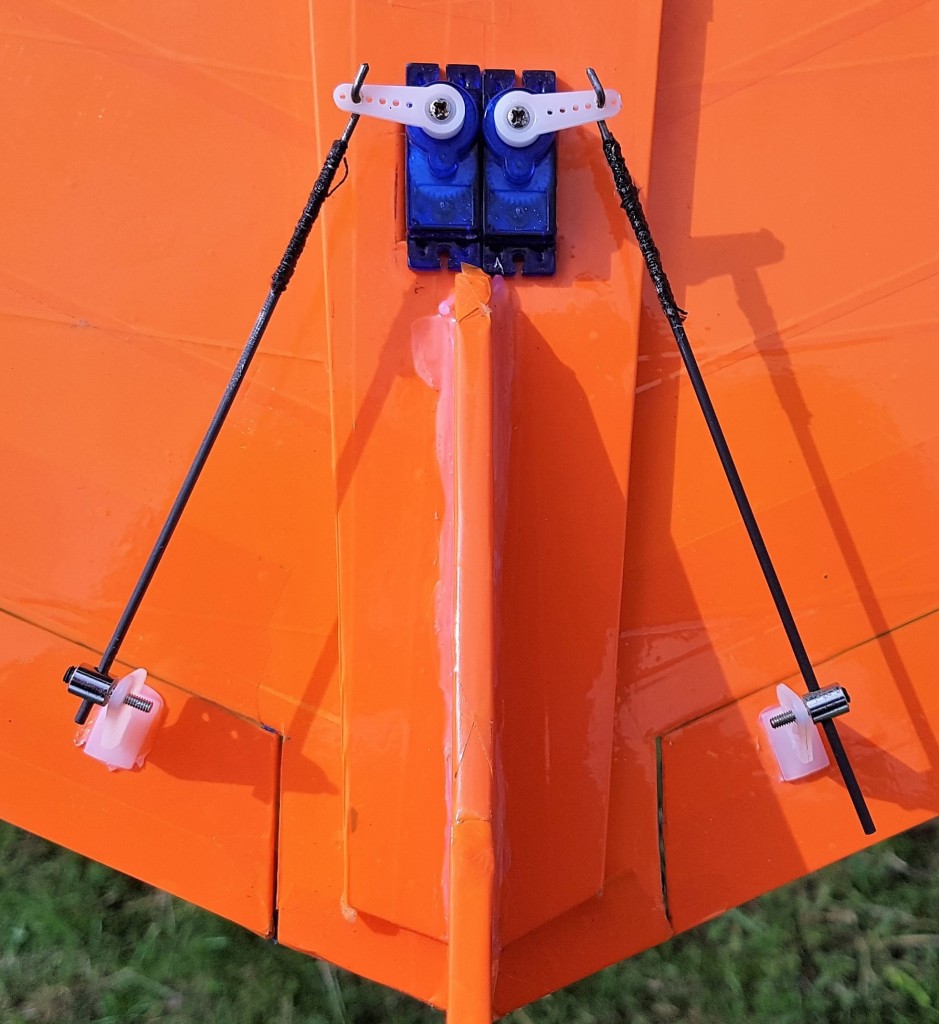 It seems to fly just like the original which is unsurprising as 1066 has fitted the same motor etc.
It seems to fly just like the original which is unsurprising as 1066 has fitted the same motor etc.
Dougal Entendre has finally got around to finishing the Freewing Moray that he bought some time ago from Alibaba in China. The Moray is intended to be flown on a 4 cell 1600mAh lipo using a 1400Kv motor but Dougal wanted to use his 3 cell 2200mAh packs so he has fitted a suitable 1800Kv motor instead and it flies very well.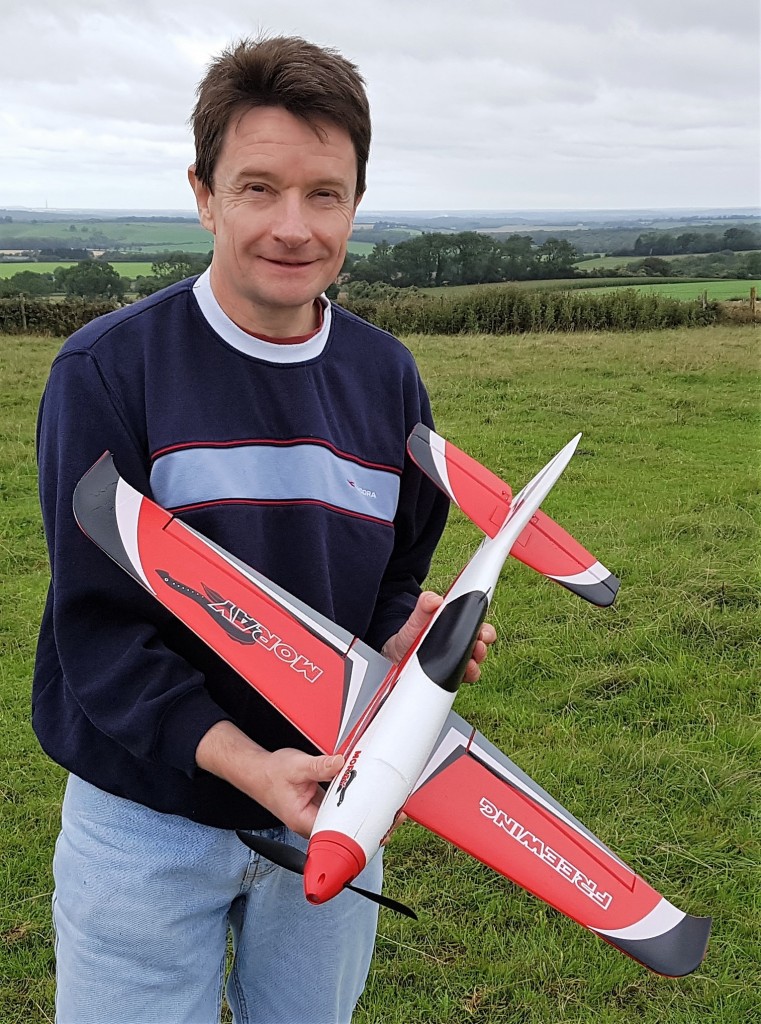
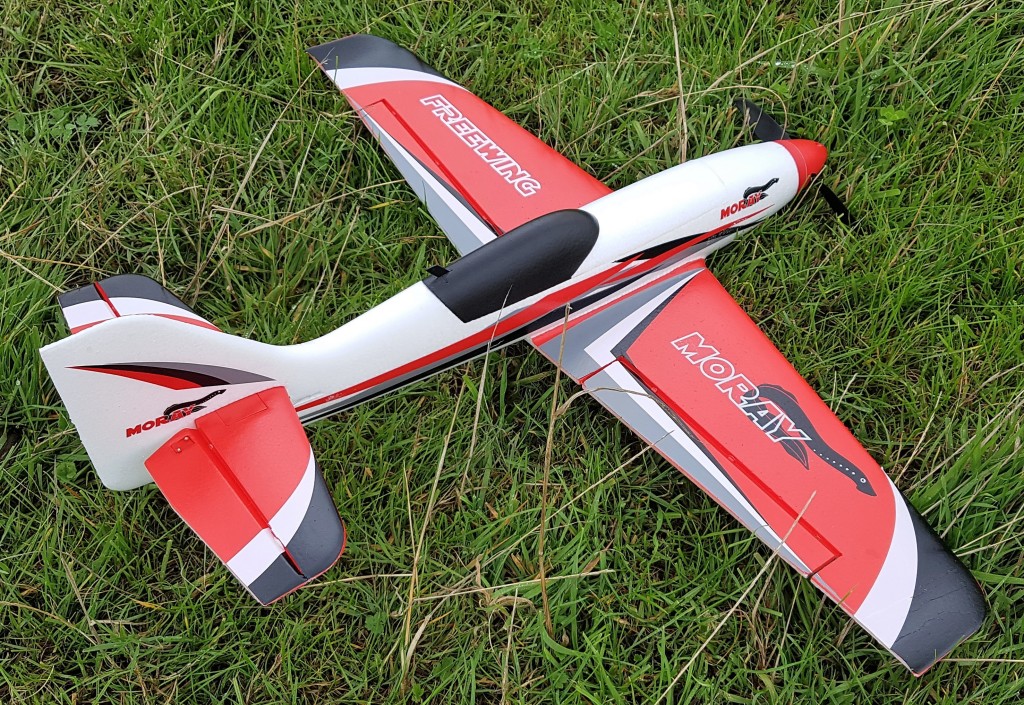 Some of the first flight can be seen in this month’s video and all went well. Unfortunately the second flight didn’t!
Some of the first flight can be seen in this month’s video and all went well. Unfortunately the second flight didn’t! It was flying perfectly until Dougal decided to check the stall and, despite having ample height, the Moray didn’t recover as expected and crashed. At the time of writing the cause is undetermined but the damage didn’t look too bad so hopefully Dougal will soon have it repaired and flying again.
It was flying perfectly until Dougal decided to check the stall and, despite having ample height, the Moray didn’t recover as expected and crashed. At the time of writing the cause is undetermined but the damage didn’t look too bad so hopefully Dougal will soon have it repaired and flying again.
Chris P Bacon visited the BMFA Nationals over the Bank Holiday weekend and sent me some photos of the event.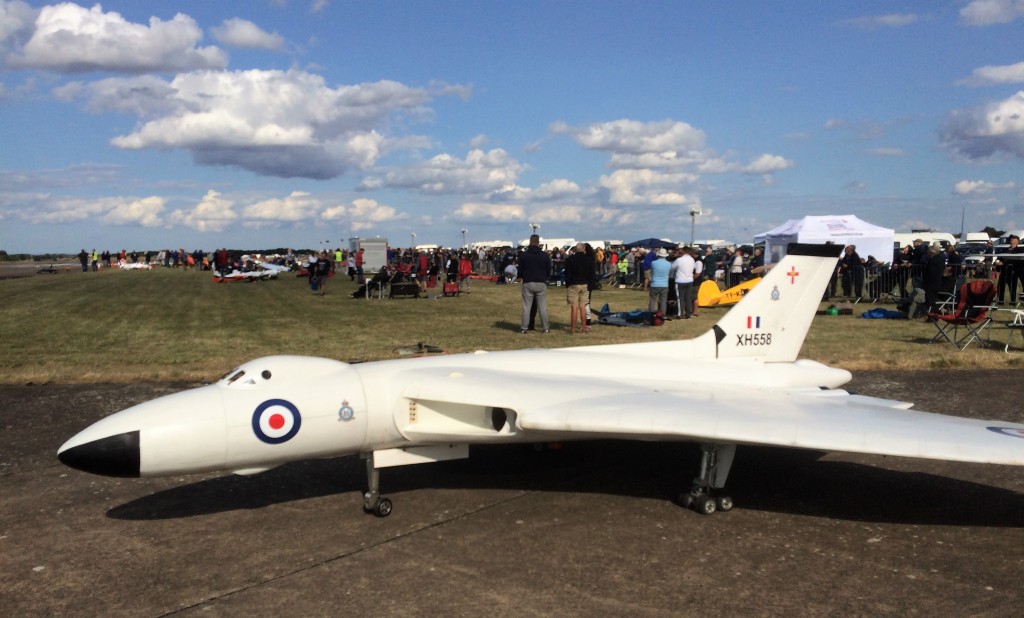
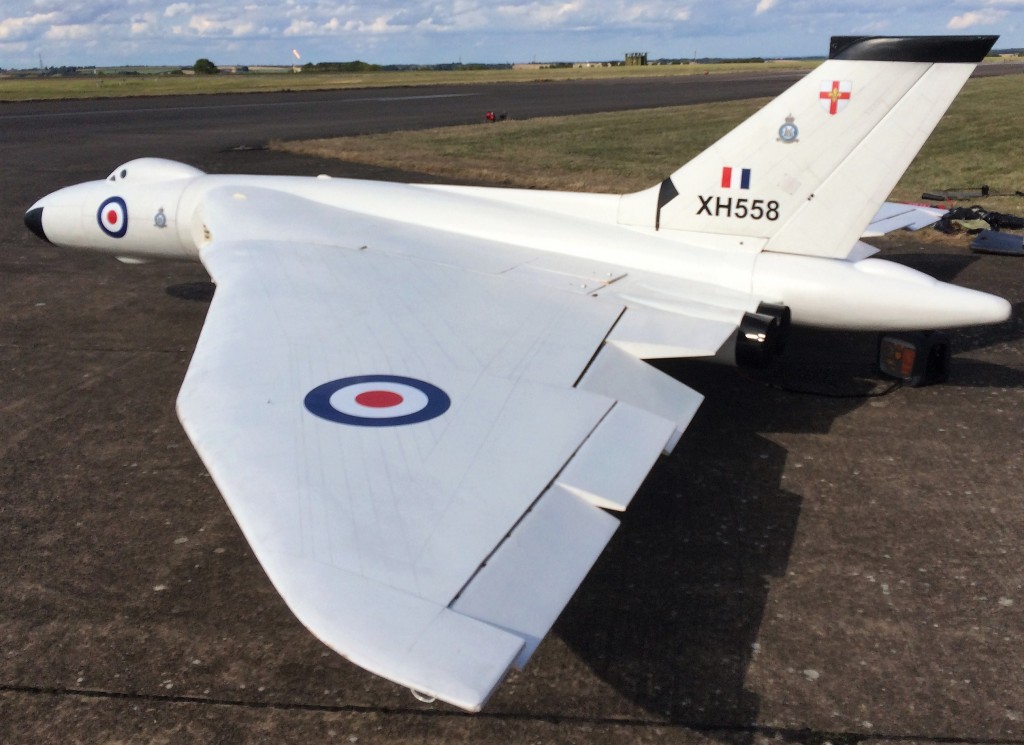
 He says the Vulcan had incredible presence in the sky but he didn’t feel the same about the Lanc. Maybe I’ve been flying electric too long but for me the petrol engines used in most WW2 models always sound terrible and with 4 of them in the Lanc I don’t think it would ever impress me. The jet turbines in the Vulcan just sound like…jet turbines.
He says the Vulcan had incredible presence in the sky but he didn’t feel the same about the Lanc. Maybe I’ve been flying electric too long but for me the petrol engines used in most WW2 models always sound terrible and with 4 of them in the Lanc I don’t think it would ever impress me. The jet turbines in the Vulcan just sound like…jet turbines. Chris P said the ailerons on the fun-fly model were the biggest he’s seen, I imagine they can be drooped a little to change the wing section for the Max Glide part of the competition, hence the size.
Chris P said the ailerons on the fun-fly model were the biggest he’s seen, I imagine they can be drooped a little to change the wing section for the Max Glide part of the competition, hence the size.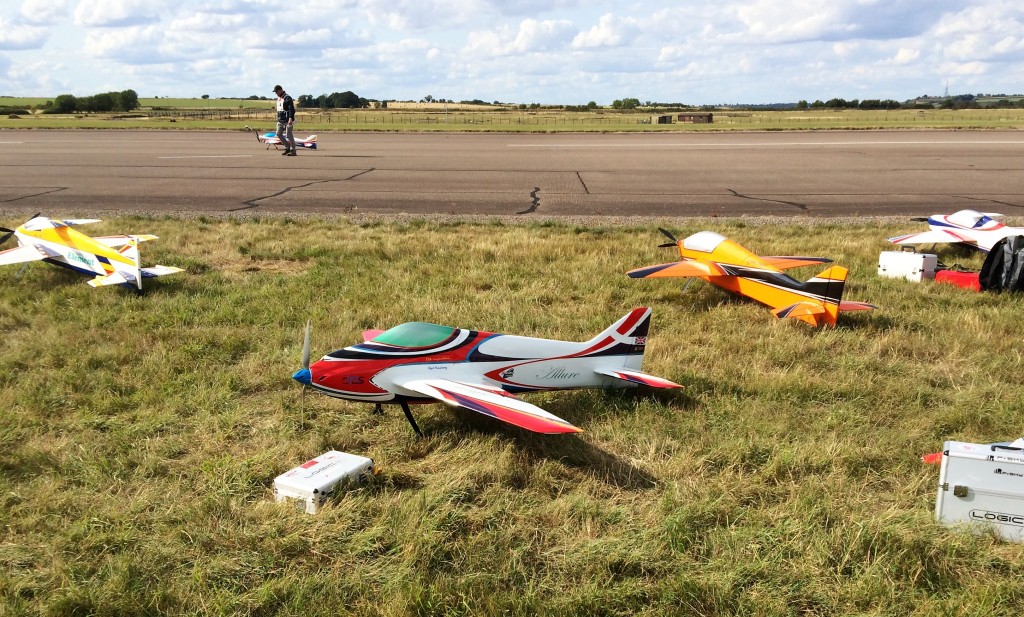 He also said all the F3A aerobatic models were electric powered and used 10 cell lipo packs to give the performance. Nice! Thanks for the photos Chris P, more of us should make the effort to visit the Nats next year.
He also said all the F3A aerobatic models were electric powered and used 10 cell lipo packs to give the performance. Nice! Thanks for the photos Chris P, more of us should make the effort to visit the Nats next year.
Thanks to Kryton, Captain Slow, and Dougal Entendre for pics & video contributions; here’s this month’s video:
Please watch the video full screen, it’s so much better with small models flying around. If the video won’t play for you CLICK HERE
This month’s closing chortle is a photo that I stole from Dougal’s Facebook page. ‘Two planes sharing a joke’ 
Colin Cowplain
Patch News – July 2018
There seems little point starting this Patch News in the usual manner of talking about how the weather treated us…every single day was hot and sunny, too hot for many of us! Of course the grass has barely grown at all so there’s been no work for the Friday Afternoon Rural Trimming Society (FARTS) to do. The bullocks made a brief appearance before returning to the lower field but barely approached us anyway, I think it was too hot for them to bother.
A few PAM members attended the Southern Area BMFA Southern Gala at Middle Wallop on 7th July. Dougal Entendre flew his Mini Blitz and large Spad, and I flew my little Sharkface. I’ve included some footage of Dougal’s Spad flying in this month’s video, it’s an impressive model. There were some interesting models present and I was particularly taken by Mike Spencer’s Swannee, a model that I can remember being a free plan back in 1966.
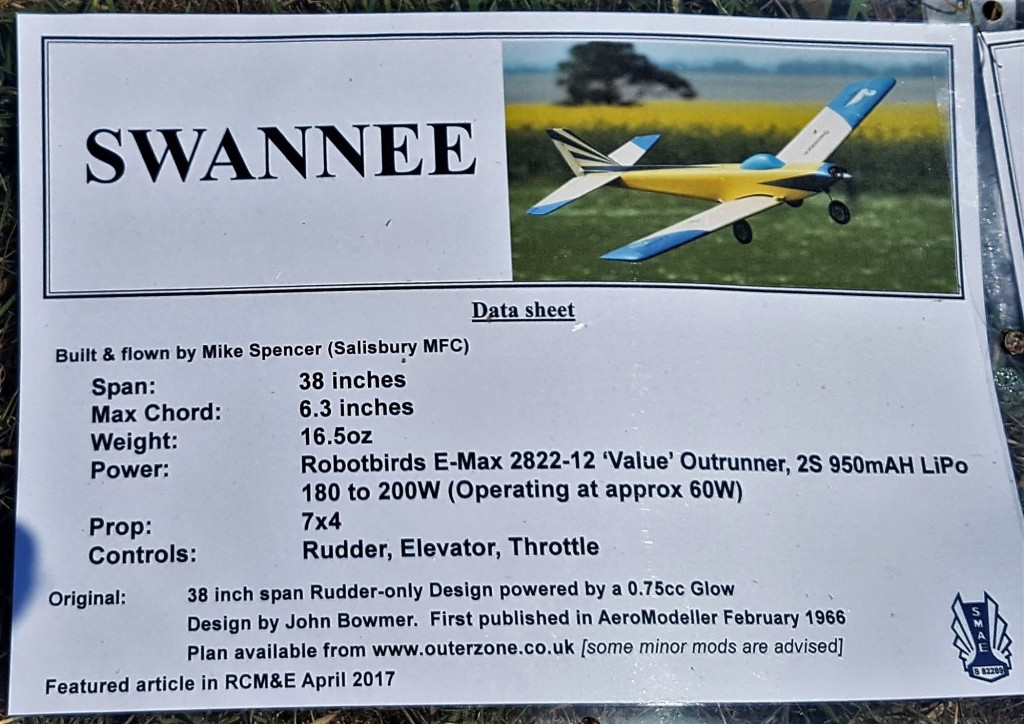 The Swannee was designed for single channel radio with ‘rudder only’ control and it was very unusual in that it was a low winger, almost unheard of for rudder only. At the time I was as school with current PAM member Kryten and as his real name is Graham Swan he felt obliged to build one! I was desperate to have a radio set but couldn’t afford one from my pocket money so my parents said I could either go on the two week school trip to Italy or have the radio set, you know which I chose! Kryten and I each bought an RCS Guidance System made by Radio Control Specialists Ltd, I think the cost was around £17. Although we both sold the radios many years ago Kryten still has the box and instruction pamphlet from his and he was good enough to send me some photos.
The Swannee was designed for single channel radio with ‘rudder only’ control and it was very unusual in that it was a low winger, almost unheard of for rudder only. At the time I was as school with current PAM member Kryten and as his real name is Graham Swan he felt obliged to build one! I was desperate to have a radio set but couldn’t afford one from my pocket money so my parents said I could either go on the two week school trip to Italy or have the radio set, you know which I chose! Kryten and I each bought an RCS Guidance System made by Radio Control Specialists Ltd, I think the cost was around £17. Although we both sold the radios many years ago Kryten still has the box and instruction pamphlet from his and he was good enough to send me some photos.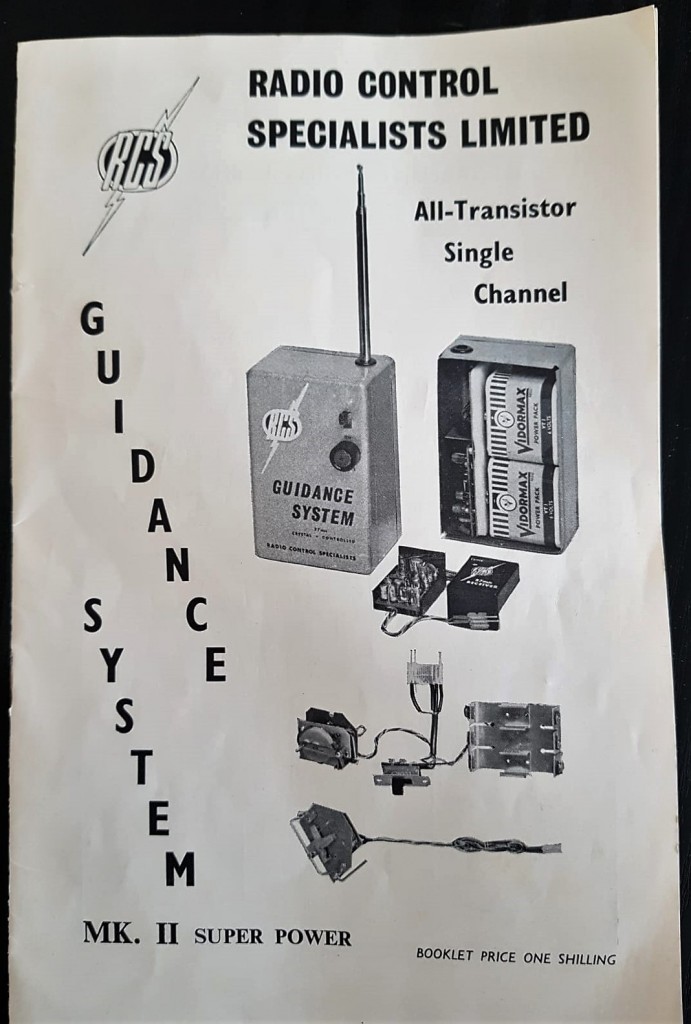
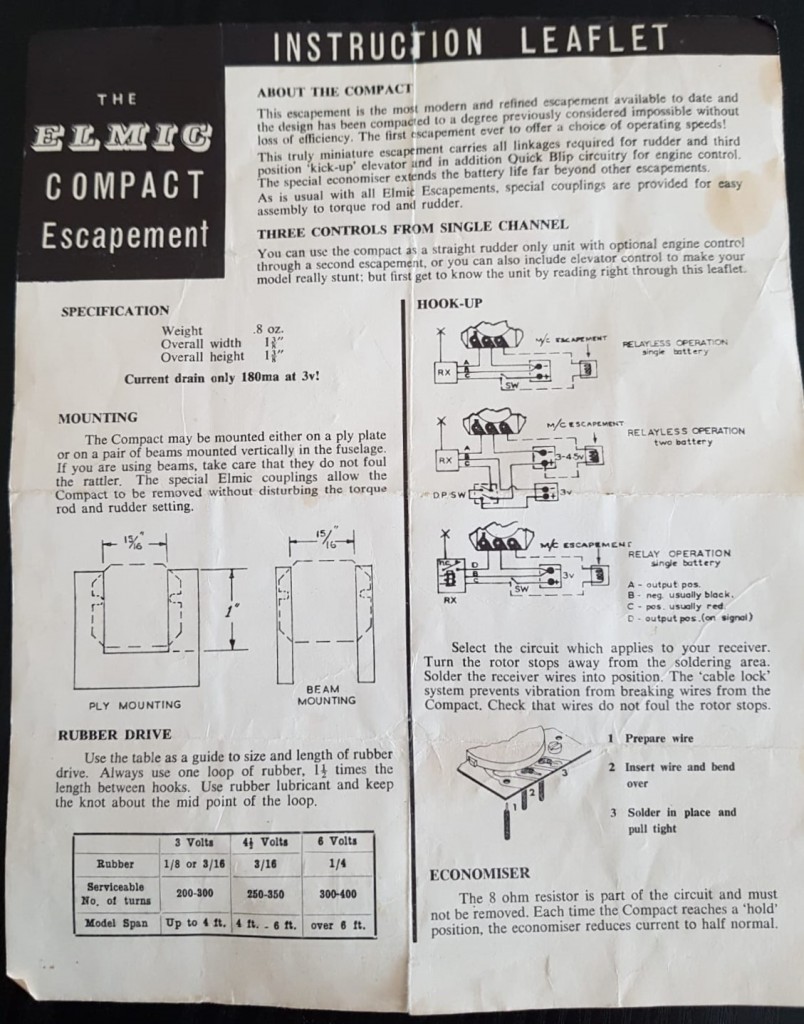 Those were the days! Mike Spencer’s Swannee is 3 channel, rudder, elevator, and throttle, and of course it has an electric motor instead of a small glow-plug or diesel engine. For control he uses a modified RCS 10 channel (for a maximum of 5 surfaces in 2 directions each) reed set. Reeds set were what wealthy people used before modern ‘proportional’ radio sets were invented and instead of sticks they had sprung loaded toggle switches for each control.
Those were the days! Mike Spencer’s Swannee is 3 channel, rudder, elevator, and throttle, and of course it has an electric motor instead of a small glow-plug or diesel engine. For control he uses a modified RCS 10 channel (for a maximum of 5 surfaces in 2 directions each) reed set. Reeds set were what wealthy people used before modern ‘proportional’ radio sets were invented and instead of sticks they had sprung loaded toggle switches for each control.
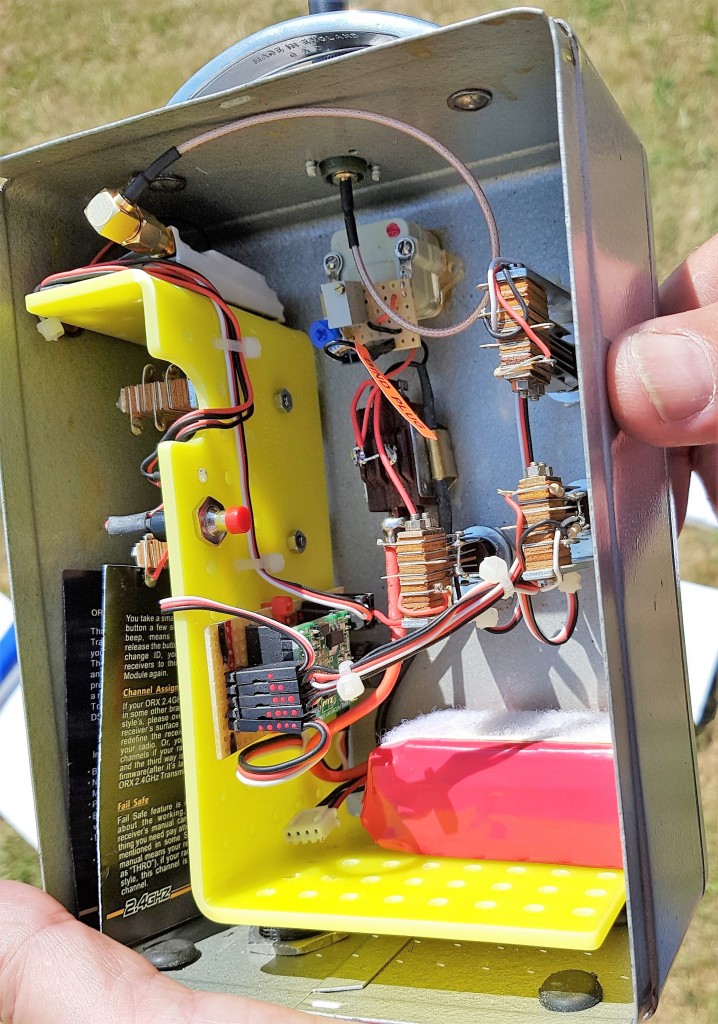 To turn left you pushed the aileron switch to the left in a series of pulses to achieve the radius of turn you wanted. Mike’s set has been converted to 2.4GHz but retains the reed switches and the model flew well, unlike Kryten’s original single channel version that he recalls as being awful!
To turn left you pushed the aileron switch to the left in a series of pulses to achieve the radius of turn you wanted. Mike’s set has been converted to 2.4GHz but retains the reed switches and the model flew well, unlike Kryten’s original single channel version that he recalls as being awful!
Back to our patch now and Page Boy brought along his Dawn Flyer to test. The Dawn Flyer was designed by Lindsay Todd who describes it as ‘a latticework lightweight that summons the spirit of aviation’s pioneering age’.
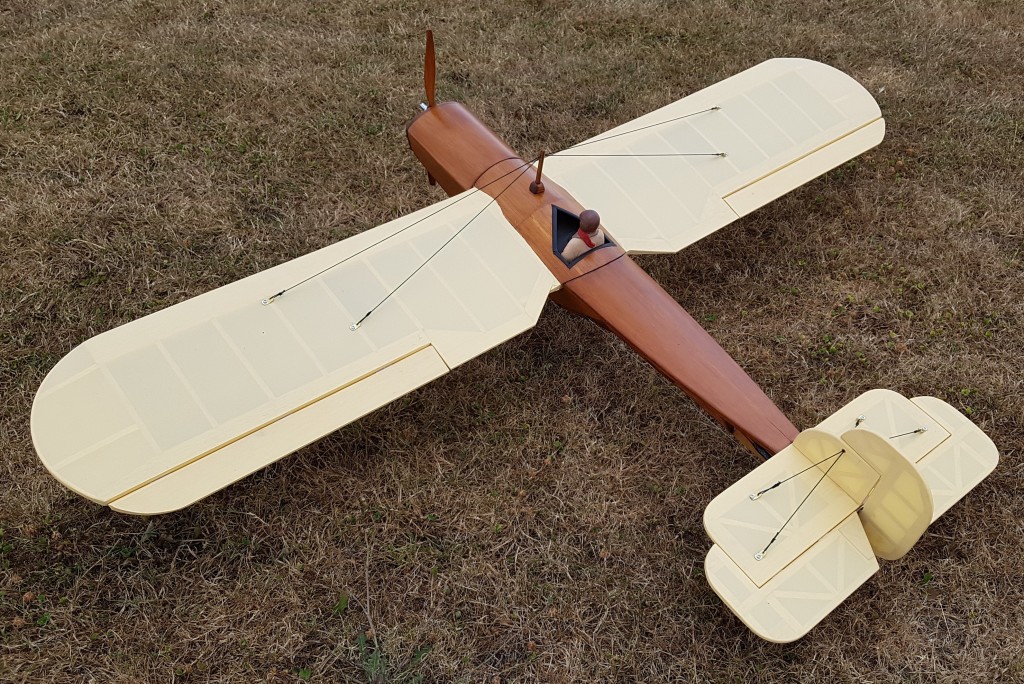 It was featured in RCM&E in July 2013 and Page Boy bought the plan and CNC cut wood parts from Sarik Hobbies. He has fitted a Turnigy 3536 1250Kv motor coupled to a 3 cell 2200mAh NanoTech lipo via a Hobbywing 40A esc.
It was featured in RCM&E in July 2013 and Page Boy bought the plan and CNC cut wood parts from Sarik Hobbies. He has fitted a Turnigy 3536 1250Kv motor coupled to a 3 cell 2200mAh NanoTech lipo via a Hobbywing 40A esc.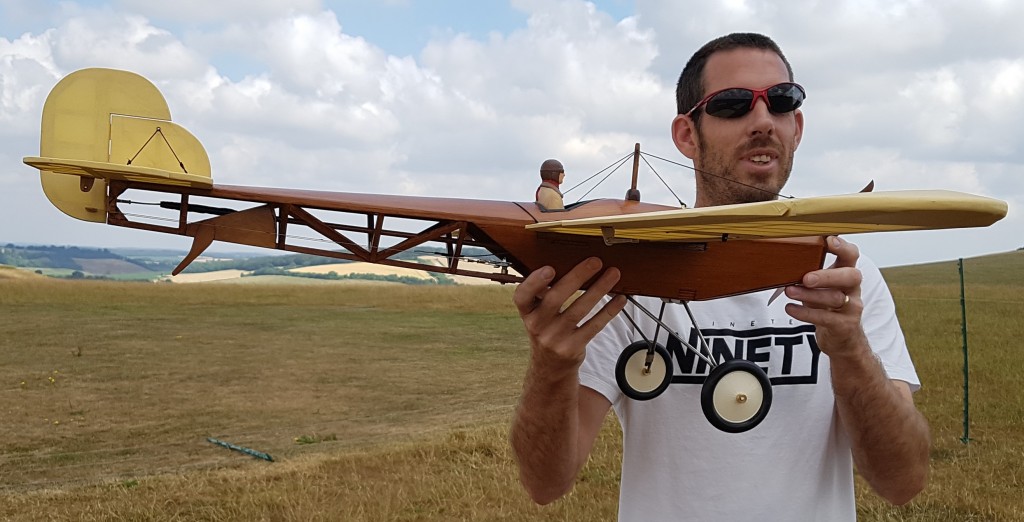
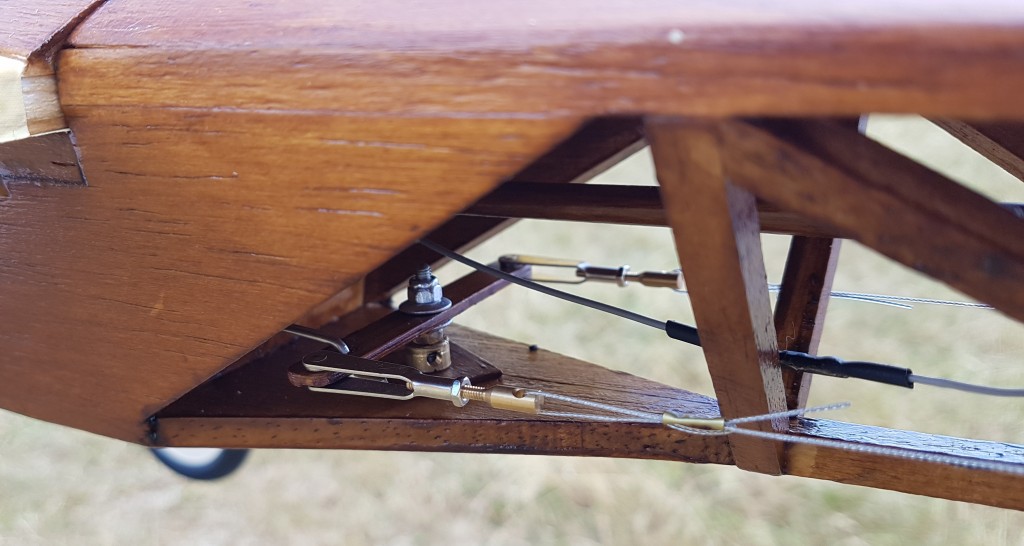
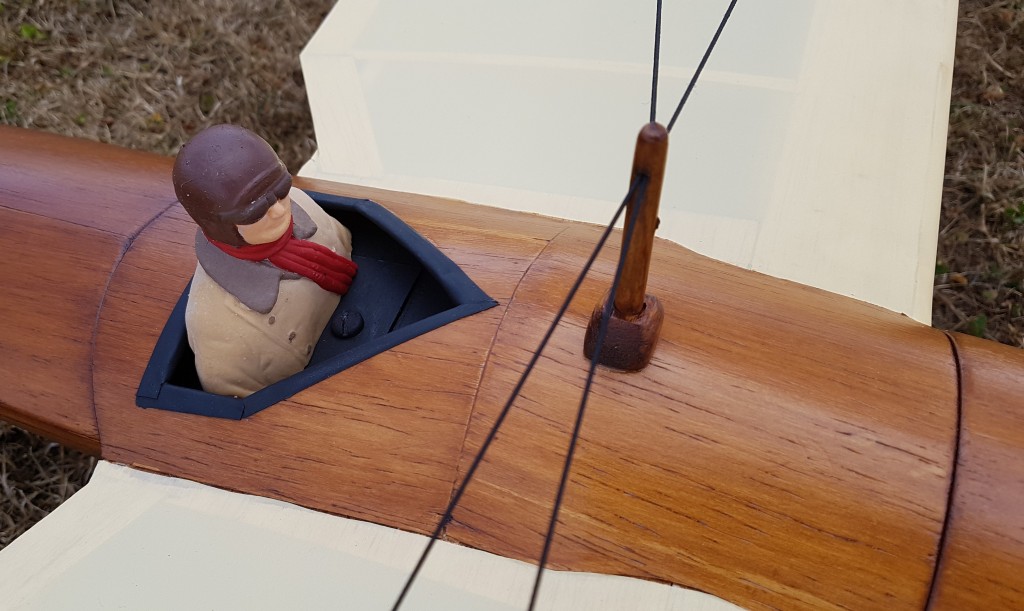 The servos are Turnigy MG14 9g digitals. As you can see he has made a lovely job of building the model and covering it in Solartex, it really does look amazing. So how did it fly? Beautifully of course, but no need to take my word for it, you can see it in the video later.
The servos are Turnigy MG14 9g digitals. As you can see he has made a lovely job of building the model and covering it in Solartex, it really does look amazing. So how did it fly? Beautifully of course, but no need to take my word for it, you can see it in the video later.
Next up is Bob the Builder’s latest creation, a Dragon! It seems his New Zealand based grandson loves dragons so when Bob saw a plan for a Bat in the May 2016 RCM&E he made some changes to make it more dragon like. 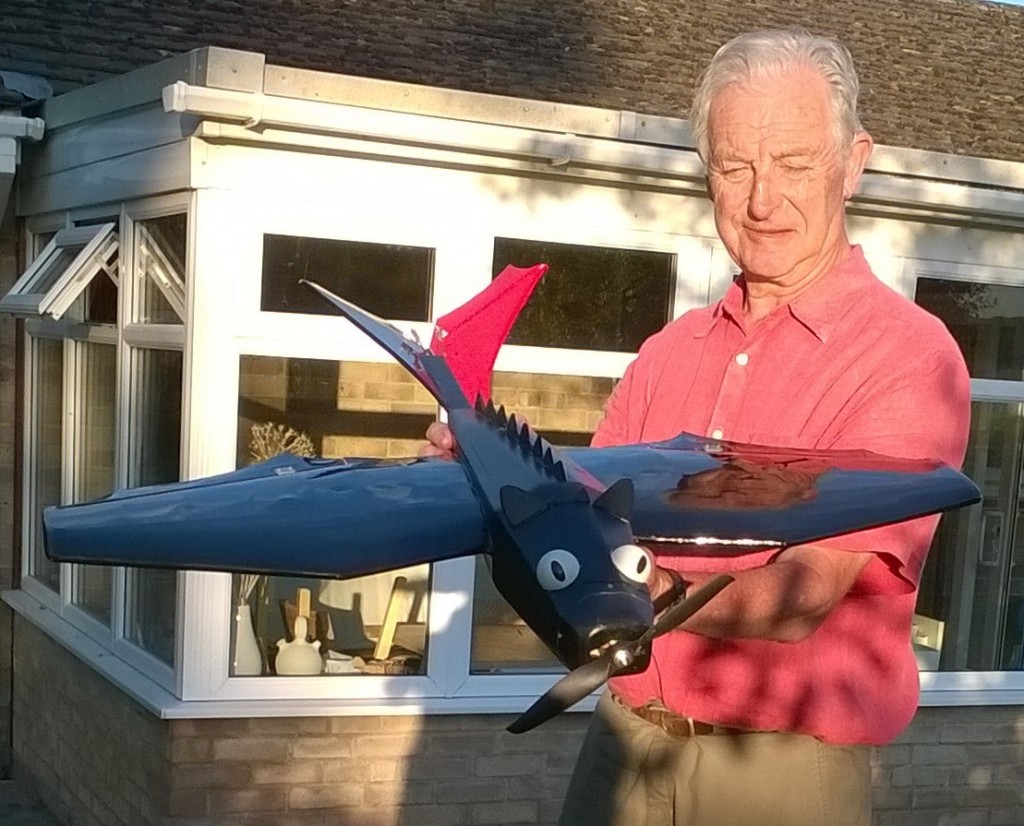 The main change was to do away with the normal tailplane and fin, opting instead to design his own V-tail. He added half table tennis balls for eyes and has fitted LEDs under them and also fitted LEDs in the mouth.
The main change was to do away with the normal tailplane and fin, opting instead to design his own V-tail. He added half table tennis balls for eyes and has fitted LEDs under them and also fitted LEDs in the mouth.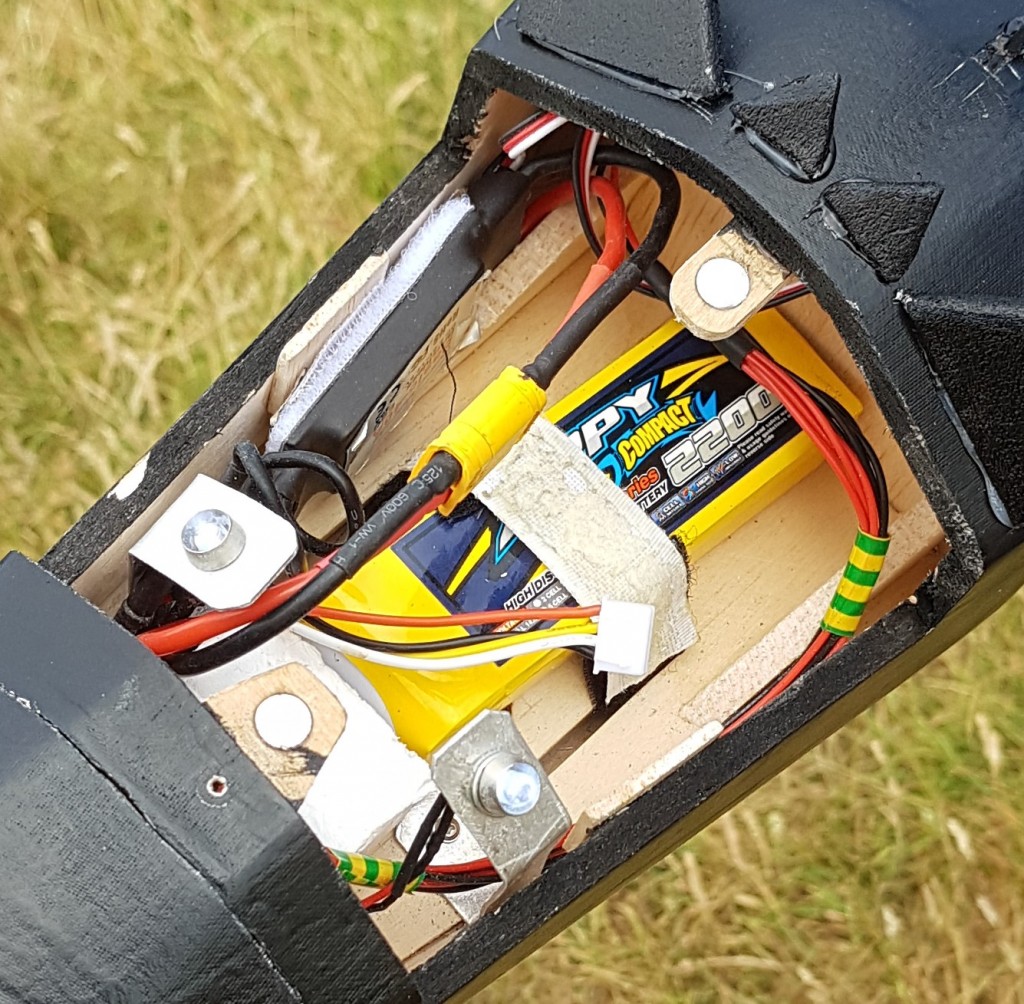 The Dragon wingspan is 36″ and the flying weight with a 2200mAh 3s battery is 2kg. The Hobbyking 2836 1400Kv PropDrive motor is fed via a 40A esc and swings a 9×6 prop. The Dragon is all balsa construction, the fuselage is covered with glass-cloth and Easykote, and the wings are film covered. Originally the whole model was black apart from one half of the V-tail which is red but as I discovered on the first flight the orientation was a major problem.
The Dragon wingspan is 36″ and the flying weight with a 2200mAh 3s battery is 2kg. The Hobbyking 2836 1400Kv PropDrive motor is fed via a 40A esc and swings a 9×6 prop. The Dragon is all balsa construction, the fuselage is covered with glass-cloth and Easykote, and the wings are film covered. Originally the whole model was black apart from one half of the V-tail which is red but as I discovered on the first flight the orientation was a major problem. There is no dihedral at all and the all black wing proved very difficult to see. As you can see in the video the first flight only lasted a few seconds before I lost orientation. Fortunately the damage wasn’t too bad and Bob added some white trim on the underside of the wings for the second flight. Orientation was much better and the Dragon flew well although I think it could still do with a bit more trim to help. Overall is now flies nicely and is certainly different, it looks good in the air. All Bob needs to do now is fly it in the dark so the lights can be seen…
There is no dihedral at all and the all black wing proved very difficult to see. As you can see in the video the first flight only lasted a few seconds before I lost orientation. Fortunately the damage wasn’t too bad and Bob added some white trim on the underside of the wings for the second flight. Orientation was much better and the Dragon flew well although I think it could still do with a bit more trim to help. Overall is now flies nicely and is certainly different, it looks good in the air. All Bob needs to do now is fly it in the dark so the lights can be seen…
Here is the latest of many that 1066 has fiddled won in the Big Raffle, an Evans Volksplane VP-1 from HobbyKing.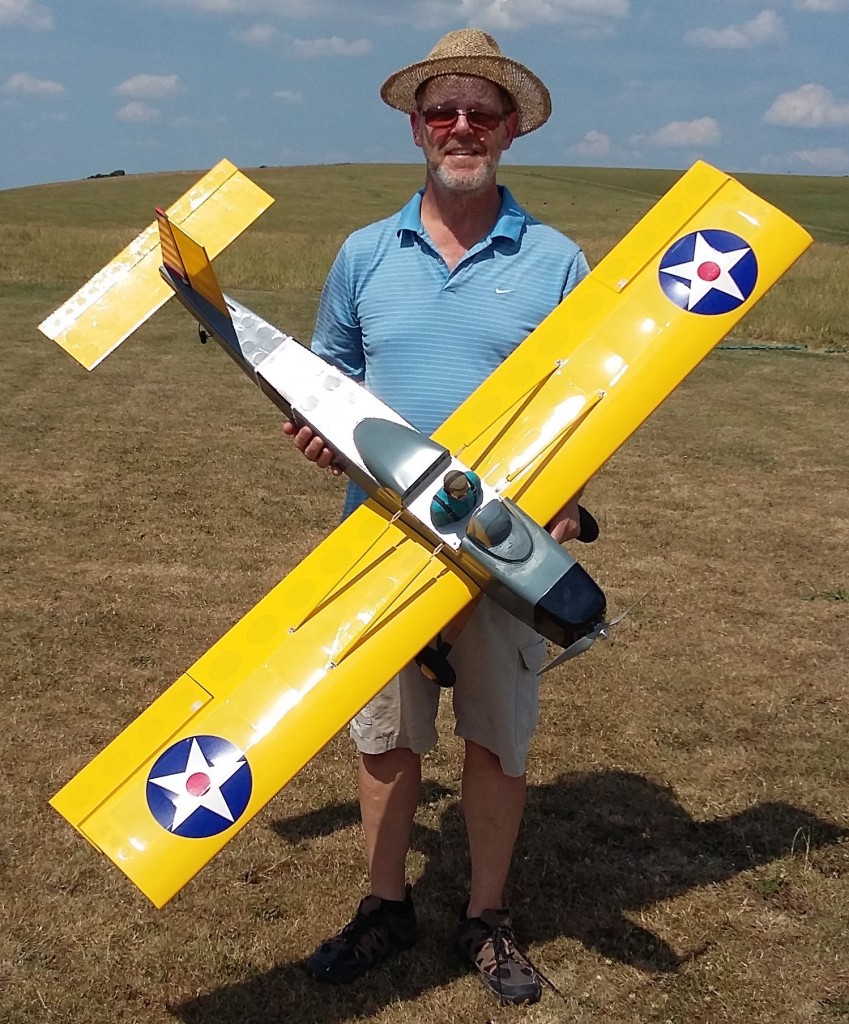 This balsa built-up electric monoplane has a detailed instrument panel inside an open cockpit, pilot bust, and control surfaces with large counterbalances built in. Here’s what Hobbyking has to say about it: Enjoy simple, traditional flying that has lasted generations. The Volksplane design was first created by aeronautical engineer William Evans in 1968 and has delighted hobbyists ever since. This yellow and grey US Version is made of lightweight balsa and plywood, featuring a printed PVC covering.
This balsa built-up electric monoplane has a detailed instrument panel inside an open cockpit, pilot bust, and control surfaces with large counterbalances built in. Here’s what Hobbyking has to say about it: Enjoy simple, traditional flying that has lasted generations. The Volksplane design was first created by aeronautical engineer William Evans in 1968 and has delighted hobbyists ever since. This yellow and grey US Version is made of lightweight balsa and plywood, featuring a printed PVC covering.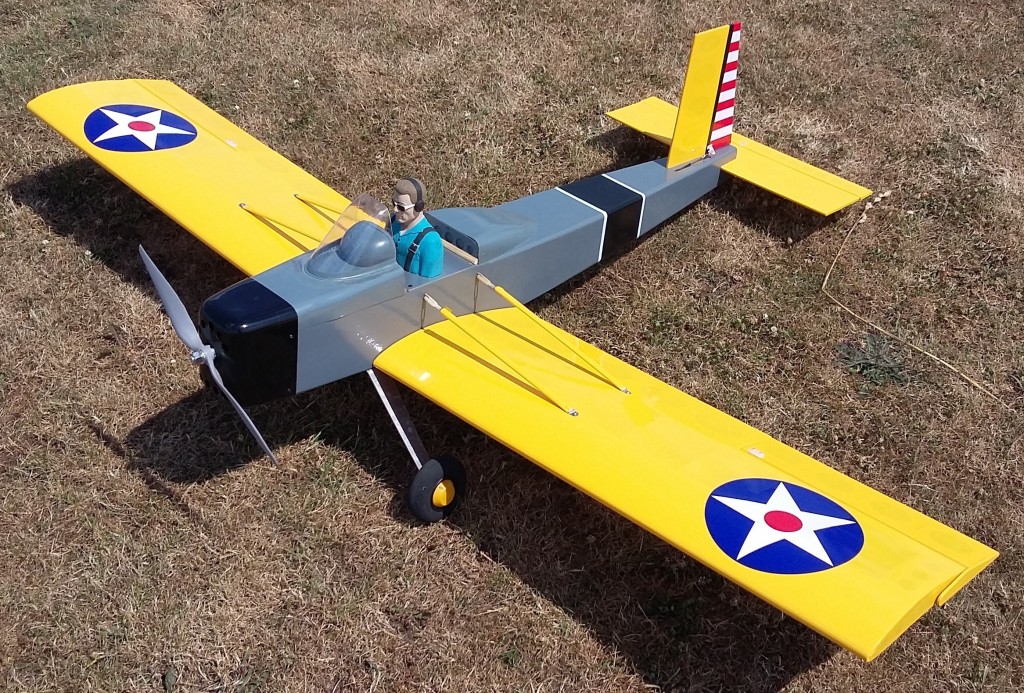
 The 62.9” span Volksplane is an almost ready to fly kit from VQ models and some assembly is required, although the parts count is low. 1066 has fitted an NTM 4250 650Kv PropDrive motor which swings a 13×6 prop, and uses a 4 cell lipo via an 80A esc with a separate BEC. He said it was horrible on the first flight but then realised what he’d done. To set the control throws he had simply copied over the settings of another model on the transmitter without thinking too much. The model he had copied was one of his 3D machines so he was flying with 90% expo on the ailerons, about 60% too much for the Volksplane! Once he’d sorted out the settings properly it was much nicer to fly as you can see in the video.
The 62.9” span Volksplane is an almost ready to fly kit from VQ models and some assembly is required, although the parts count is low. 1066 has fitted an NTM 4250 650Kv PropDrive motor which swings a 13×6 prop, and uses a 4 cell lipo via an 80A esc with a separate BEC. He said it was horrible on the first flight but then realised what he’d done. To set the control throws he had simply copied over the settings of another model on the transmitter without thinking too much. The model he had copied was one of his 3D machines so he was flying with 90% expo on the ailerons, about 60% too much for the Volksplane! Once he’d sorted out the settings properly it was much nicer to fly as you can see in the video.
Earlier I talked about Page Boy’s Dawn Flyer but he also had a maiden flight with his FMS Edge 540. He actually brought the Edge up to the patch in July 2016 but didn’t fly it and didn’t bring it out again until now. The 1320mm span model is made from EPO foam and weighs 1.7kg with its 4 cell Turnigy NanoTech 2650mAh battery. It comes ready fitted with an FMS3948-750Kv motor, a Turnigy Plush 60A esc, and 4 x 17g metal geared digital servos.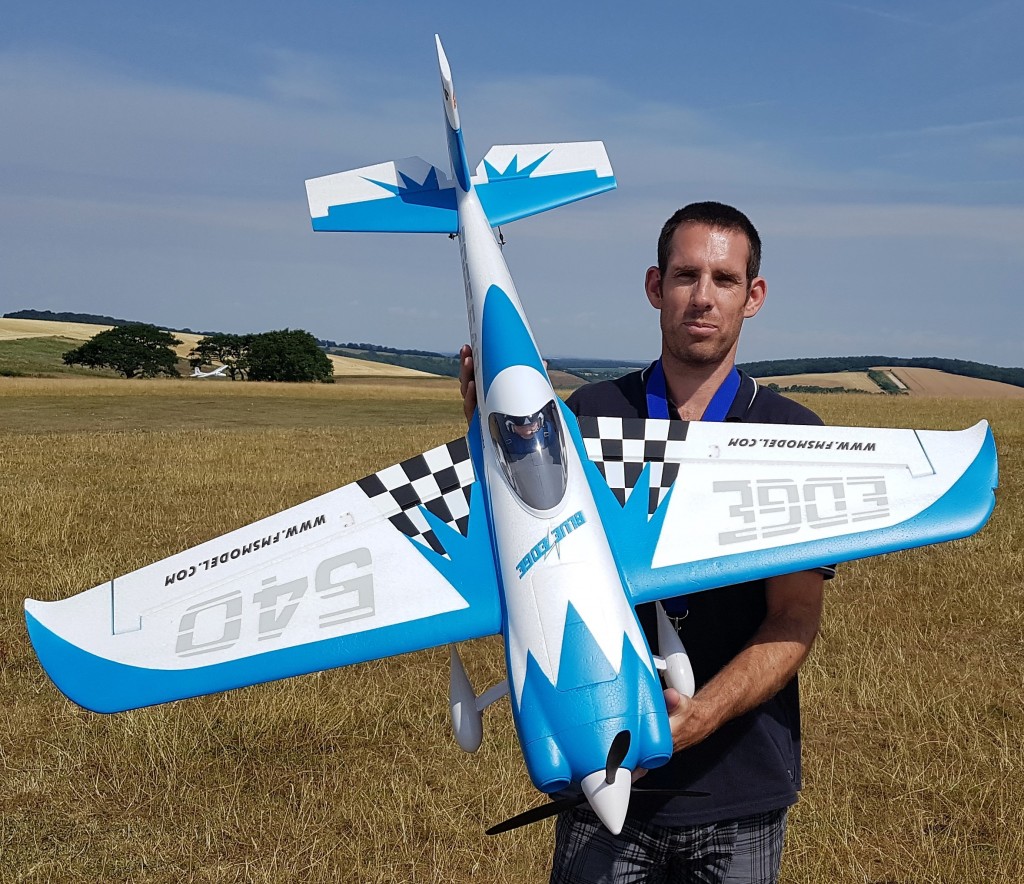
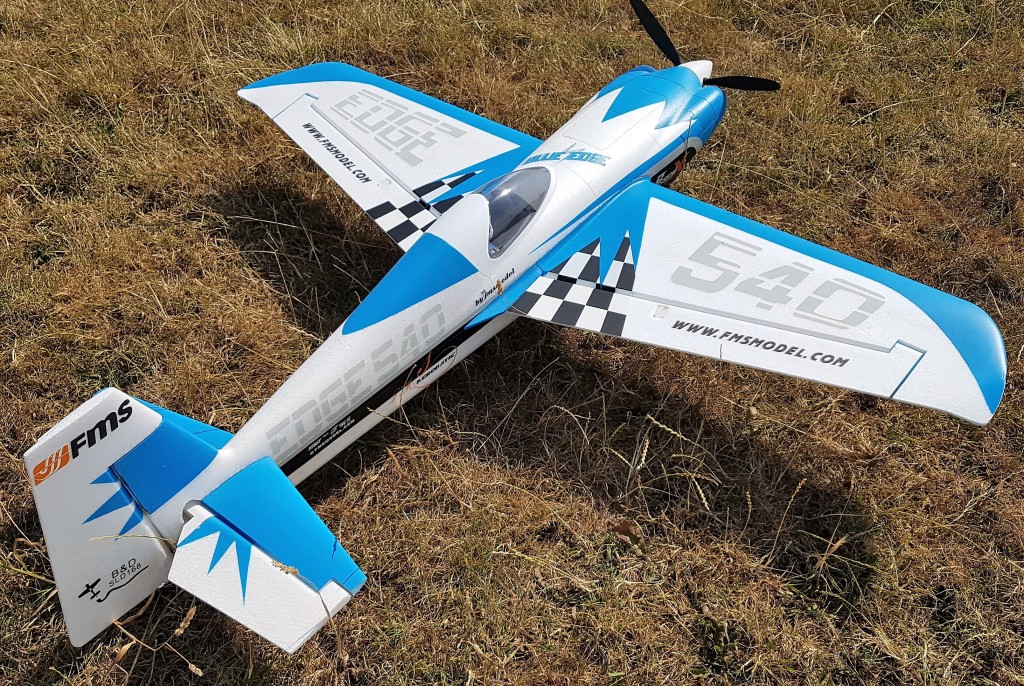 Unusually it all comes with a 3 bladed 13×5 prop and matching spinner. The Edge flew perfectly well as expected but it seemed to lack the power you’d expect (and need) for the all the usual 3D manoeuvres.
Unusually it all comes with a 3 bladed 13×5 prop and matching spinner. The Edge flew perfectly well as expected but it seemed to lack the power you’d expect (and need) for the all the usual 3D manoeuvres.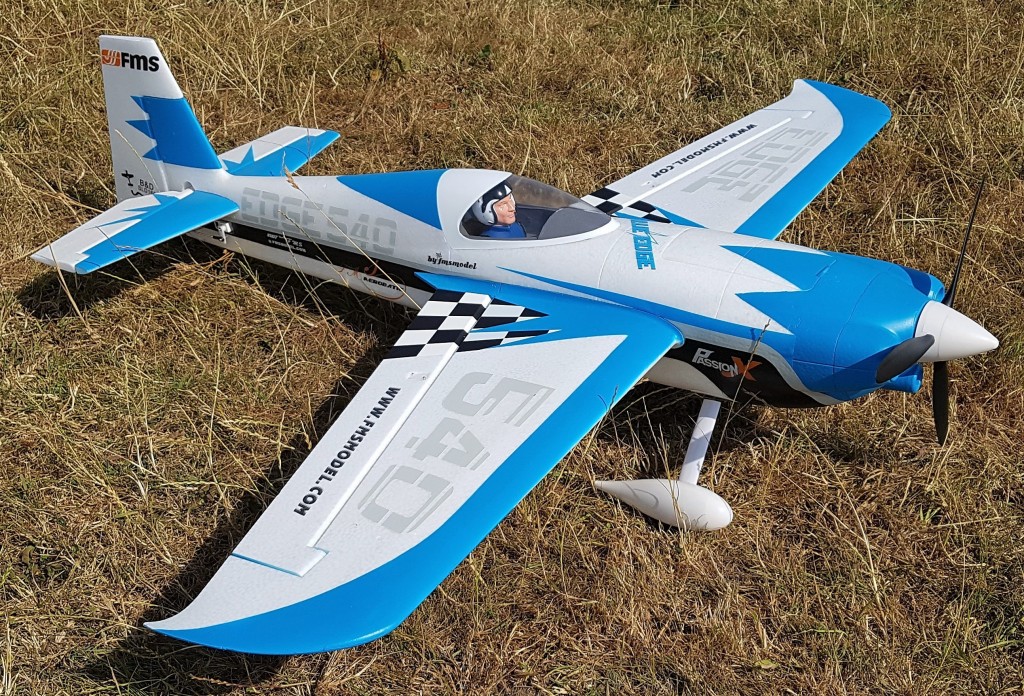 I’ve watched the FMS marketing video of the Edge and it has loads of power, certainly more than Page Boy’s. As it comes with all the powertrain already fitted the only think we could think of was that Page Boy’s batteries aren’t up to the job. Has anyone got any high C rated 4 cell packs that he could try?
I’ve watched the FMS marketing video of the Edge and it has loads of power, certainly more than Page Boy’s. As it comes with all the powertrain already fitted the only think we could think of was that Page Boy’s batteries aren’t up to the job. Has anyone got any high C rated 4 cell packs that he could try?
Page Boy also had a couple of flights with his Dynam Hurricane in July. He hasn’t flown it for a while and in the meantime has replaced the retracts with some much sturdier metal ones from HobbyKing.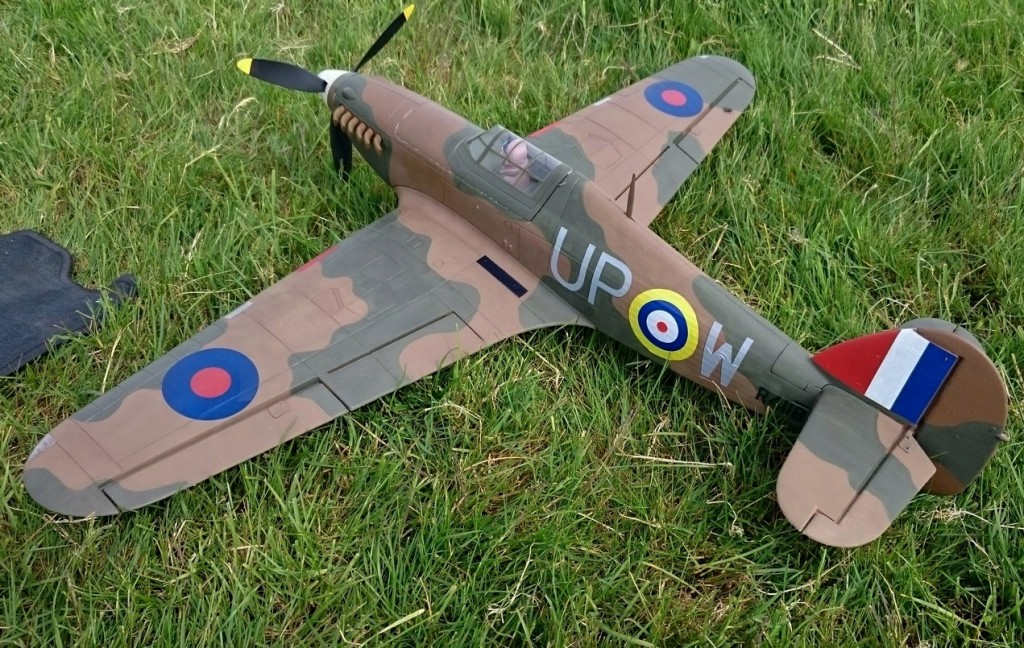
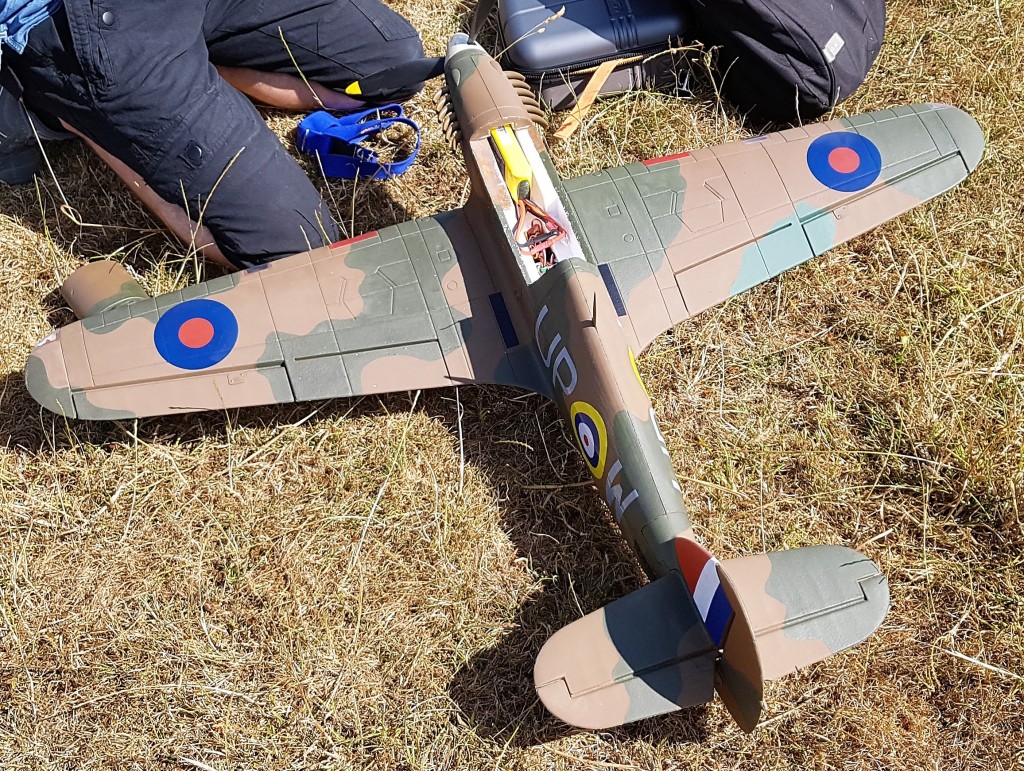 They worked perfectly and I shot some video of the flights which I’ll include next month.
They worked perfectly and I shot some video of the flights which I’ll include next month.
The latest club member, Mike Critchley, has been practising hard for his BMFA ‘A’ cert since joining PAM. Mike is a member of MVSA and is used to flying gliders but wants to fly power models so he’s bought a Wot-4 Foam-E.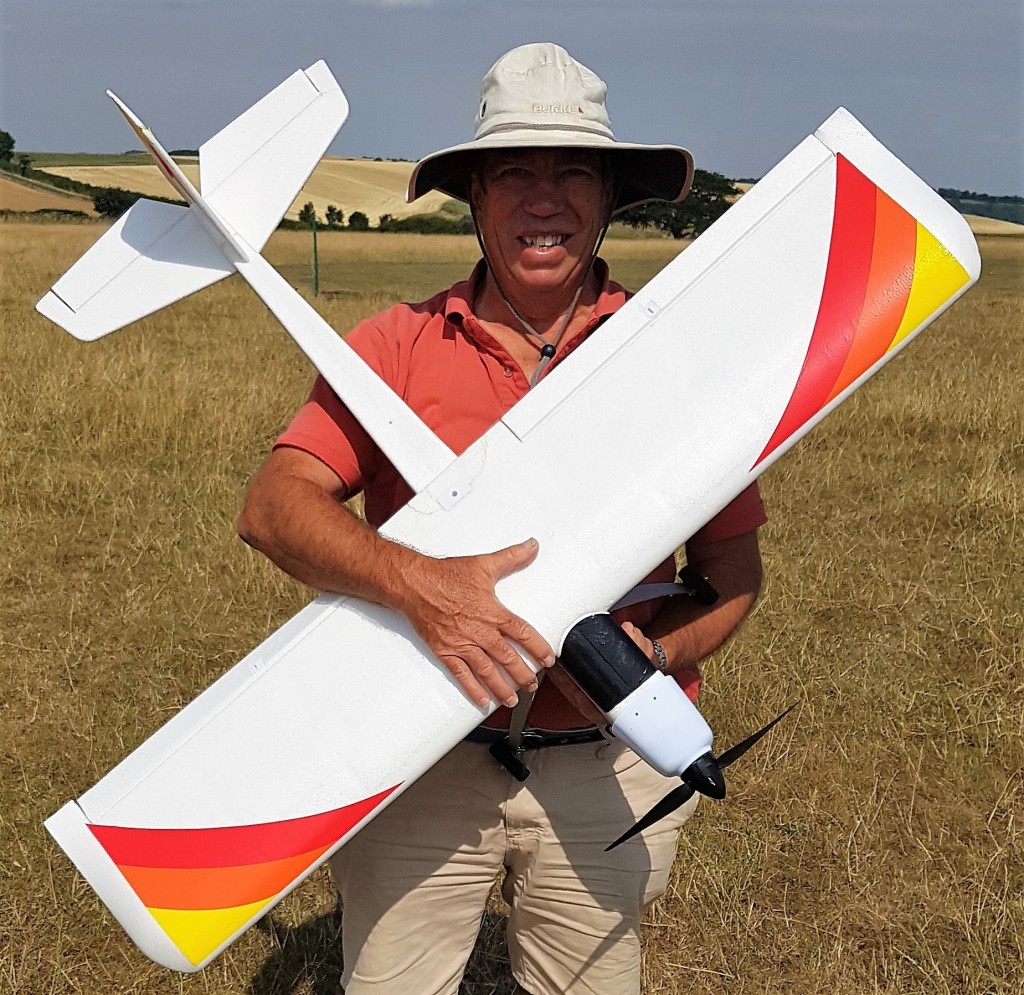 The Wot-4 is probably the perfect trainer for him but he also has an electric Multiplex Easy Glider that he’s been flying at the field, obviously a man of great taste and impeccable style!
The Wot-4 is probably the perfect trainer for him but he also has an electric Multiplex Easy Glider that he’s been flying at the field, obviously a man of great taste and impeccable style!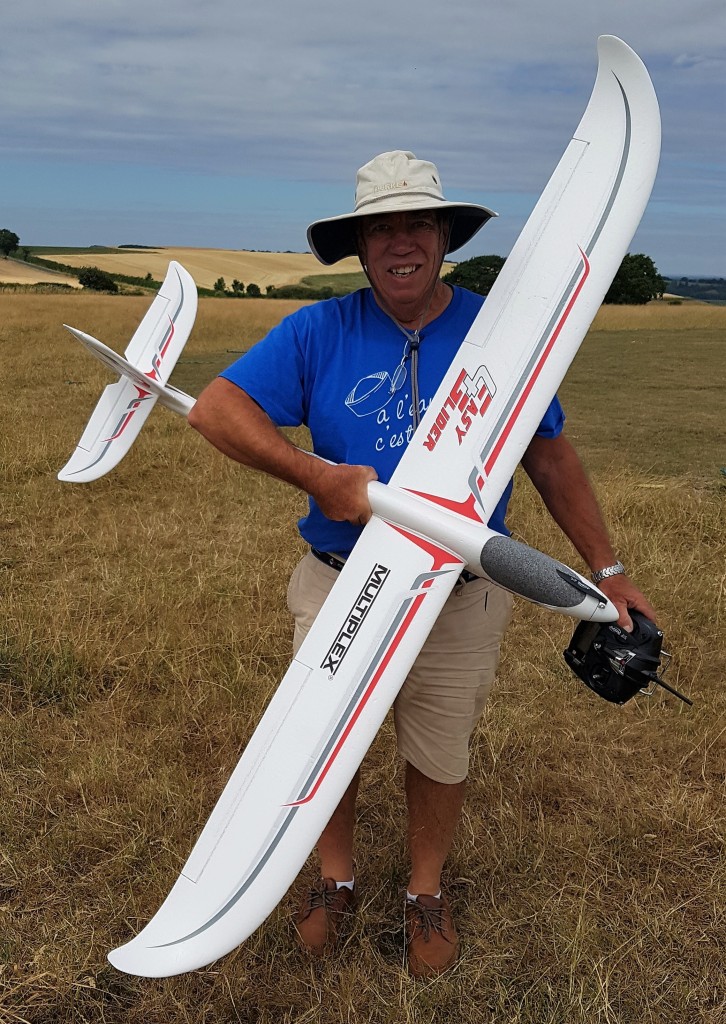 I’ve been impressed by Mike’s commitment, in July he had flight after flight just doing figure eights in preparation for the test. He’s gained second place in the Climb ‘n’ Glide comp for ‘A’ cert holders even before taking the test. But on Sunday 22nd July he took his test, even though it was probably the busiest Sunday this year with lots of pilots watching, and passed with flying colours. Dougal conducted the test and once Mike had passed the flying section Dougal gave him a good grilling on the questions. All went well and Mike is now the proud holder of his ‘A’ cert.
I’ve been impressed by Mike’s commitment, in July he had flight after flight just doing figure eights in preparation for the test. He’s gained second place in the Climb ‘n’ Glide comp for ‘A’ cert holders even before taking the test. But on Sunday 22nd July he took his test, even though it was probably the busiest Sunday this year with lots of pilots watching, and passed with flying colours. Dougal conducted the test and once Mike had passed the flying section Dougal gave him a good grilling on the questions. All went well and Mike is now the proud holder of his ‘A’ cert.
We welcomed two more new members in July, Matt Takhar and Niki Weatherley. Both already have their BMFA ‘B’ certs but hadn’t flown for a few years before joining us at the patch a couple of times during July. To get back into flying they both bought Wot-4 Foamies and Max Thrust Lightnings but they are now down to one of each! They have joined up and they will be a welcome addition to our membership.
If you read the last Patch News you’ll have seen the Chris P Bacon carelessly ‘lost’ two models within the space of a few days. Well now he has a replacement, a Ripmax Bolero, a model that is billed as ‘a high performance fun-fly aircraft with huge control surfaces for 3D flight.’ Apparently it was designed by some bloke called Alan Wood.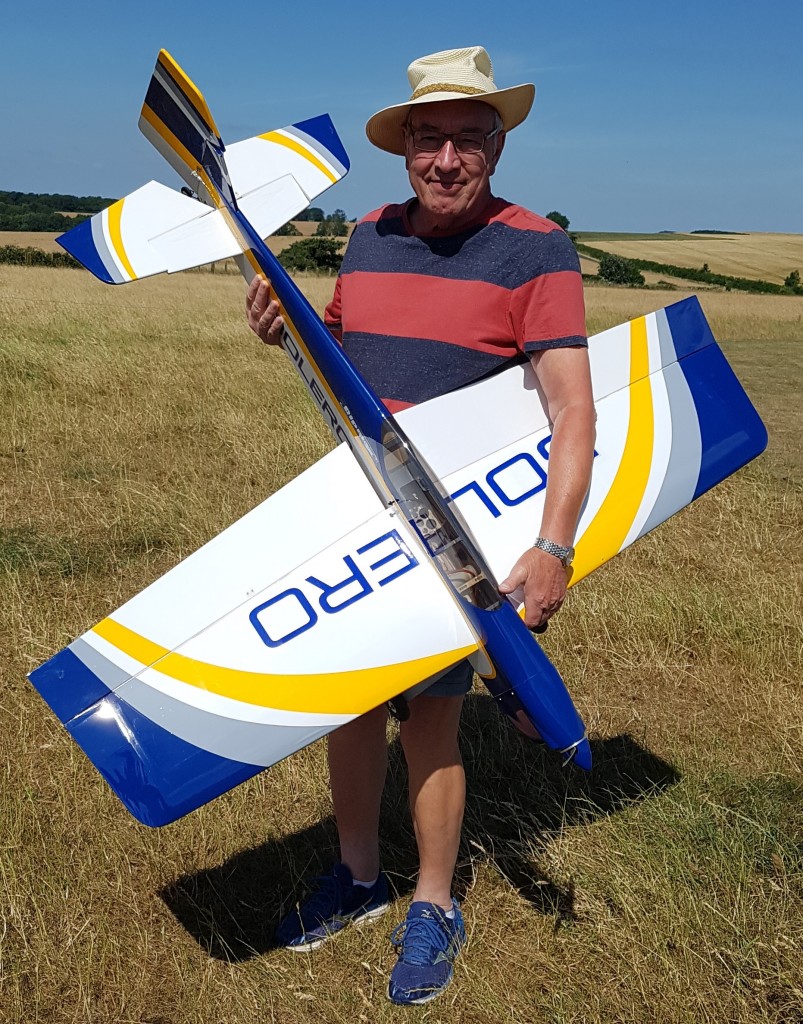
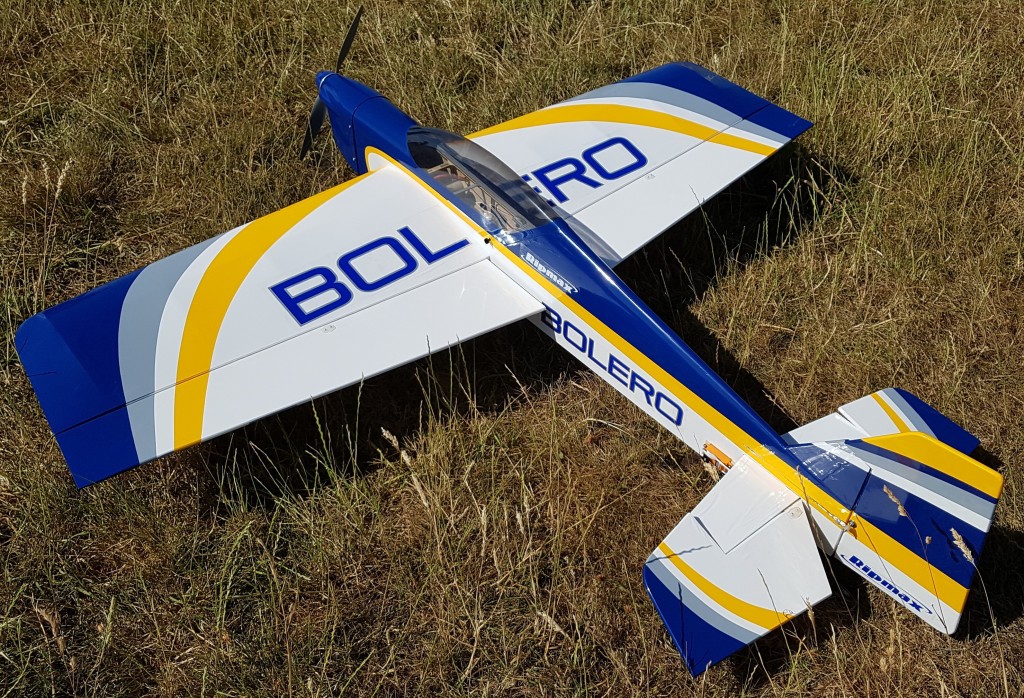 Let’s hope it’s not our very own Woody earning a bit of extra dosh on the side! The model comes as an ARTF so the purchaser has to supply their own powertrain, servos etc. The Bolero is 59” span and the finished weight should be around 3080g (6.8lbs). Chris P has used the same motor etc. that had powered his Wots Wot including the 5 cell lipo. He asked me to do the test flight and the Bolero was good, it flew just as it should although Chris P had sensibly set the control throws towards the low end of the scale so it wasn’t too lively.
Let’s hope it’s not our very own Woody earning a bit of extra dosh on the side! The model comes as an ARTF so the purchaser has to supply their own powertrain, servos etc. The Bolero is 59” span and the finished weight should be around 3080g (6.8lbs). Chris P has used the same motor etc. that had powered his Wots Wot including the 5 cell lipo. He asked me to do the test flight and the Bolero was good, it flew just as it should although Chris P had sensibly set the control throws towards the low end of the scale so it wasn’t too lively.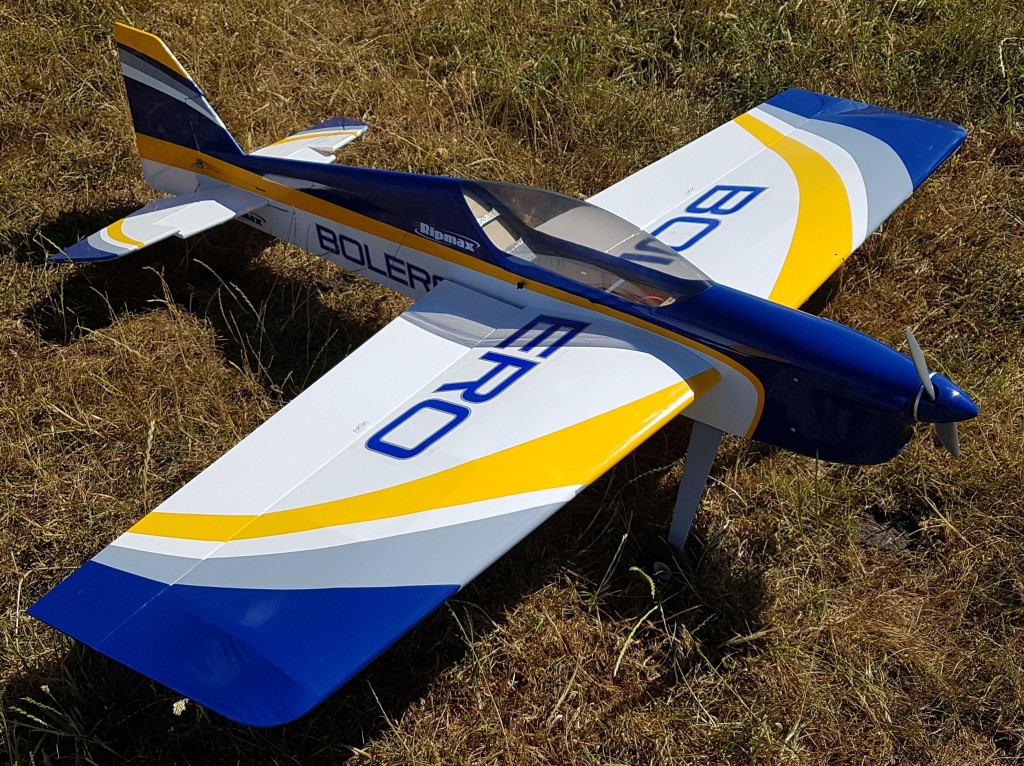
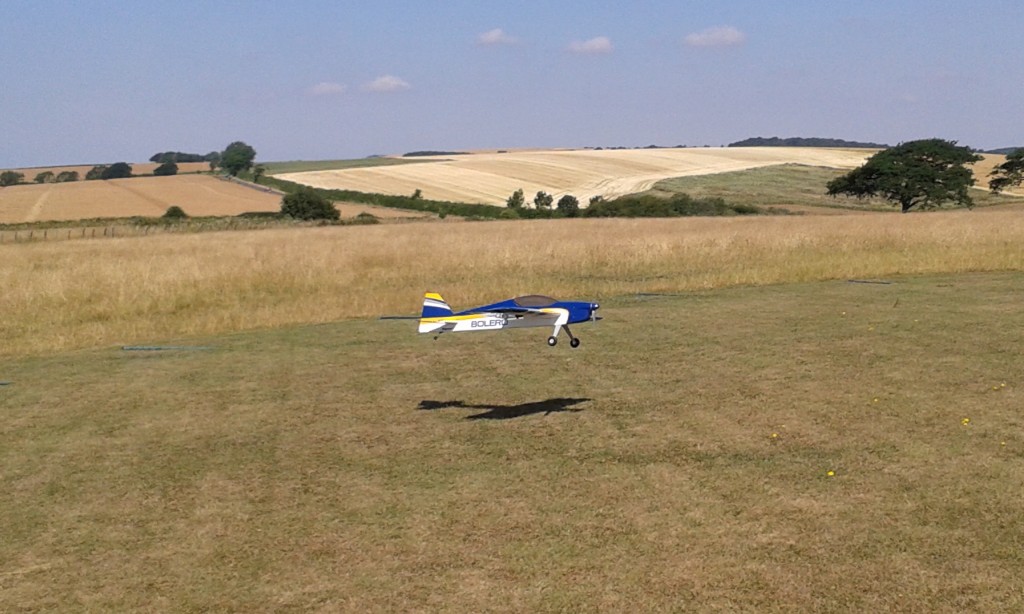 After some minor trimming I passed the transmitter to Chris P but he very quickly passed it back to me and he’s now practising more with his Cougar 2000 before trying the Bolero again!
After some minor trimming I passed the transmitter to Chris P but he very quickly passed it back to me and he’s now practising more with his Cougar 2000 before trying the Bolero again!
The last new model I spotted in July was an EDF Hawk belonging to Norwegian Nick. I thought it was the same as the one that Dougal flies but looking at the HobbyKing website I think they are different models.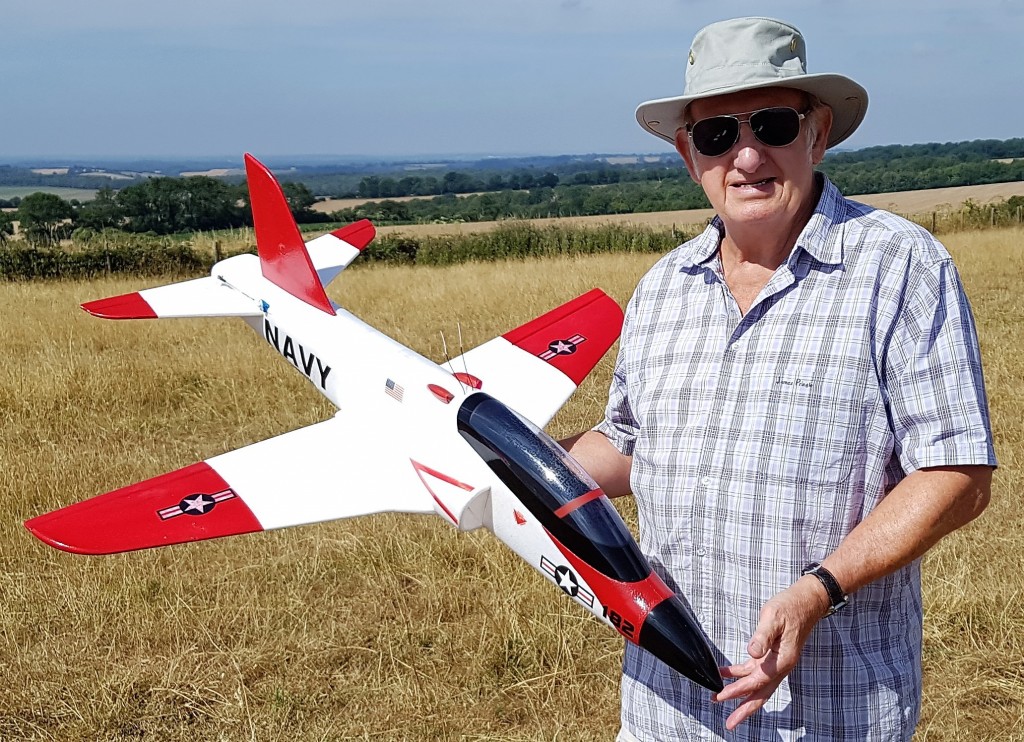
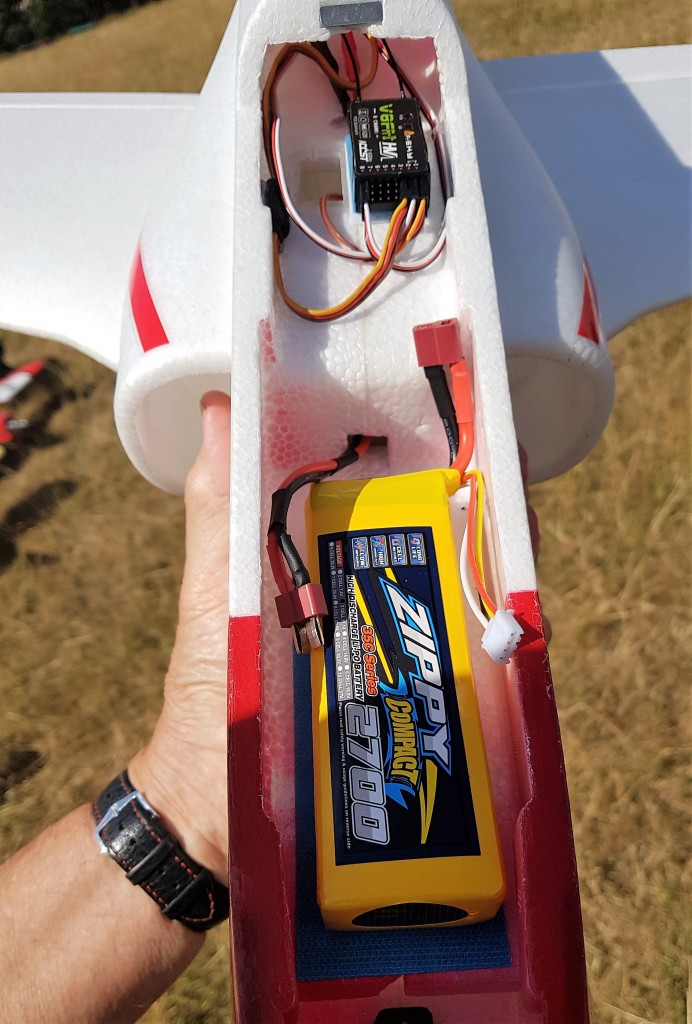 Dougal’s is a 950mm span T-45 Goshawk with a 64mm dia fan but Nick’s is a 990mm span BAE Hawk with a 70mm dia fan. Oddly the BAE Hawk is described as Red Arrows but it comes with a US Navy colour scheme! The other major difference is that Dougal’s flies extremely well and Nick’s doesn’t…well not yet anyway.
Dougal’s is a 950mm span T-45 Goshawk with a 64mm dia fan but Nick’s is a 990mm span BAE Hawk with a 70mm dia fan. Oddly the BAE Hawk is described as Red Arrows but it comes with a US Navy colour scheme! The other major difference is that Dougal’s flies extremely well and Nick’s doesn’t…well not yet anyway.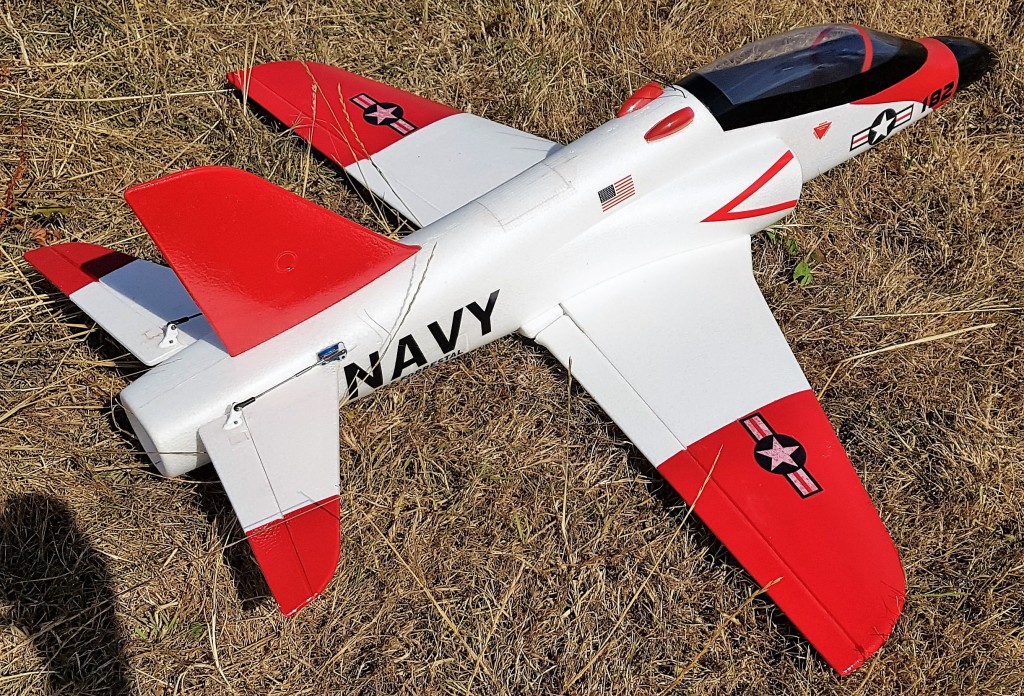 Dougal’s Goshawk comes as a Plug ‘n’ Fly so the motor and fan are already installed. Nick’s model came with a fan supplied but he has fitted a ChangeSun 10 bladed fan, not sure if he has the recommended motor or not. Both models are designed for 3 cell batteries but Nick’s just doesn’t seem to have enough power to fly and is going to need 4 cells. I think the high blade count of the fan means it needs more power to spin at an efficient speed. But the aborted attempt at flight did virtually no damage so hopefully it will fly properly very soon.
Dougal’s Goshawk comes as a Plug ‘n’ Fly so the motor and fan are already installed. Nick’s model came with a fan supplied but he has fitted a ChangeSun 10 bladed fan, not sure if he has the recommended motor or not. Both models are designed for 3 cell batteries but Nick’s just doesn’t seem to have enough power to fly and is going to need 4 cells. I think the high blade count of the fan means it needs more power to spin at an efficient speed. But the aborted attempt at flight did virtually no damage so hopefully it will fly properly very soon.
On Thursday 12th July we held the annual chuck glider competition at Buriton before the usual club meeting. 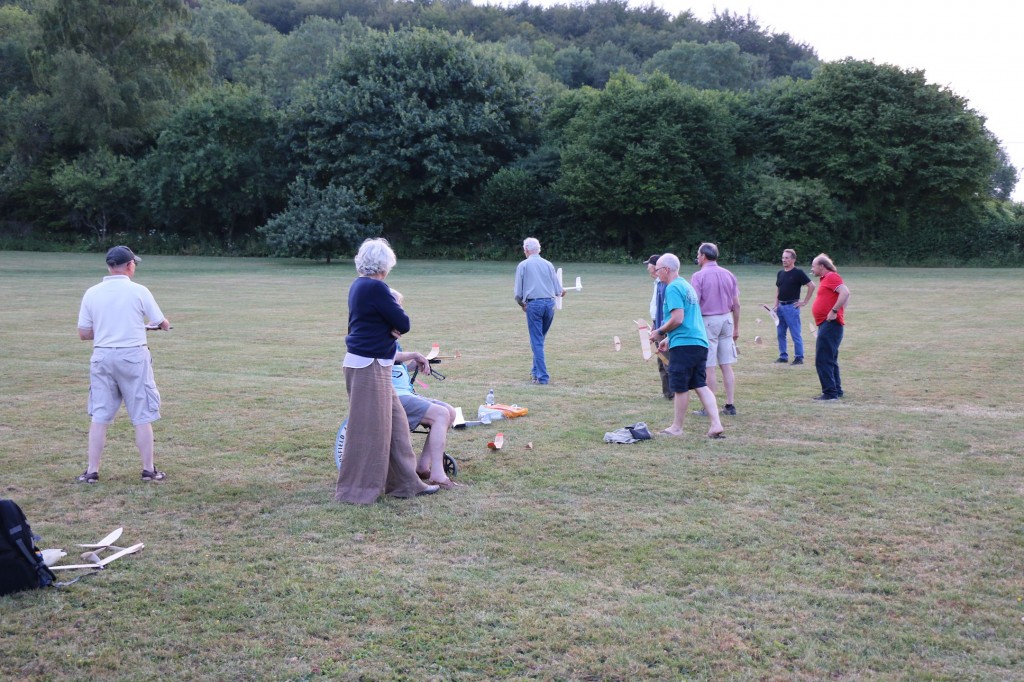 It’s always a popular event and there were 11 entries this year. One entrant was a PAM member from around 35 years ago, Peter Mason. I remember Peter but I doubt any other club members knew him other than Don of course. Peter was an art teacher and he designed and painted the club logo featuring a Marsh Harrier. He brought the original along with him and presented it to Dougal for the club, a nice thing to do I thought.
It’s always a popular event and there were 11 entries this year. One entrant was a PAM member from around 35 years ago, Peter Mason. I remember Peter but I doubt any other club members knew him other than Don of course. Peter was an art teacher and he designed and painted the club logo featuring a Marsh Harrier. He brought the original along with him and presented it to Dougal for the club, a nice thing to do I thought.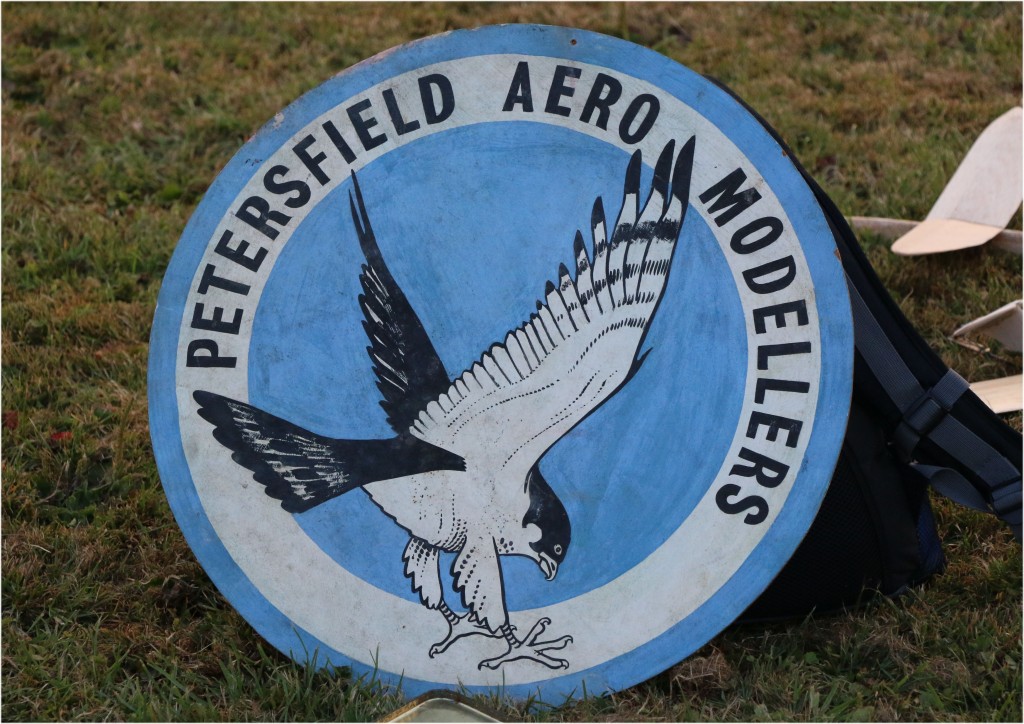 It was great to see Peter again although sadly he is struggling with Parkinson’s Disease and is far from well. But he had a valiant attempt at the comp with a couple of chuck gliders that presumably were getting on for 40 years old. Peter is coming to the club meeting on 9th August when he will run a quiz on general aviation for us all, please try and make the meeting. Back to the chuck glider comp now, the first three places were taken by Colin Cowplain, Percy Vears, and Tony Neil. Thanks to Dwayne Pipe for running the comp and recording all the times. Kryten was on hand to take photos, here’s a selection:
It was great to see Peter again although sadly he is struggling with Parkinson’s Disease and is far from well. But he had a valiant attempt at the comp with a couple of chuck gliders that presumably were getting on for 40 years old. Peter is coming to the club meeting on 9th August when he will run a quiz on general aviation for us all, please try and make the meeting. Back to the chuck glider comp now, the first three places were taken by Colin Cowplain, Percy Vears, and Tony Neil. Thanks to Dwayne Pipe for running the comp and recording all the times. Kryten was on hand to take photos, here’s a selection:
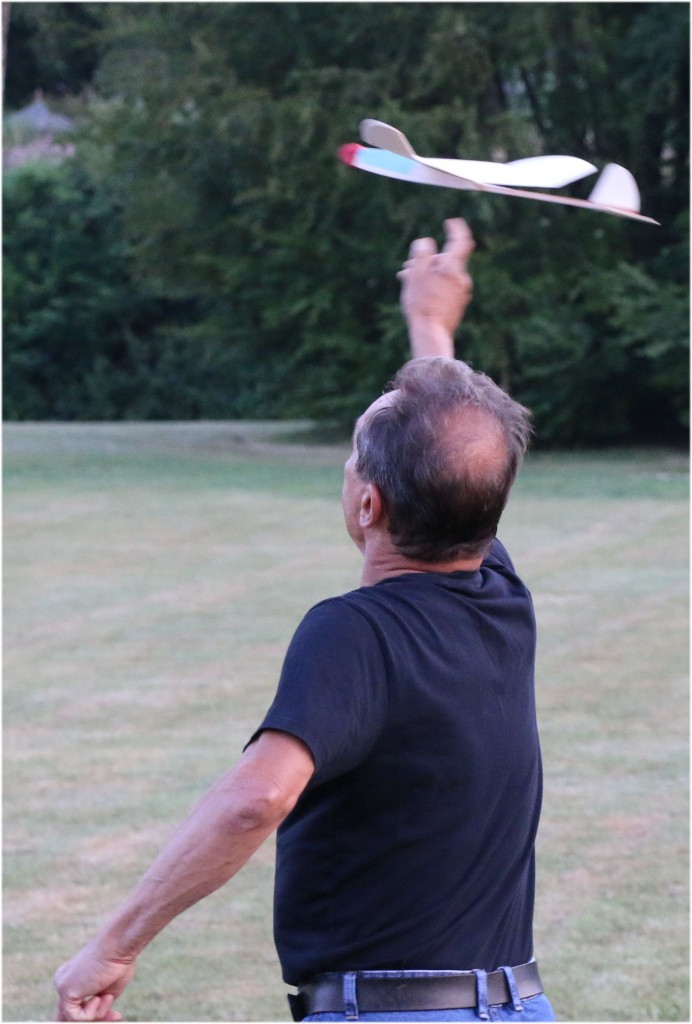
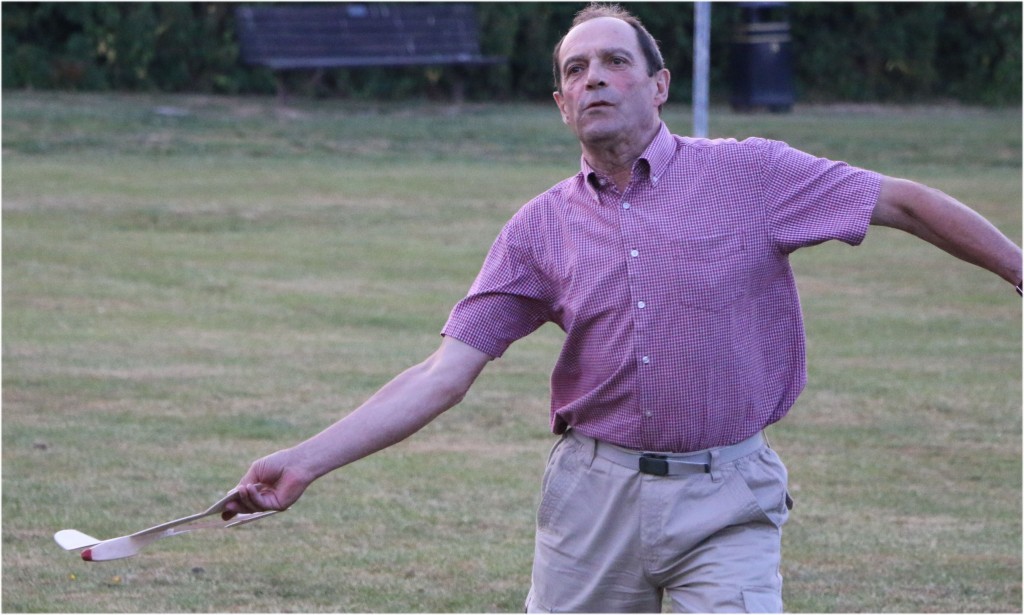
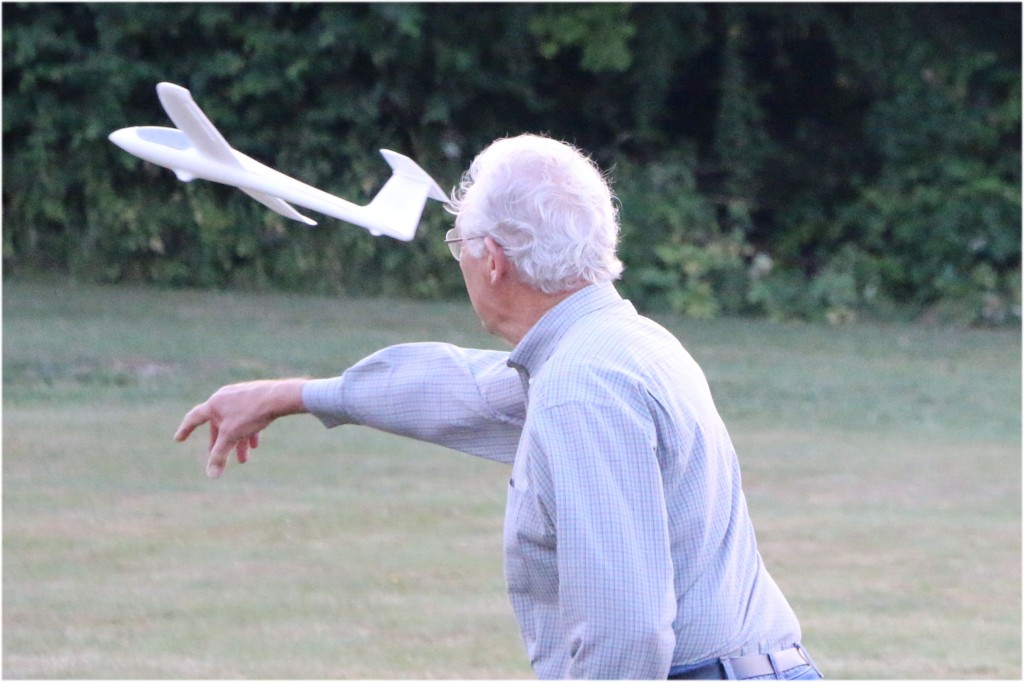
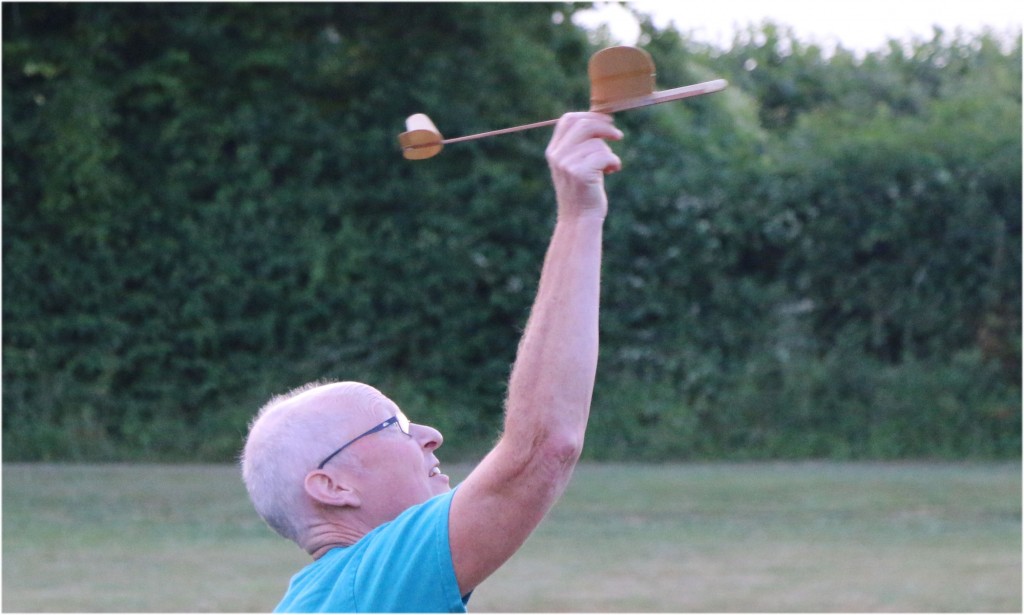
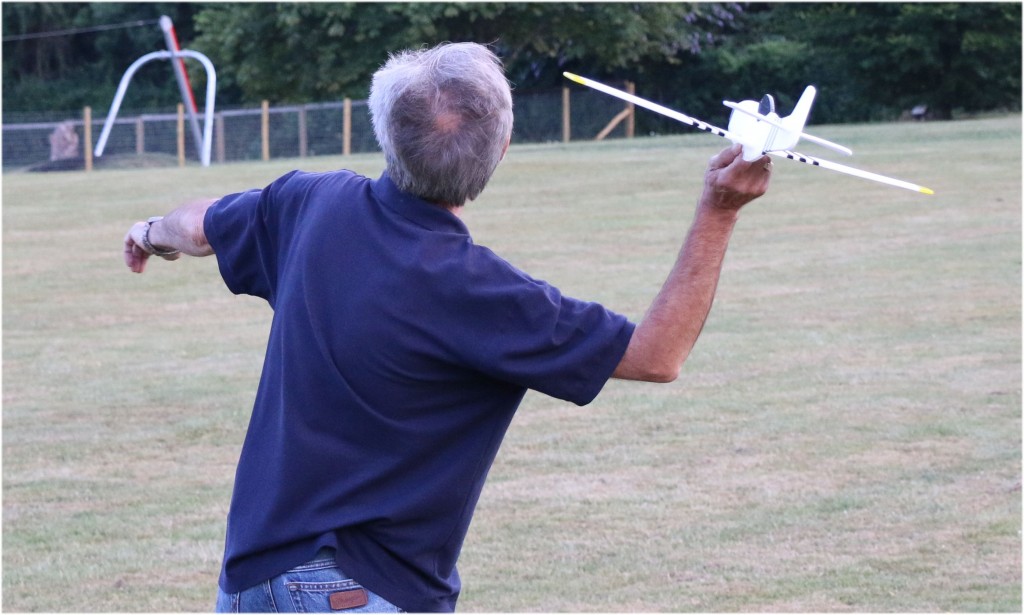
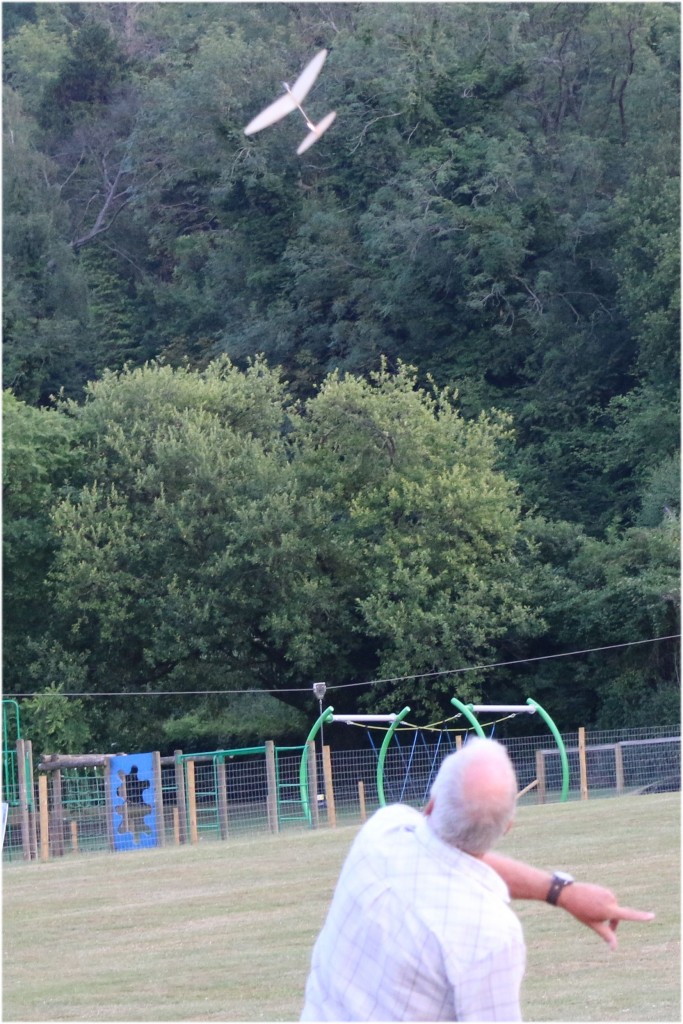
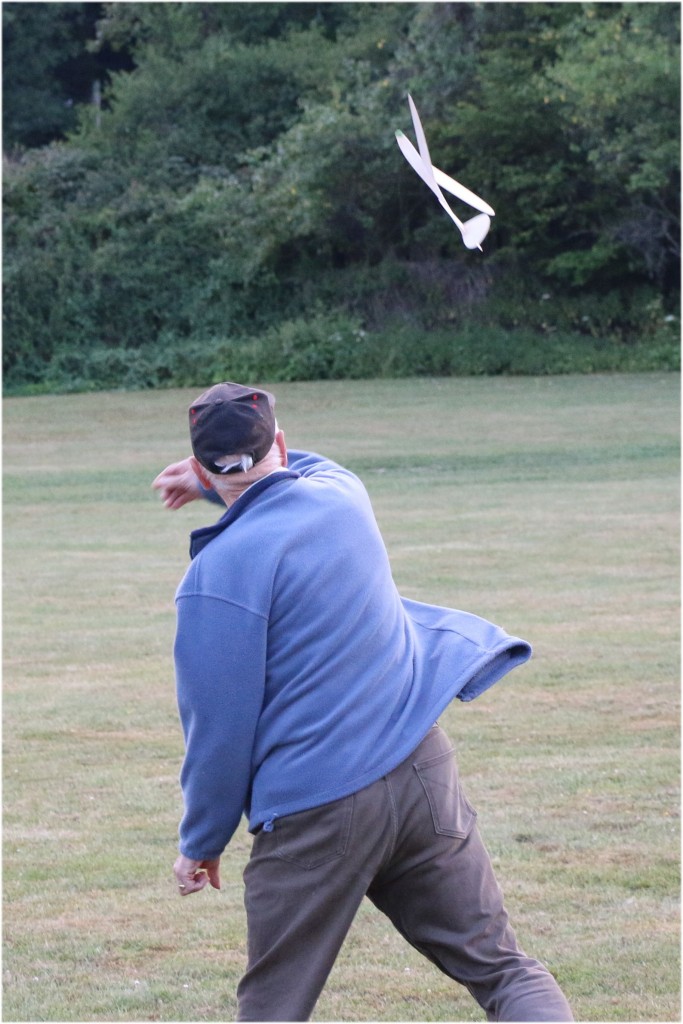
 Catapult King is named because of his model launching prowess but it didn’t seem to go quite right with his chuck gliders. I think it was down to lack of trimming rather than poor throwing but he was unimpressed with their performance and decided to stamp on them! Perhaps we need to rename him Wrecker Richard…
Catapult King is named because of his model launching prowess but it didn’t seem to go quite right with his chuck gliders. I think it was down to lack of trimming rather than poor throwing but he was unimpressed with their performance and decided to stamp on them! Perhaps we need to rename him Wrecker Richard…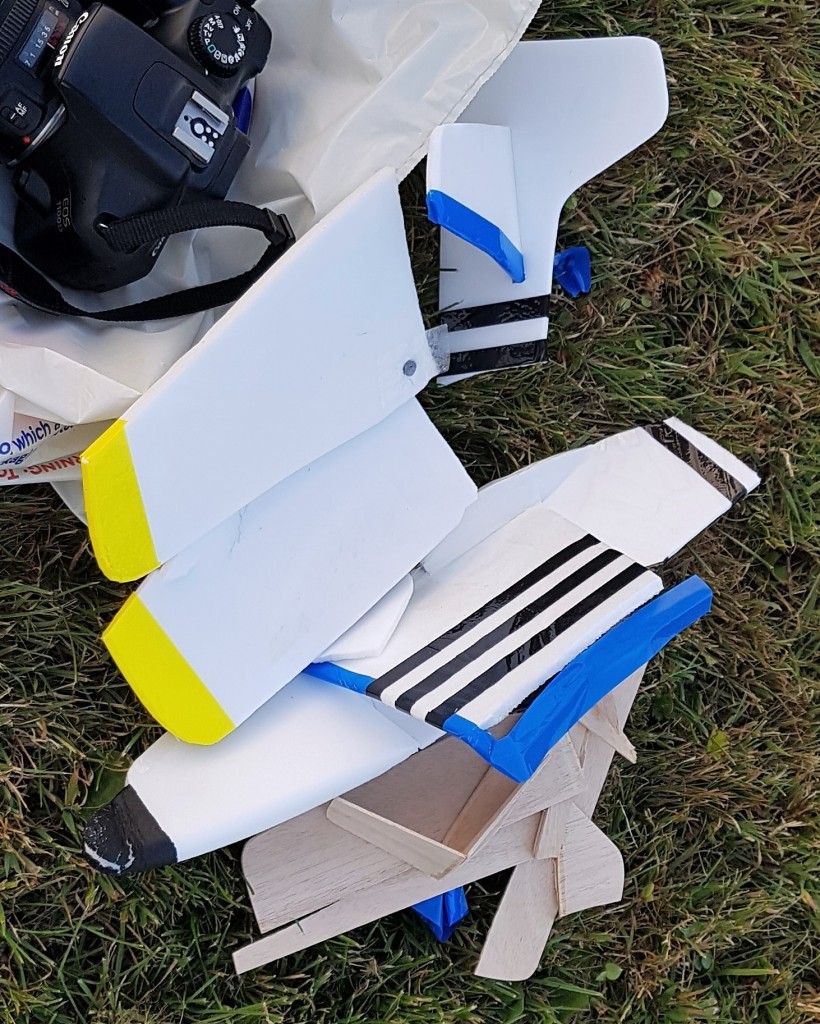 Speaking of comps, don’t forget to have a go at the ongoing fun-fly comps that run all year. There are various tasks to try and there are classes for A cert and B cert holders to give everyone a chance. Full details of the tasks and the latest scores can be found on the Competition page of the website. I can’t help noticing that at the moment in the Max Glide event the top 3 scores for the A cert holders all beat my B cert time. Hmmm…must try harder!
Speaking of comps, don’t forget to have a go at the ongoing fun-fly comps that run all year. There are various tasks to try and there are classes for A cert and B cert holders to give everyone a chance. Full details of the tasks and the latest scores can be found on the Competition page of the website. I can’t help noticing that at the moment in the Max Glide event the top 3 scores for the A cert holders all beat my B cert time. Hmmm…must try harder!
Video time now:
Please watch the video full screen, it’s so much better with small models flying around. If the video won’t play for you CLICK HERE
This month’s ‘joke’ is actually a true tale, a conversation between Dougal and myself. Whilst flying alongside each other one day Dougal’s transmitter suddenly started making intermittent beeping noises:
“Why’s your transmitter beeping, is it the low transmitter battery warning?”
“Dunno, I’d better land and check it out.”
A few minutes later he returned and took off again.
“So what was the beeping?”
“Well there’s this knob on the transmitter…”
“I know that…!” End of conversation.
Colin Cowplain
Patch News – June 2018
I must start by apologising for the lateness of this Patch News. I seem to have been away for most of June and only arrived home on 2nd July after being away for the last two weeks of June. Of course this means I haven’t been flying much so I’m relying on information, photos, and video that others have been kind enough to provide, and this edition will undoubtedly be rather shorter than usual. Many thanks to Dougal, Kryten, Dwayne Pipe and all others.
Some of you may remember that last year the mower packed up and it was decided to buy a new one and to keep the original one as a back-up once it had been repaired. Percy Vears has now repaired it and brought it along to check it was working properly. All was good and Bob the Builder & 1066 did a bit of gang mowing.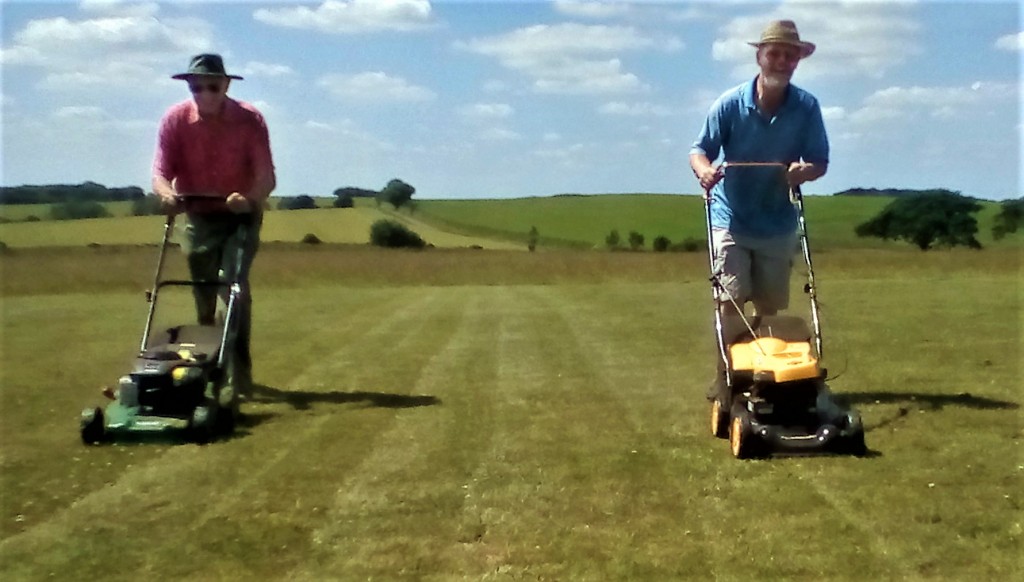 So now we have a back-up mower should one fail. With the new fence in action the condition of the patch has improved dramatically and that has the added bonus that the mower has an easier job to do, less bullock ‘deposits’ and hoof marks to mow over! The patch is looking great at the moment.
So now we have a back-up mower should one fail. With the new fence in action the condition of the patch has improved dramatically and that has the added bonus that the mower has an easier job to do, less bullock ‘deposits’ and hoof marks to mow over! The patch is looking great at the moment.
The first new model to feature this month is a glider from 1066. It’s a 2.4 metre span ASW-28 that he bought from HobbyKing but he’s chucked the box and instructions with all the info!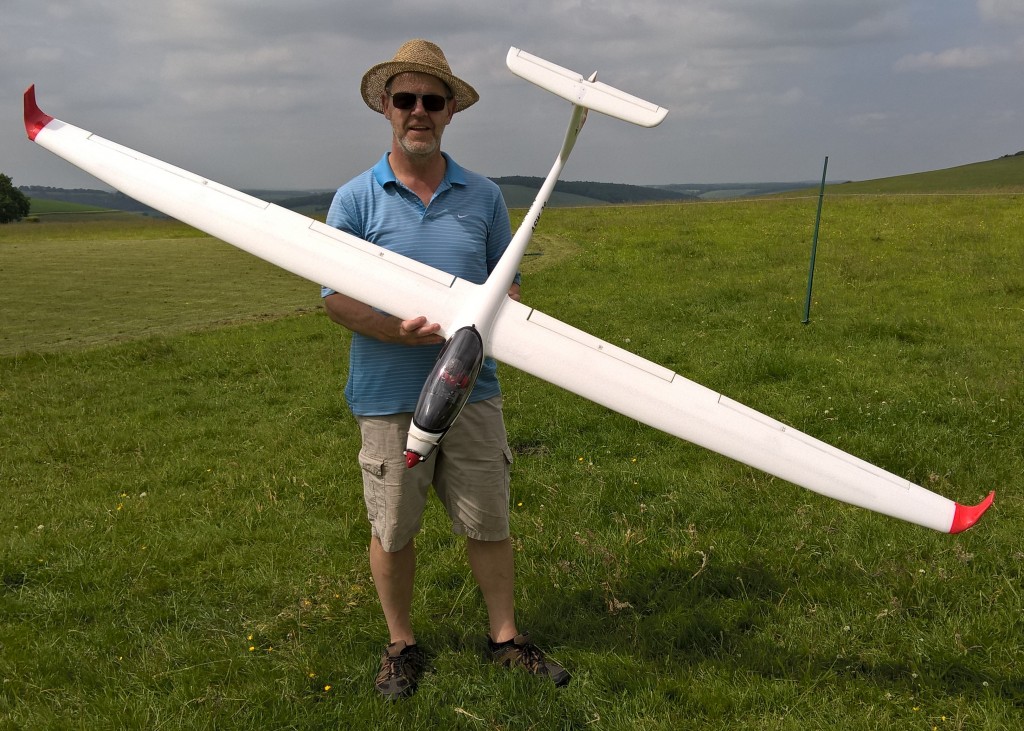 Apparently the original manufacturer is Volantex and this is from their website: The full-scale ASW 28 is a Standard Class glider with a fifteen metre span built of modern fibre reinforced composites. The manufacturer of the ASW-28 is Alexander Schleicher GmbH & Co. The ‘W’ indicates this is a design of the influential and prolific German designer Gerhard Waibel. Serial production started in 2000. As all Standard Class sailplanes, the ASW-28 does not have flaps or other lift-enhancing devices. It has tall winglets, a retractable undercarriage and a water ballast system. The structure is a complex composite of carbon, aramid and polyethylene fibre reinforced plastic. This permits a light structure with the strength to carry large amounts of water ballast, thus permitting the widest possible range of wing loadings for weak and strong soaring weather.
Apparently the original manufacturer is Volantex and this is from their website: The full-scale ASW 28 is a Standard Class glider with a fifteen metre span built of modern fibre reinforced composites. The manufacturer of the ASW-28 is Alexander Schleicher GmbH & Co. The ‘W’ indicates this is a design of the influential and prolific German designer Gerhard Waibel. Serial production started in 2000. As all Standard Class sailplanes, the ASW-28 does not have flaps or other lift-enhancing devices. It has tall winglets, a retractable undercarriage and a water ballast system. The structure is a complex composite of carbon, aramid and polyethylene fibre reinforced plastic. This permits a light structure with the strength to carry large amounts of water ballast, thus permitting the widest possible range of wing loadings for weak and strong soaring weather.
The Volantex ASW 28 is a sport scale model that does incorporate flaps unlike its full scale counterpart. It comes plug and fly so you just need to complete some final assembly, install your battery, receiver and fly. The airframe is a mix of EPO foam for the wings and tail, with a blow moulded plastic fuselage. This gives a slick finish that is also extremely durable. Great for those less than perfect slope sites. A powerful 4018 850kv brushless outrunner motor rockets the ASW 28 to altitude, then when you throttle down, the propeller folds back for extended soaring. Accessing the battery is easy through the canopy with four small snap locks that keeps the canopy secure.
This Version 2 comes with lots of extra features. The wings come with two spars in each wing to give extra strength during those tight turns and power dives. Installing the wings is now easier with a plastic latch for securing the wings. Inside there is now a bigger plywood tray to make it easier to carry FPV cameras, VTx’s or other electronics. Landings are now a lot easier with the inclusion of landing gear. No more scraping the fuselage.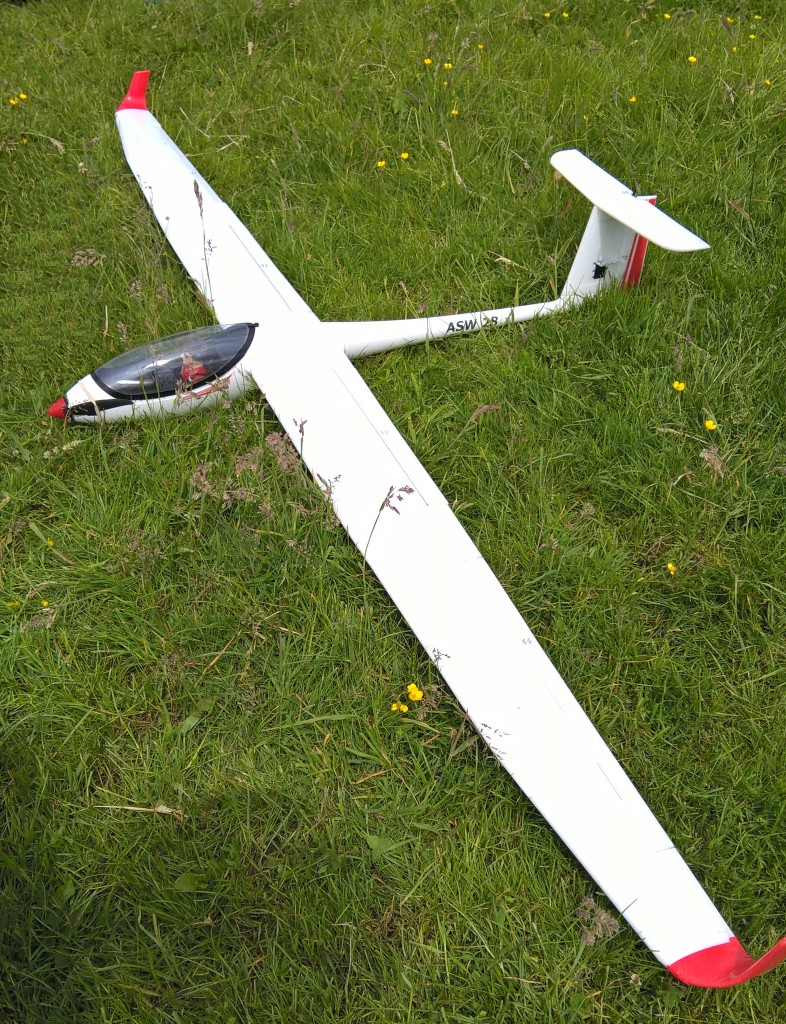 Not sure what VTx’s are, anybody know? Anyway it seems to fly well. 1066 says he’d like a bit more power but then he always does! The wings certainly flex a lot but it looks good in the air and it was definitely a bargain price.
Not sure what VTx’s are, anybody know? Anyway it seems to fly well. 1066 says he’d like a bit more power but then he always does! The wings certainly flex a lot but it looks good in the air and it was definitely a bargain price.
Chris P Bacon had an ‘eventful’ June, he managed to destroy not one but two of his Chris Foss models! The first was his Wot-4, one of the built from wood versions that comes ready for either I/C or electric motors. Chris P’s was electric of course, powered by a Turnigy L5055C 700Kv outrunner and a 4 cell lipo battery. The model took off normally but almost immediately Chris P said he had no control. The model didn’t appear to do much other than continue in the same direction but losing height quickly. The resulting crash was pretty comprehensive and I don’t think it will be repaired. Although the first call was loss of radio it all appeared to be working perfectly after the crash and Chris P is now wondering if it was actually a lipo failure and all he had really lost was motor power. The pack had previously swollen but the cell voltages appeared to be fine and when we checked them again after the crash the voltages still looked normal. But later he wondered if the meter just showed 3 cells at normal voltage and nothing at all on the fourth cell. I’m not sure a duff cell would actually not register at all and anyway I think the model would still have flown on 3 cells although obviously with a quarter less power. Chris P has ditched the pack after the crash so now there’s no way of knowing for sure.
The model took off normally but almost immediately Chris P said he had no control. The model didn’t appear to do much other than continue in the same direction but losing height quickly. The resulting crash was pretty comprehensive and I don’t think it will be repaired. Although the first call was loss of radio it all appeared to be working perfectly after the crash and Chris P is now wondering if it was actually a lipo failure and all he had really lost was motor power. The pack had previously swollen but the cell voltages appeared to be fine and when we checked them again after the crash the voltages still looked normal. But later he wondered if the meter just showed 3 cells at normal voltage and nothing at all on the fourth cell. I’m not sure a duff cell would actually not register at all and anyway I think the model would still have flown on 3 cells although obviously with a quarter less power. Chris P has ditched the pack after the crash so now there’s no way of knowing for sure.
Chris P’s second Fossie failure was with his Wots Wot, that’s the biplane one. The Wots Wot is quite large for a bipe at 50” span and it weighs around 7lbs. It’s all built up construction from balsa and ply, and is designed for a .70-.81 4 stroke glow engine or a 5 cell electric set up with a 5055 700Kv motor. That’s the same motor as Chris P had fitted to his Wot-4 but that used 4 cells. This time the crash had a much simpler explanation, loss of orientation.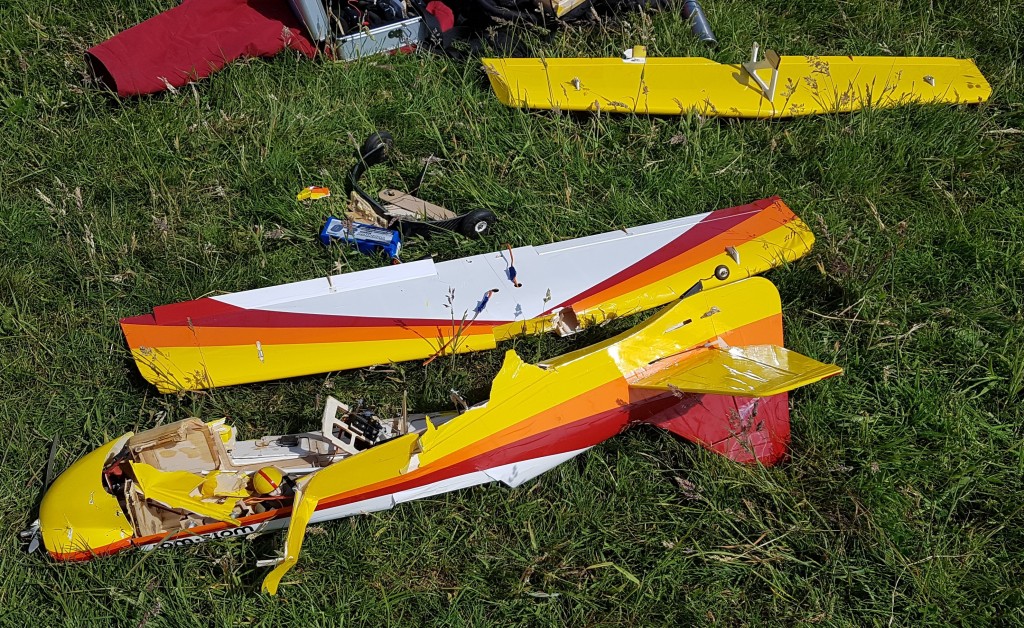
 The model was flying fine but, at a reasonable distance from the patch, Chris P simply lost orientation and the Wots Wot crashed heavily. It’s a shame to lose a model like that but I think it’s fair to say that Chip P never quite mastered it and although I flew it several times I must say that I never felt quite at home with it somehow.
The model was flying fine but, at a reasonable distance from the patch, Chris P simply lost orientation and the Wots Wot crashed heavily. It’s a shame to lose a model like that but I think it’s fair to say that Chip P never quite mastered it and although I flew it several times I must say that I never felt quite at home with it somehow.
On to more sedate things now, Captain Slow has re-motored his Multiplex Twinstar which was originally built with a pair of 6v Speed 400 brushed motors and flew on an eight cell nimh pack.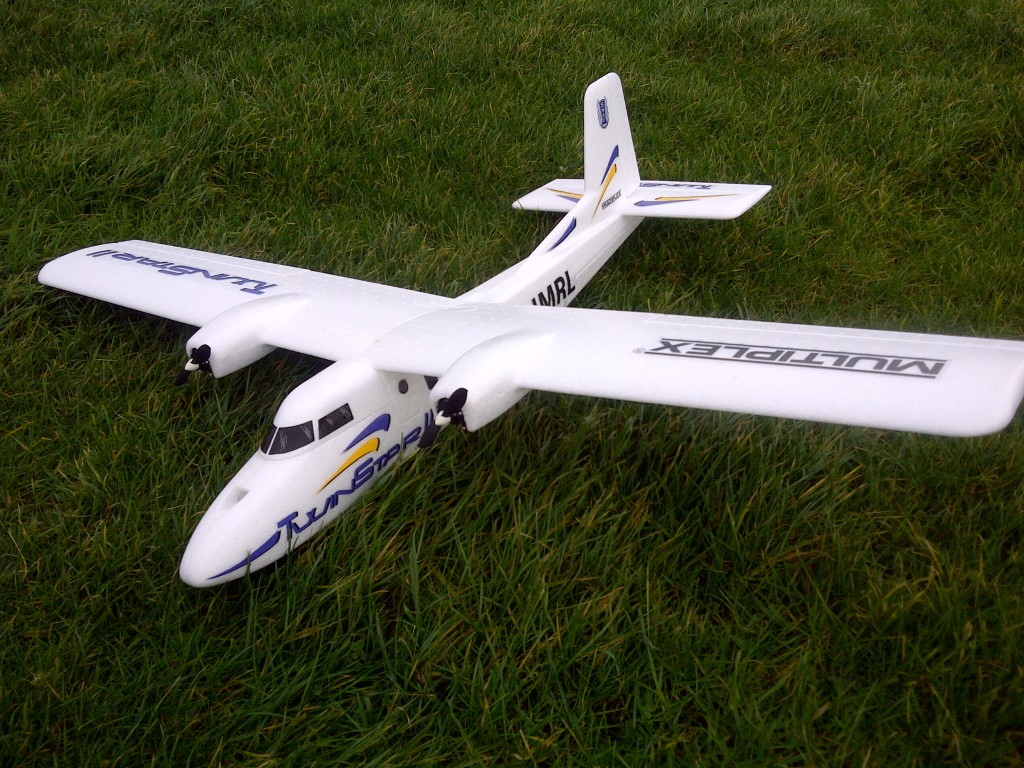 But the always-with-the-latest-tech Captain Slow wanted to ditch the NiMH batteries and use his lipo packs. He wasn’t convinced that the 6v brushed motors would be able to handle the higher voltage of a 3 cell lipo so to keep up with the latest technology he bought a pair of 12v Speed 400 brushed motors!
But the always-with-the-latest-tech Captain Slow wanted to ditch the NiMH batteries and use his lipo packs. He wasn’t convinced that the 6v brushed motors would be able to handle the higher voltage of a 3 cell lipo so to keep up with the latest technology he bought a pair of 12v Speed 400 brushed motors!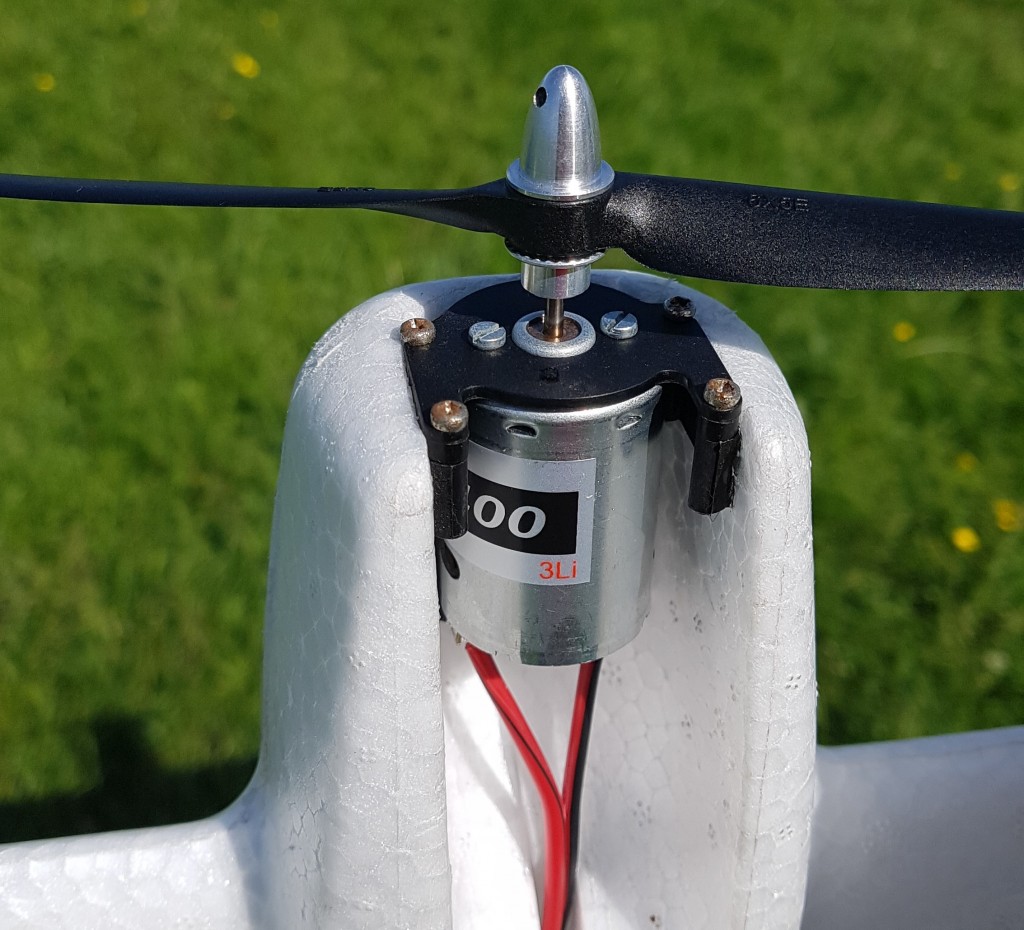
 To be fair (that’s not like me at all) he said that if he had switched to brushless outrunner motors he would have had to change all the wiring within the wings. I’m not sure about that, the latest versions of the Twinstar come with outrunner motors and the speed controllers fit in the nacelles behind the motors so surely you could use the two wire power leads that are already in the wings? No doubt Captain Slow will explain…
To be fair (that’s not like me at all) he said that if he had switched to brushless outrunner motors he would have had to change all the wiring within the wings. I’m not sure about that, the latest versions of the Twinstar come with outrunner motors and the speed controllers fit in the nacelles behind the motors so surely you could use the two wire power leads that are already in the wings? No doubt Captain Slow will explain…
Percy Vears took a trip up to Medstead to see Ian at ModellbauUK and bought himself a Max-Thrust Riot.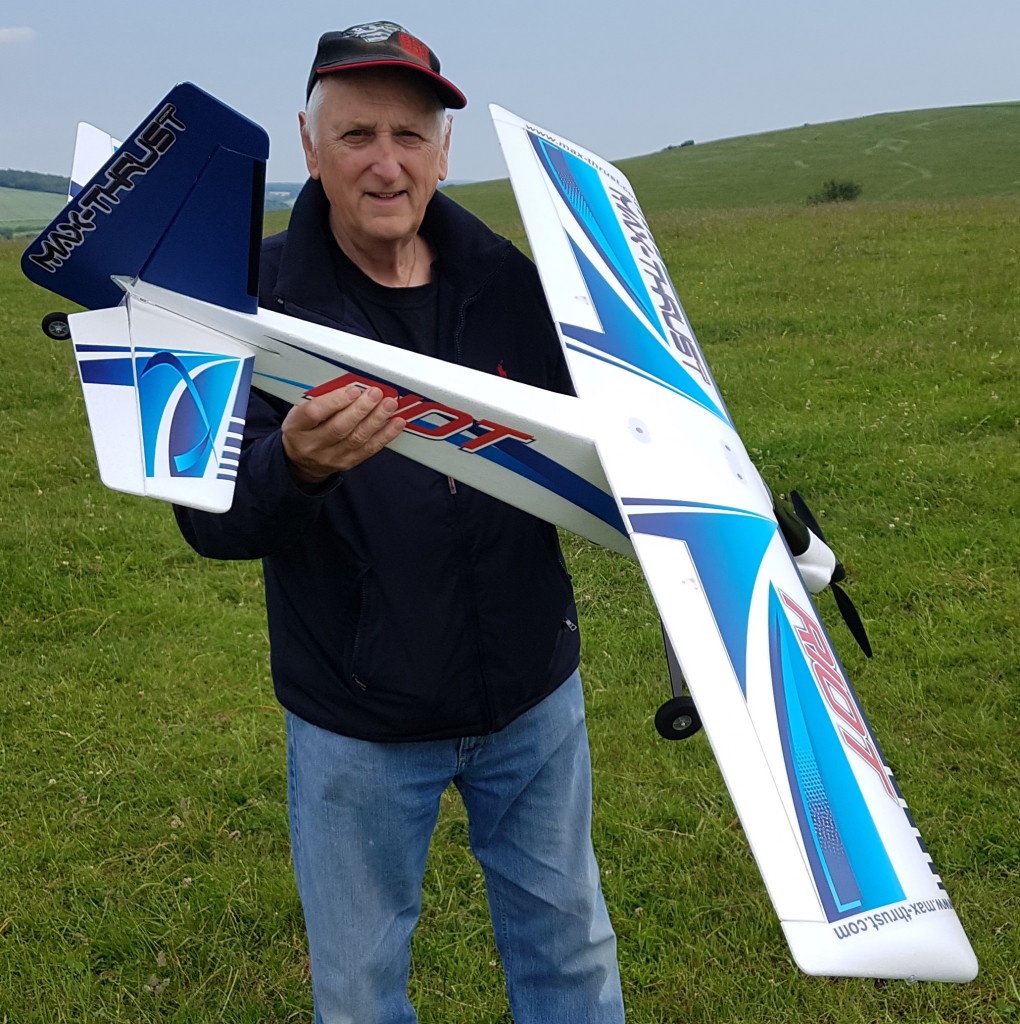
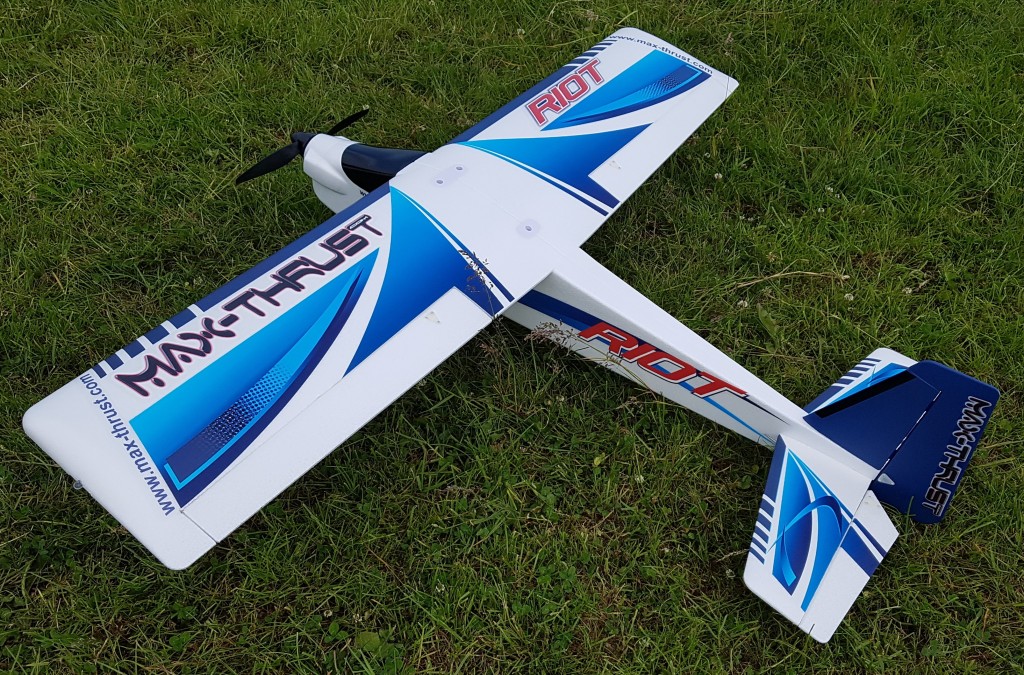 It’s very much a Wot-4 lookalike but is supposed to be better in certain aspects. This is what the website says about it: The Max-Thrust Riot is the perfect all-rounder. With reduced control throws it’s smooth, stable and remarkably easy to fly for the novice or beginner. Increase those throws and the Riot more than lives up to its name thrilling the most ambitious aerobatic pilot. Featuring durable “EPOFLEXY” construction throughout, the superbly moulded airframe is not only very light and stiff, it’s extremely tough too. It’s ideal for operating from “less than perfect” flying strips, resisting hangar rash and those inevitable bumps. And to keep you flying there will be full spares support available.
It’s very much a Wot-4 lookalike but is supposed to be better in certain aspects. This is what the website says about it: The Max-Thrust Riot is the perfect all-rounder. With reduced control throws it’s smooth, stable and remarkably easy to fly for the novice or beginner. Increase those throws and the Riot more than lives up to its name thrilling the most ambitious aerobatic pilot. Featuring durable “EPOFLEXY” construction throughout, the superbly moulded airframe is not only very light and stiff, it’s extremely tough too. It’s ideal for operating from “less than perfect” flying strips, resisting hangar rash and those inevitable bumps. And to keep you flying there will be full spares support available.
The Riot is 1400mm span and comes complete with all you need to get it in the air except a receiver and battery. Everything just screws together, no glue required.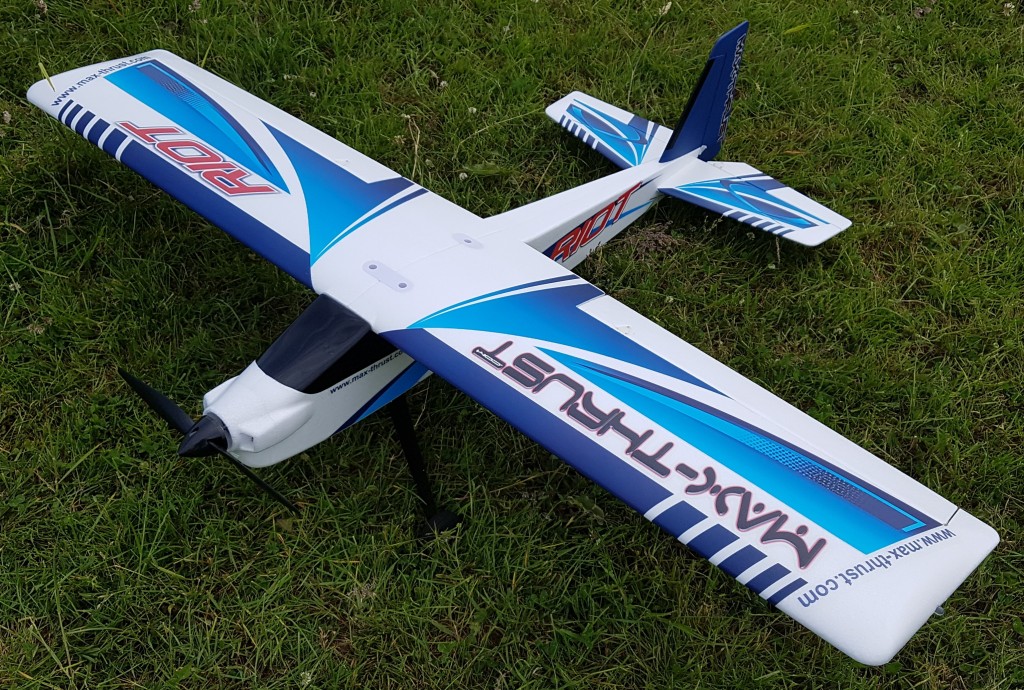
 I haven’t had a go with it yet but I watched Percy flying it and it looks very steady in the air, and it even has lights on the wingtips, Woody must be yearning for one already! 1066 did the first flight and found it to be very aerobatic on full rates but at the moment Percy is flying it on the more sedate low rates.
I haven’t had a go with it yet but I watched Percy flying it and it looks very steady in the air, and it even has lights on the wingtips, Woody must be yearning for one already! 1066 did the first flight and found it to be very aerobatic on full rates but at the moment Percy is flying it on the more sedate low rates.
While I was away Dougal Entendre sent me a couple of reports for Patch News, here’s the first one: Catapult King brought along his F16 (formerly Chris Hard’s). He’d not flown it for a while, and forgot that anything over half throttle is inadvisable, which led to quite a hairy first flight. He kindly let me explore its flight envelope on the second flight – all went well until I tried it inverted, when it went into quite a violent oscillation. I throttled back and pulled out successfully, then tried it again – same result. I flew it around fairly gingerly for the rest of the flight, and landed it without incident. We investigated the all-moving tail and found no problems, but as shown in the photo it transpired that in fact the whole of the rear part of the fuselage (apart from the hatch cover) had almost broken off!
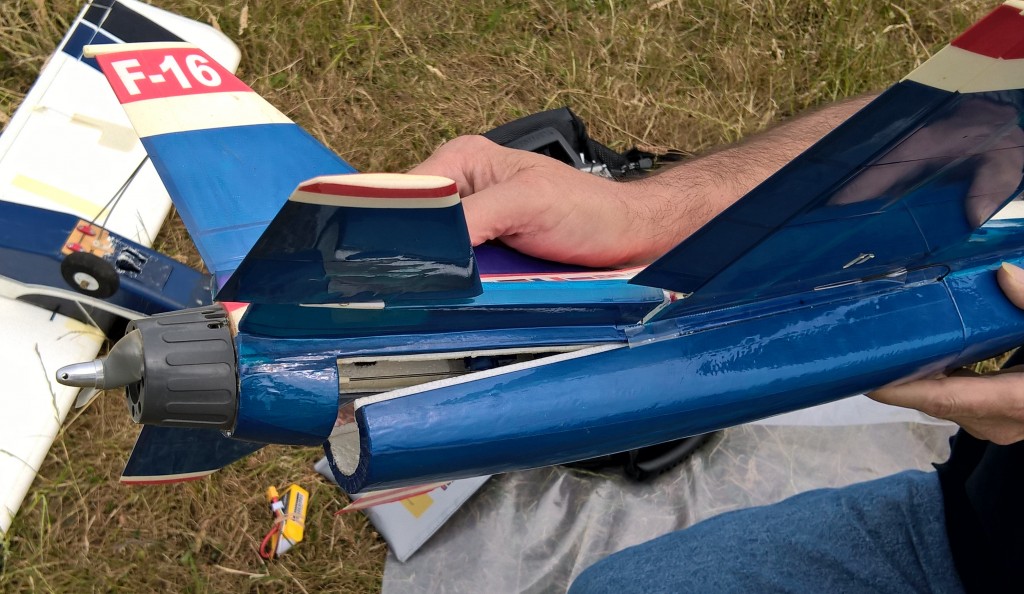 We were lucky to get away without a much worse outcome.
We were lucky to get away without a much worse outcome.
Later on in the pits, someone said “Hey! Look at all those flies!” A huge cloud was coming our way, and we quickly realised it was a swarm of bees. We all kept our heads down, and fortunately they passed without incident.
Towards the end of the morning 1066 was aerobatting his Piper Cub (as he does). He pulled out of a manoeuvre inverted over the south field, then appeared to go in quite hard. He stomped off to get it muttering about how that was the end of that, but remarkably came back with it all in one piece, with no sign of any accident! I think he would have flown it again if we hadn’t put the electric fence back up by then.
Dougal’s second report is about his visit to the Horsham club following the cancellation of the show at Sumners Ponds: I had a brilliant time flying at the Horsham club’s field in just about perfect conditions. We parked along the edge of the field under the treeline, which provided some welcome shade. Although the field was covered in grass about 18 inches high, they had mown a track out to a 60m strip in the middle. I must say the facilities were excellent – they had a large shipping container for all the mowing equipment with an en-suite chemical loo, and a generator for recharging batteries if required. Free tea, coffee and biscuits were supplied throughout the day.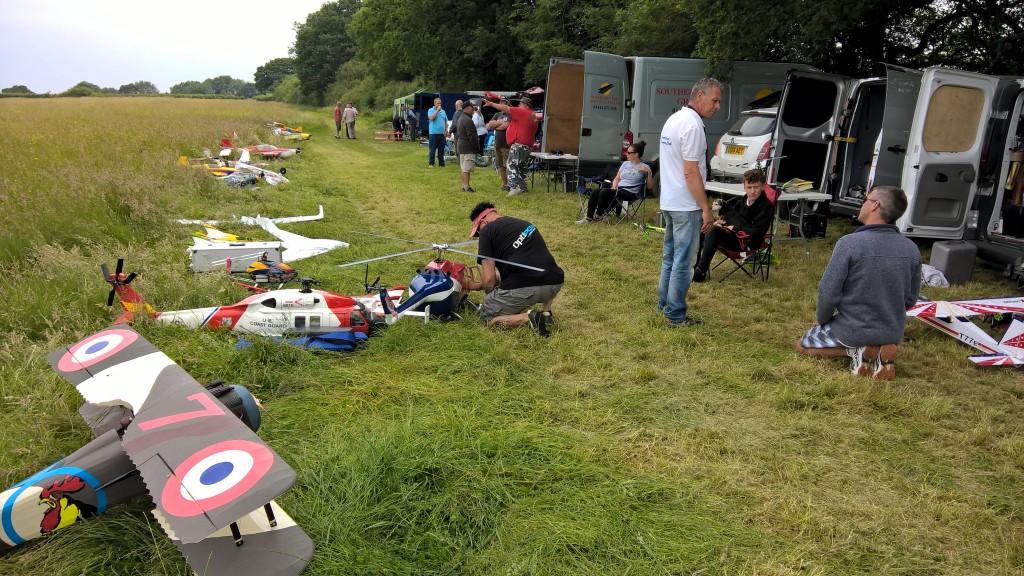 There was a good variety of models, from gliders, large scale and large 3D planes down to club trainers, and a smattering of helicopters. Flying was very relaxed; in fact general flying was suspended at one point while someone took his ‘A’ test!
There was a good variety of models, from gliders, large scale and large 3D planes down to club trainers, and a smattering of helicopters. Flying was very relaxed; in fact general flying was suspended at one point while someone took his ‘A’ test!
I had 5 flights during the day, and my Mini Blitz delta attracted every bit as much attention as the SPAD. In fact, the Horsham club chairman later emailed me to ask for details of the delta, as he thought they might do a club build competition based on it themselves!
 I counted at least 25 cars and vans at the busiest point, so it was quite well attended. All in all one of my best RC days out, and if they do it next year I will certainly try to get along there again.
I counted at least 25 cars and vans at the busiest point, so it was quite well attended. All in all one of my best RC days out, and if they do it next year I will certainly try to get along there again.
Thanks for those reports Dougal.
The last new model I spotted (and was asked to test fly) in June was Bob the Builder’s Durafly SlowPoke.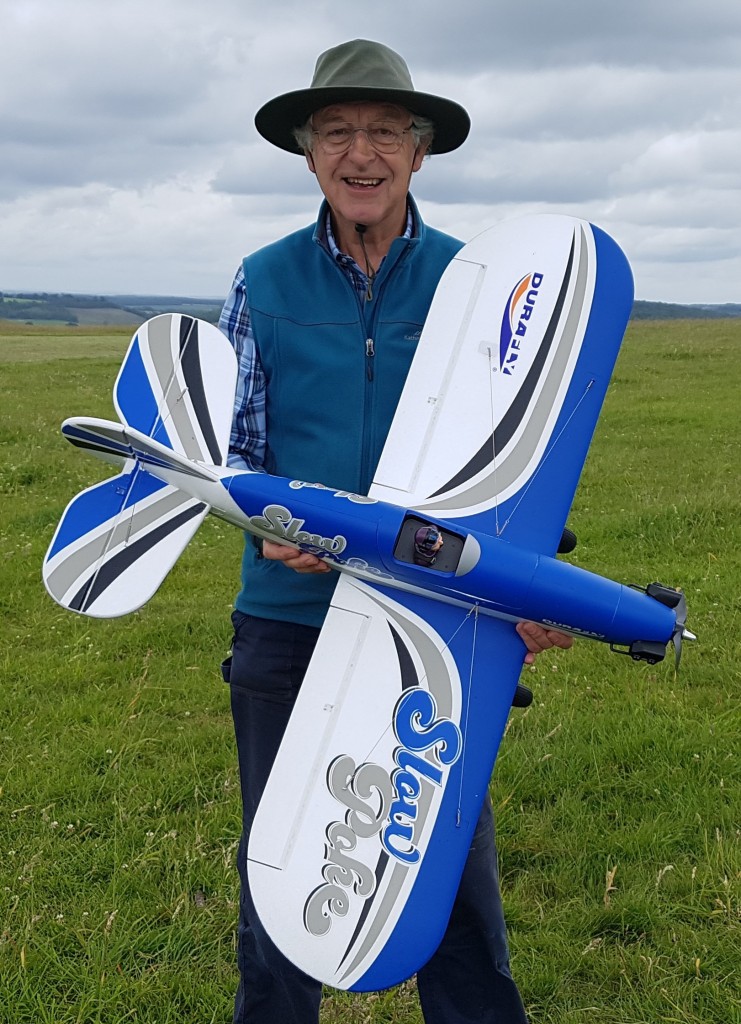 It’s another one from HobbyKing and at 1200mm wingspan is a handy size and uses almost ‘standard’ 2200mAh 3 cell lipo packs. It is a Plug’N’Fly so just needs a receiver and battery. The power is provided by a 3648 700KV motor and 40A ESC and the prop is a 12 x 8. The model comes with large balloon wheels that are perfectly suited to our grass strip. It flies beautifully, handles the wind well, is nicely aerobatic but looks good just stooging around the sky.
It’s another one from HobbyKing and at 1200mm wingspan is a handy size and uses almost ‘standard’ 2200mAh 3 cell lipo packs. It is a Plug’N’Fly so just needs a receiver and battery. The power is provided by a 3648 700KV motor and 40A ESC and the prop is a 12 x 8. The model comes with large balloon wheels that are perfectly suited to our grass strip. It flies beautifully, handles the wind well, is nicely aerobatic but looks good just stooging around the sky.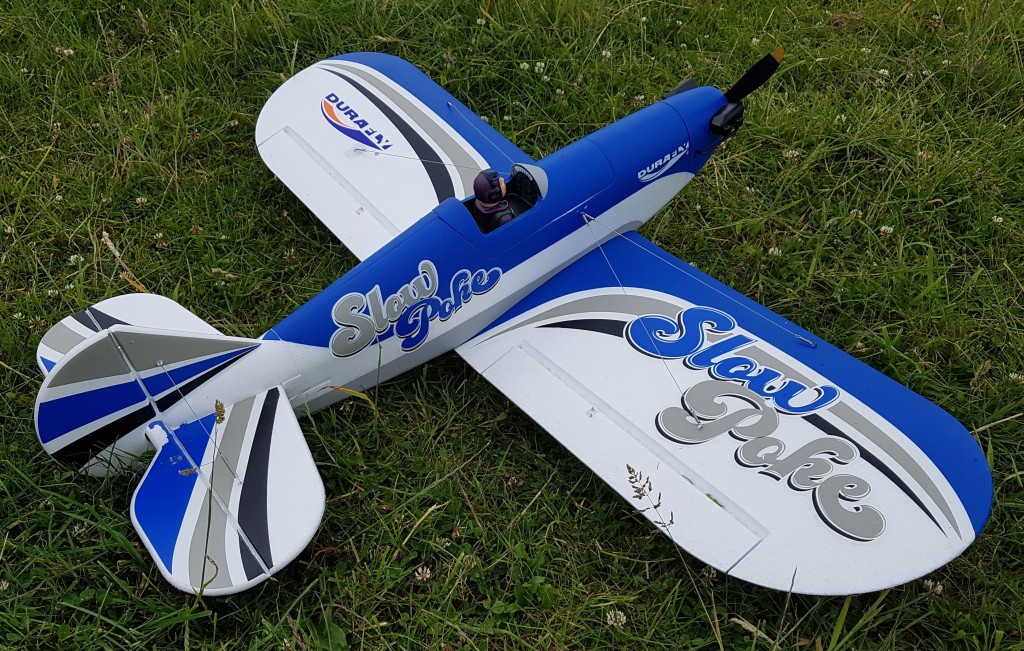
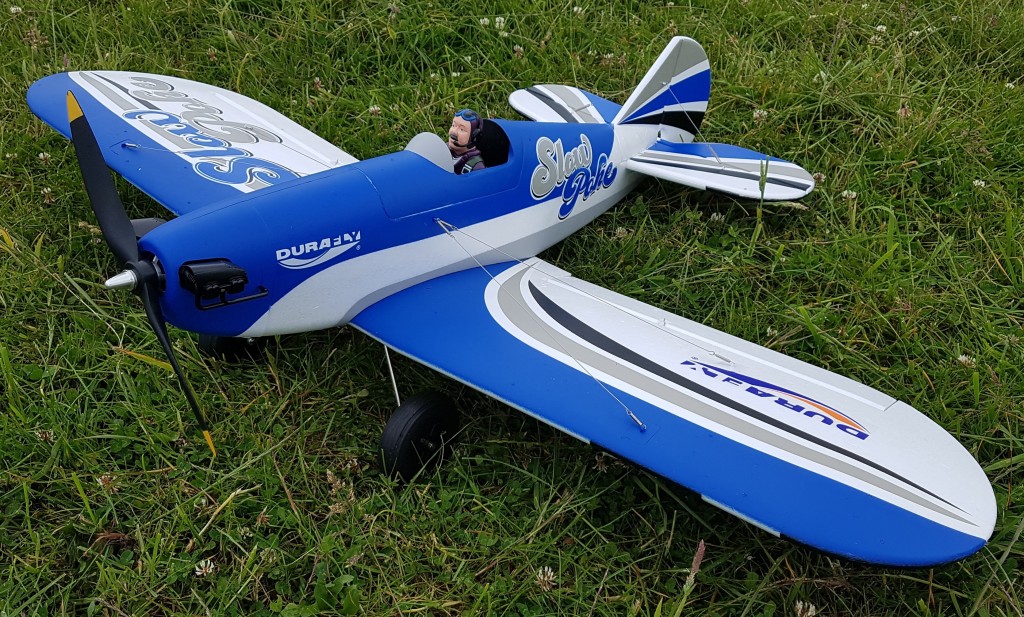 When I did the first landing I remarked ‘If you can’t land that you can’t land anything’. Bob has tried to prove me wrong a couple of times, it seems to be magnetically attracted to the only fence post we leave in place when we fly! All in all a lovely little model and you can see it in action in this month’s video.
When I did the first landing I remarked ‘If you can’t land that you can’t land anything’. Bob has tried to prove me wrong a couple of times, it seems to be magnetically attracted to the only fence post we leave in place when we fly! All in all a lovely little model and you can see it in action in this month’s video.
Inspired by the success of Bob the Builder’s Blitz Fu Dougal decided to try this, a Kung-Fun-3: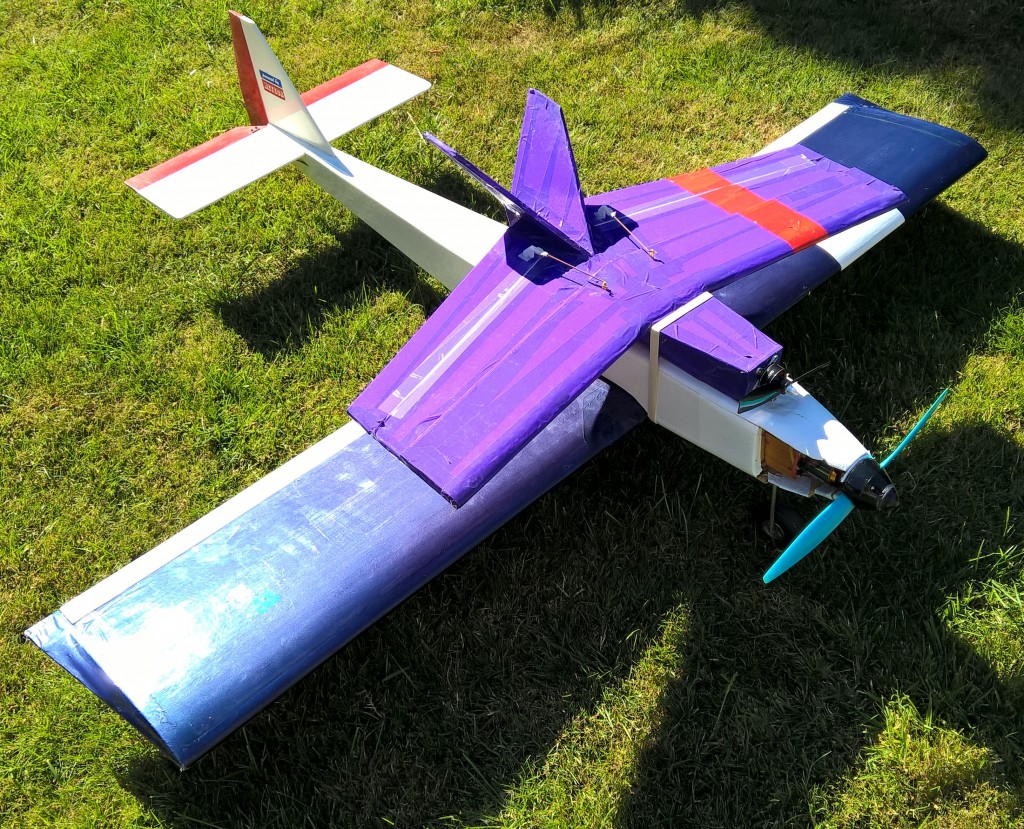 He says it’s just a concept at the moment as he hasn’t finalised the attachment method. I’d be a little concerned about the prop clearance on the Kung Fu myself!
He says it’s just a concept at the moment as he hasn’t finalised the attachment method. I’d be a little concerned about the prop clearance on the Kung Fu myself!
I have a few photos from last month’s club model flying day for you: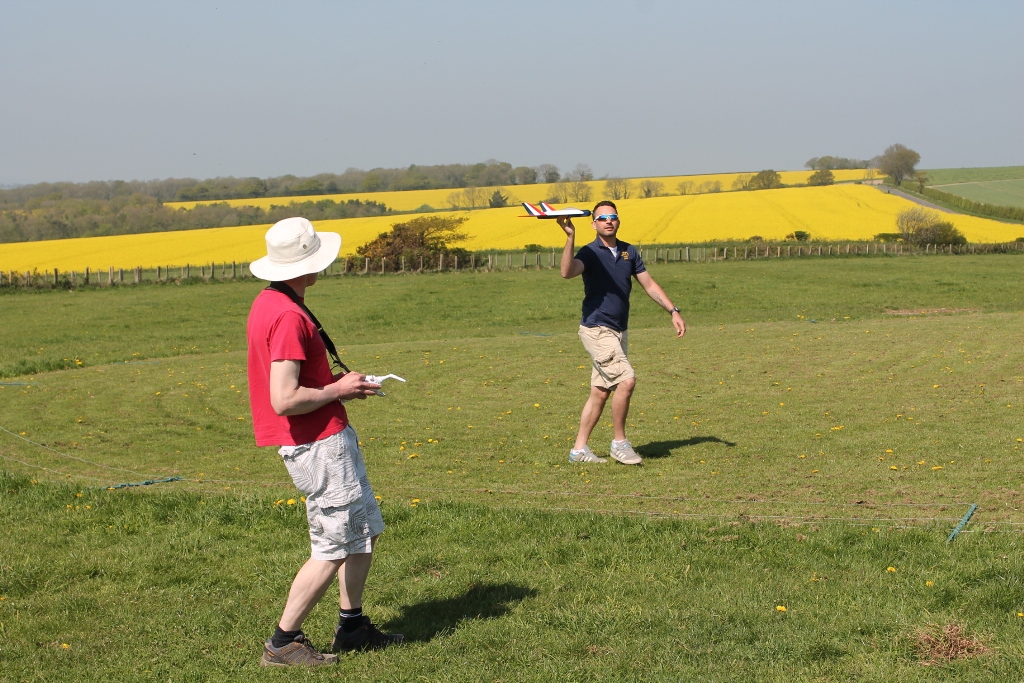
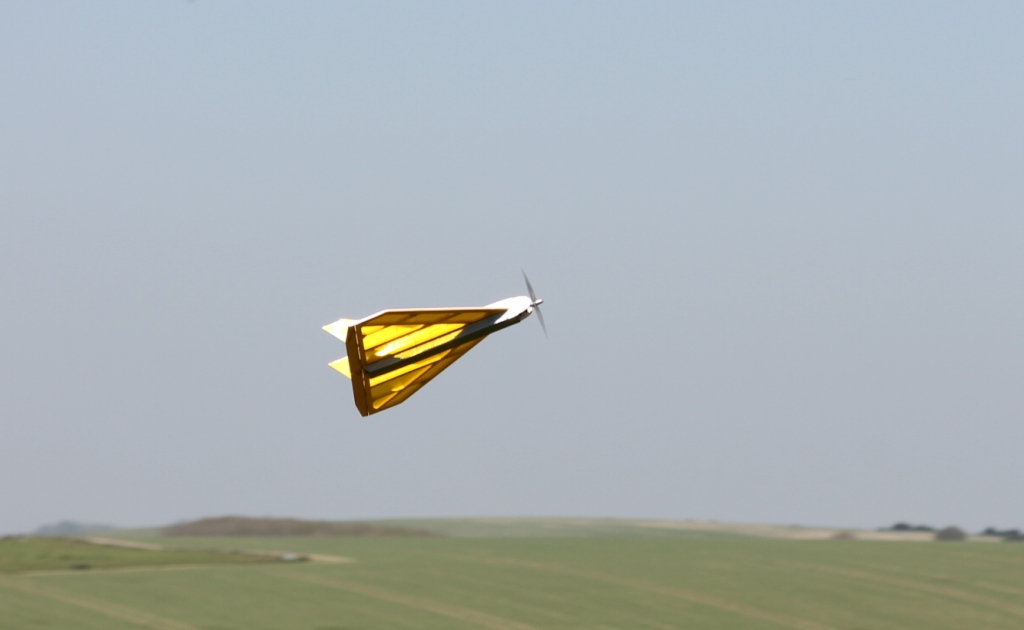
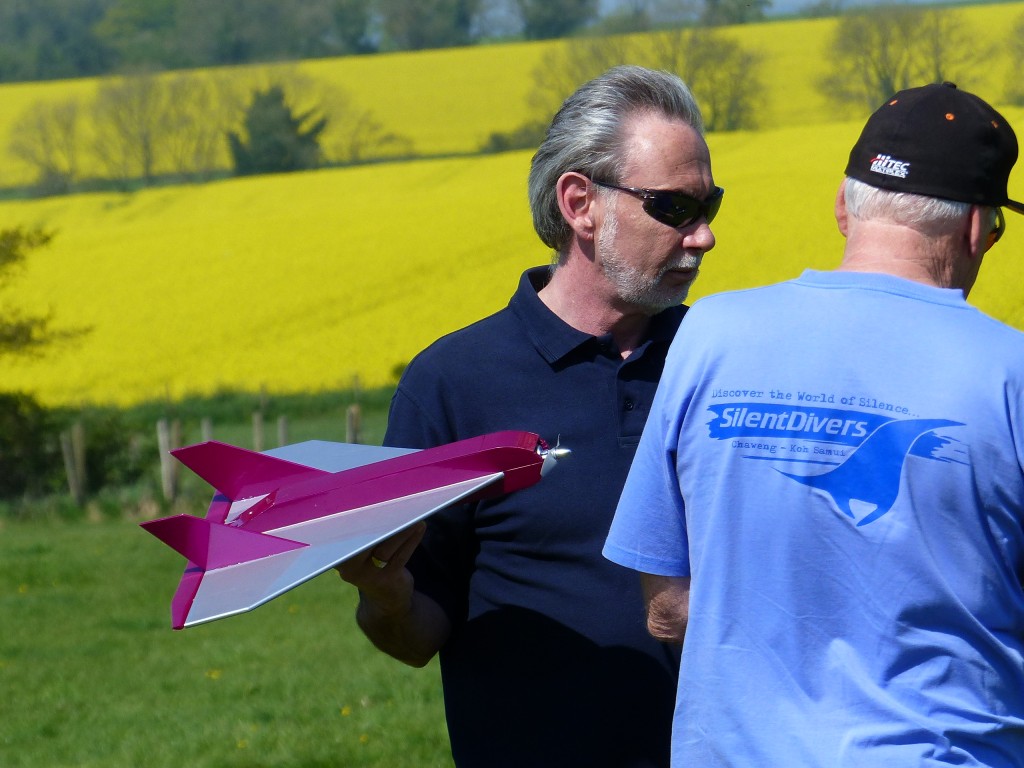
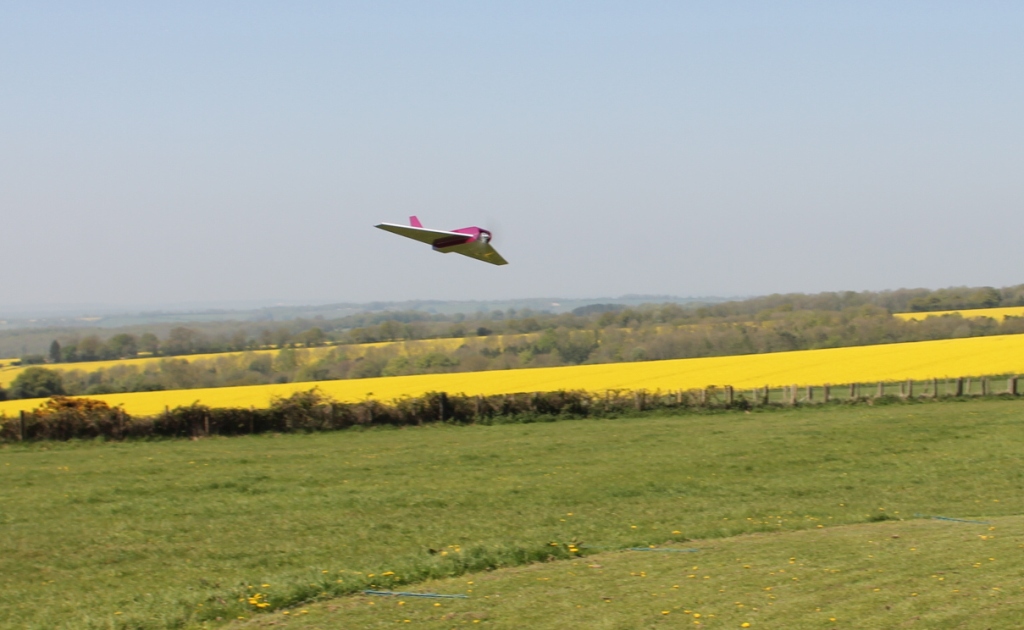
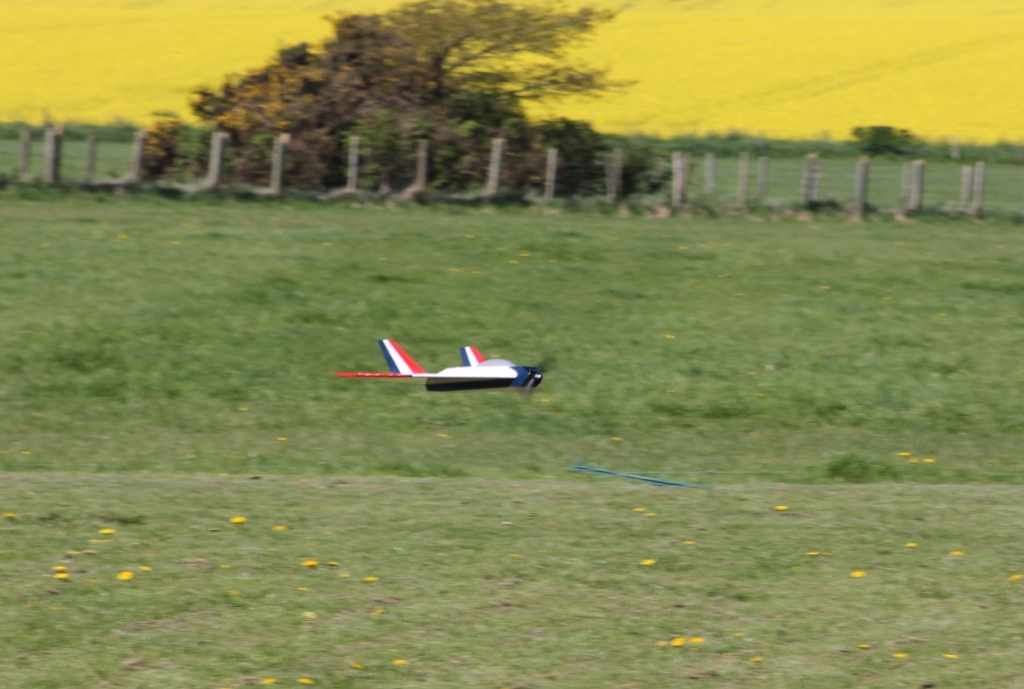

Time now for the video:
Please watch the video full screen, it’s so much better with small models flying around. If the video won’t play for you CLICK HERE
Both optimists and pessimists contribute to the society. The optimist invents the aeroplane, the pessimist the parachute. — George Bernard Shaw
Colin Cowplain

